
À TOUTE VAPEUR
FULL STEAM AHEAD
MIT VOLLDAMPF VORAUS








À TOUTE VAPEUR
FULL STEAM AHEAD
MIT VOLLDAMPF VORAUS













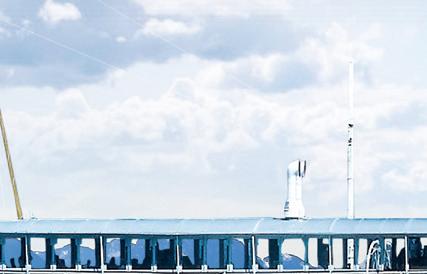
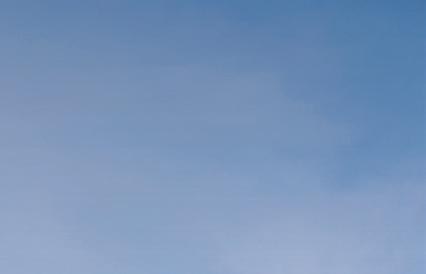
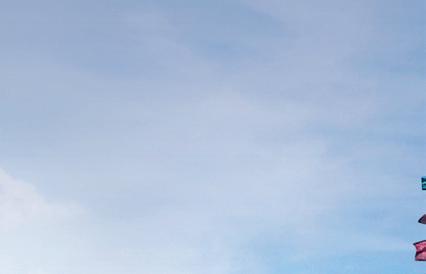


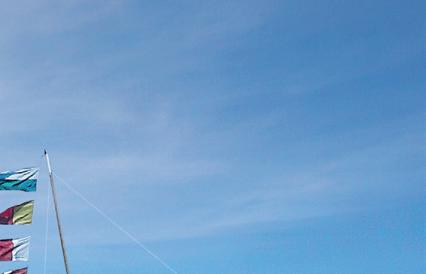
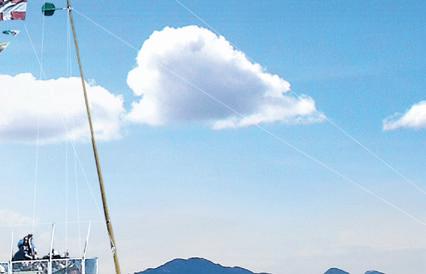

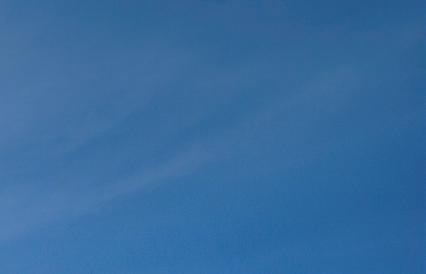

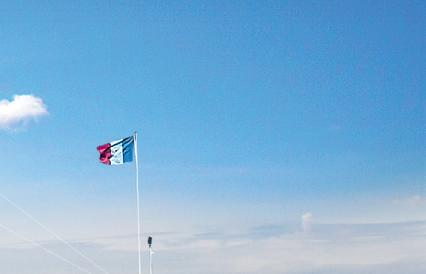





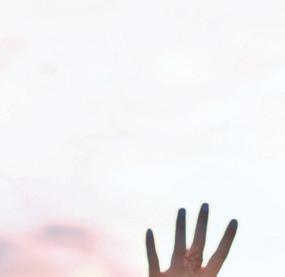











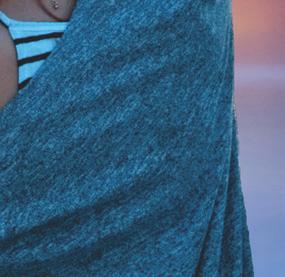



éditorial editorial

Chères lectrices, chers lecteurs,
Voici venu le moment de vous installer confortablement dans un endroit agréable le temps d’une pause bien méritée. En effet, ce magazine va vous faire voyager tout autour du beau lac Léman et va vous donner une envie folle de monter à bord de l’un des fabuleux bateaux Belle Epoque de la Compagnie générale de navigation (si ce n’est pas déjà le cas en ce moment)! Cette édition vous présentera ces huit bateaux historiques, véritables joyaux du lac, dont le Rhône, qui sera entièrement restauré à partir de ce printemps. Nous plongerons dans les coulisses du chantier naval de la CGN et découvrirons l’histoire de la mythique Fête des Vignerons de Vevey. Nous nous pencherons également sur les conséquences des changements climatiques sur le Léman et ferons le tour des îles du lac.
Enfin, l’agenda vous présentera tous les événements de l’année 2019 à ne pas manquer! ✵


ÉVELYNE CHEVALLAZ BELOTTI
RÉDACTRICE
Dear readers,
It’s time to settle down somewhere comfortable and enjoy a well-earned break. This magazine will take you on a journey around the stunning scenery of Lake Geneva and almost certainly give you a mad desire to hop aboard one of the magnificent Belle Epoque boats of the Compagnie générale de navigation (if you aren’t already relaxing on one this very instant)!
This edition will present the eight historical boats, genuine jewels of the lake, with the Rhône scheduled for a general overhaul starting in the spring. We will dive behind the scenes of the CGN shipyard and discover the history of the legendary Fête des Vignerons in Vevey. We will also take a look at the consequences of climate change on Lake Geneva before visiting the islands scattered around the lake. Finally, the agenda will provide an overview of all the not-to-be-missed events in 2019! ✵
Liebe Leserinnen, liebe Leser,
Der Moment ist für Sie gekommen, sich an einem angenehmen Ort eine wohlverdiente Pause zu gönnen. Mit unserem Magazin reisen Sie auf dem schönen Lac Léman und möchten dabei sicher die prächtigen Belle Epoque – Schaufelraschiffe der CGN (Compagnie générale de navigation) entdecken (wenn dies nicht schon jetzt der Fall ist)!
In dieser Ausgabe werden die acht historischen Schiffe beschrieben, unbestreitbare Juwelen des Sees und insbesondere der Dampfer D/S Rhône, der sich seit dem Frühling in einer Totalrenovation befindet. Wir schauen hinter die Kulissen der CGN – Werft in Lausanne und erwähnen die Geschichte der legendären und epochalen Fête des Vignerons (Winzerfest) in Vevey. Wir interessieren uns auch für die Folgen des Klimawandels für den Lac Léman und ermöglichen Ihnen, die Inseln des Sees zu entdecken.
Sie finden in unserem Magazin zudem die vollständige Agenda der nicht zu verpassenden Fahrplan- und Themenfahrten und insbesondere der Belle Epoque – Flotte der CGN. ✵
EN CHEF, COORDINATRICE GÉNÉRALE DE L’ABVL EDITOR IN CHIEF, OVERALL COORDINATOR ABVL
CHEFREDAKTORIN, GENERALKOORDINATORIN ABVL



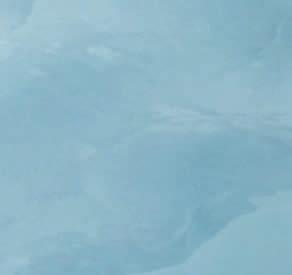

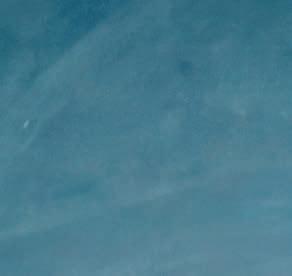






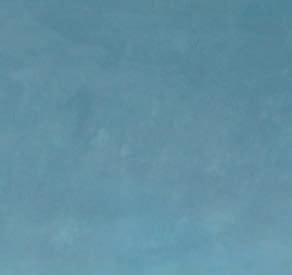





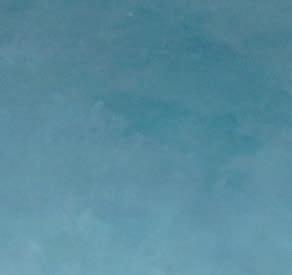

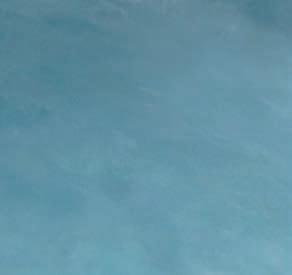
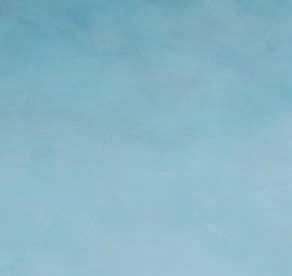

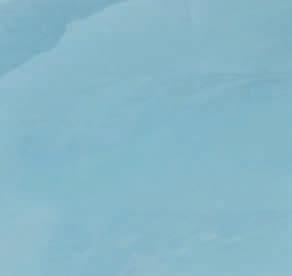


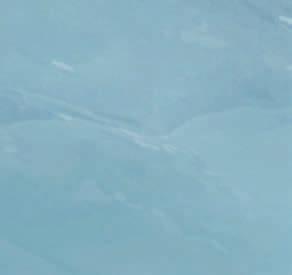

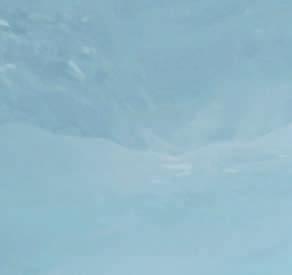








































Comme beaucoup d’autres glaciers et régions arctiques, le Langgletscher, situé dans le Lötschental en Valais, est fortement menacé par les changements climatiques. Notre vie et les paysages qui nous entourent sont de plus en plus influencés par la montée des températures. Veillons à transmettre à nos enfants une nature intacte. Mobilisons-nous pour la préservation du climat.
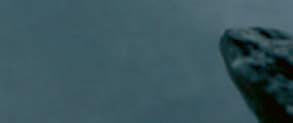





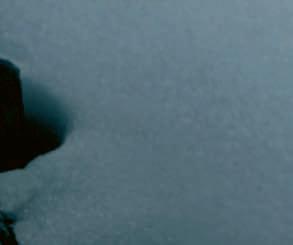



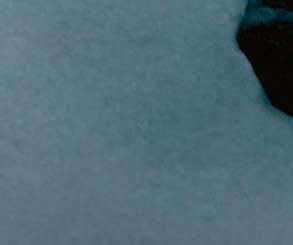





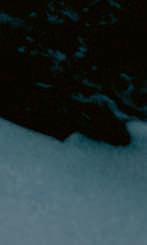
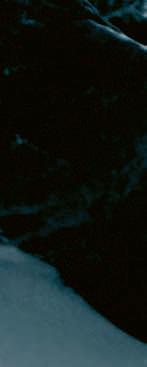




Monter sur un bateau Belle Epoque sur le Léman, c’est entrer de plain-pied dans un véritable monument. Par sa taille, par la qualité de sa conservation et par son homogénéité, cette flotte est aujourd’hui la plus importante au monde. Ce patrimoine a l’exceptionnelle caractéristique d’être vivant et en mouvement, puisqu’il compte pas moins de six bateaux qui circulent et assurent les courses prévues à l’horaire cette année. La rénovation du Rhône, dernier bateau à roues à aubes à vapeur intégralement construit en Suisse, démarre en mai. La CGN se verra ainsi assurée, dès 2021, de pouvoir disposer d’une flotte suffisante pour garantir pratiquement l’ensemble des courses touristiques avec des bateaux Belle Epoque en haute saison et, surtout, pour offrir aux passagers qui les empruntent une plongée dans l’histoire. Les boiseries des salons, les machines à vapeur, les ornements extérieurs sont soigneusement entretenus grâce à des savoir-faire de pointe afin qu’ils demeurent au plus proche de leur aspect d’origine. Le hasard veut d’ailleurs que le Rhône ait été mis en service, en 1927, à l’occasion d’une manifestation très particulière: la Fête des Vignerons. Cet événement, dont les origines remontent au XVIIe siècle, se déroule une fois par génération à Vevey. Première pratique culturelle historique reconnue par l’Unesco en Suisse, elle prend place à nouveau en 2019. Tout comme la CGN, qui en est un partenaire engagé, la Fête incarne la continuité des traditions dans la région lémanique, et contribue à rappeler l’importance, dans notre société mondialisée, de conserver un rapport au passé et donc à nos racines.
En empruntant les lignes de la CGN, vous contribuez donc à faire vivre la pratique plusieurs fois centenaire du transport et de la navigation de plaisance sur le Léman. Nous mettons tout en œuvre pour que l’accueil à bord, l’offre gastronomique et la diversité des croisières proposées s’allient à la beauté des paysages et à celle des bateaux pour vous procurer une expérience riche et mémorable. Nous vous souhaitons de très agréables moments à bord de la flotte Belle Epoque et de nos autres navires sur le Lac Léman. ✵
Vous avez une remarque, une question ou une proposition à nous faire concernant le magazine ou un autre sujet?
N’hésitez pas à nous contacter par e-mail à info@cgn.ch ou par courrier à CGN, Avenue de Rhodanie 17, CP 390, 1001 Lausanne. Nous nous réjouissons de votre prise de contact!

Climbing aboard a Belle Epoque boat on Lake Geneva is like stepping into a veritable monument. In terms of size, the quality of its conservation and its uniformity, this fleet is now the most important anywhere in the world. This heritage has the quite amazing characteristic of being a living, moving thing as no fewer than six boats operate on the lake this year, providing both a regular service and private cruises. Renovation work on the Rhône, the last steam-powered paddle-wheeler built entirely in Switzerland, will begin in May. From 2021, the CGN will therefore have a sufficiently large fleet to operate almost all its peak-season tourist services with Belle Epoque boats and, more particularly, to offer the passengers aboard a journey back in time. The wood panelling in the salons, the steam engines and the external fittings are carefully maintained thanks to cuttingedge know-how so that they remain as faithful as possible to their original appearance.
By coincidence, the Rhône was brought into service in 1927 on the occasion of a unique event: the Fête des Vignerons. This event, dating back to the 17th century, is held once a generation in Vevey. The first historical cultural practice recognised by UNESCO in Switzerland, it will take place once again in 2019. Like the CGN, which is a dedicated partner of the event, the Fête des Vignerons embodies the continuity of traditions in the region around the lake and, in our globalised society, serves to reiterate the importance of maintaining a link to the past and thus to our roots. By sailing with the CGN, you too play your part in keeping this centuries-old practice of shipping and recreational sailing on Lake Geneva alive and well. We make every effort to ensure that the welcome on-board, the culinary fare and the diversity of routes on offer combine the beauty of the landscape with that of the boats to offer you a rewarding and unforgettable experience.
We hope you enjoy your time aboard the vessels of the Belle Epoque fleet and our other boats operating on Lake Geneva. ✵
Do you have a remark, a question or a proposal for us concerning the magazine or any other topic?
Please do not hesitate to contact us by e-mail at info@cgn.ch or by letter at CGN, Avenue de Rhodanie 17, CP 390, 1001 Lausanne. We are looking forward to hearing from you!

BENOÎT GAILLARD
PRÉSIDENT DU CONSEIL D’ADMINISTRATION, GROUPE CGN SA
CHAIRMAN OF THE BOARD OF DIRECTORS, CGN GROUP LTD
VERWALTUNGSRATSPRÄSIDENT, CGN GRUPPE AG
Ein
Steigt man an Bord eines unserer Belle Epoque - Schiffe ein, so betritt man ein historisches Monument aber auch eines, das lebt. Durch ihre Grösse, die Qualität ihrer Konservierung und durch ihre Homogenität handelt es sich um die weltweit wichtigste Flotte dieser Art. Sechs Schiffe sind 2019 im Fahrplan eingesetzt. Die Vollrenovation von D/S Rhône, der letzte Schaufelraddampfer, der in der Schweiz gebaut wurde, beginnt im Mai und endet im Frühling 2021. Die CGN kann dann damit in der Hochsaison ihr gesamtes Angebot an längeren touristischen Kursfahrten mit sogar sieben einzigartigen historischen Schiffen durchführen. Ihr Unterhalt wird Spitzenfachleuten anvertraut, die besorgt sind, die Authentizität des Originalzustandes zu respektieren oder wiederherzustellen. D/S Rhône wurde 1927 für das denkwürdige Fête des Vignerons in Vevey eingeweiht, das einmal pro Generation und nun 2019 zum zwölften Mal stattfindet. Das Winzerfest hat seinen Ursprung im XVII. Jh und wurde für die Schweiz von der UNESCO als erstes immaterielles Weltkulturerbe anerkannt. Es bezeugt, mit der CGN als Partnerin, dass die Traditionen am Lac Léman hochgehalten und in der Zeit der Globalisierung der Bezug zu unserer Geschichte und zu unseren Wurzeln weitergepflegt werden.
Als Gast der CGN erlauben Sie es uns, den mehrere hundert Jahre alten Personentransport und die damit auch verbundene Vergnügungsschifffahrt auf dem Genfersee weiterleben zu lassen. Wir tun alles daran, Ihnen mit dem Empfang an Bord, dem gastronomischen Angebot und der Vielfalt der verschiedenen Rundfahrten, zusammen mit der Schönheit der vorbeiziehenden Landschaft sowie unserer Schiffe, ein reichhaltiges und unvergessliches Erlebnis zu ermöglichen.
Wir wünschen Ihnen sehr angenehme Stunden an Bord der Belle Epoque – und auch der anderen Schiffen der CGN. ✵
Haben Sie Bemerkungen oder Vorschläge über unser Magazin oder auch über andere Themen, lassen Sie es uns bitte wissen.
Untenstehend finden Sie die Kontakte.
E-mail: info@cgn.ch
Adresse: CGN, Avenue de Rhodanie 17, CP 390, 1001 Lausanne.
Ihre Meinung interessiert uns sehr!



VEYTAUX – MONTREUX, SUISSE
# cha t eauchillon
# chillon

ww w.chillon .ch


Situé au coeur de La Côte, sur les magnifiques rives de la ville de Rolle, notre Gastropub le Blackbird House a pour but que vous passiez un moment relaxant dans un cadre familial tout en profitant d’un bon repas décontracté.
Nous vous proposons un menu simple mais innovant que cela soit pour le brunch, le diner ou votre repas du soir, avec une attention pour chacun – de nos fameux pancakes, breakfast burritos et burgers gourmets, jusqu’à nos alléchantes salades Blackbird tout en passant par nos coups de cœur classiques comme notre curry Tikka Tikka et Fish&Chips Blackbird.
Nous offrons de superbes offres les midis ainsi qu’un large menu enfant.
Notre bar regorge exclusivement de bières artisanales brassées par nos amis de Dr. Gabs et nos vins proviennent en partie des vignes de Mont-sur-Rolle et des villages des alentours.
Notre maison est votre maison, donc n’hésitez plus et venez profiter du Blackbird House Gastropub comme si vous étiez chez vous!
Blackbird House Gastropub – Grande-Rue 71 – 1180 Rolle Tél. 021 826 10 84 – www.blackbirdhouse.ch

À TOUTE VAPEUR FULL STEAM AHEAD MIT VOLLDAMPF VORAUS
Le magazine des Amis des bateaux à vapeur du Léman et de la CGN
COORDINATION/ COORDINATION
Elodie Maître-Arnaud, Inédit Publications SA
DIRECTEUR ARTISTIQUE/ ART DIRECTOR
Xavier Cerdá, Inédit Publications SA
RÉDACTEURS/
EDITORS
Mélanie Blanc
CGN
Evelyne Chevallaz Belotti
Maurice Decoppet
Joëlle Loretan
Thomas Pfefferlé
Sylvie Ulmann
TRADUCTIONS/ TRANSLATIONS
Apostroph (english)
Maurice Decoppet (Deutsch)
CORRECTIONS
Corinne Grandjean et Adeline Vanoverbeke (français) Inédit Publications SA
PUBLICITÉ/ ADVERTORIAL
Delphine Foiret
Inédit Publications SA Avenue de Rumine 37 Case postale 900 1001 Lausanne
Tél. 021 695 95 95
TIRAGE/ NUMBER OF COPIES
25 000 exemplaires
IMPRIMERIE/ PRINTER
PCL Presses Centrales SA Avenue de Longemalle 9 1020 Renens
Tél. 021 317 51 51
PHOTO DE COUVERTURE/ FRONT COVER Jacques Straessle N° 9


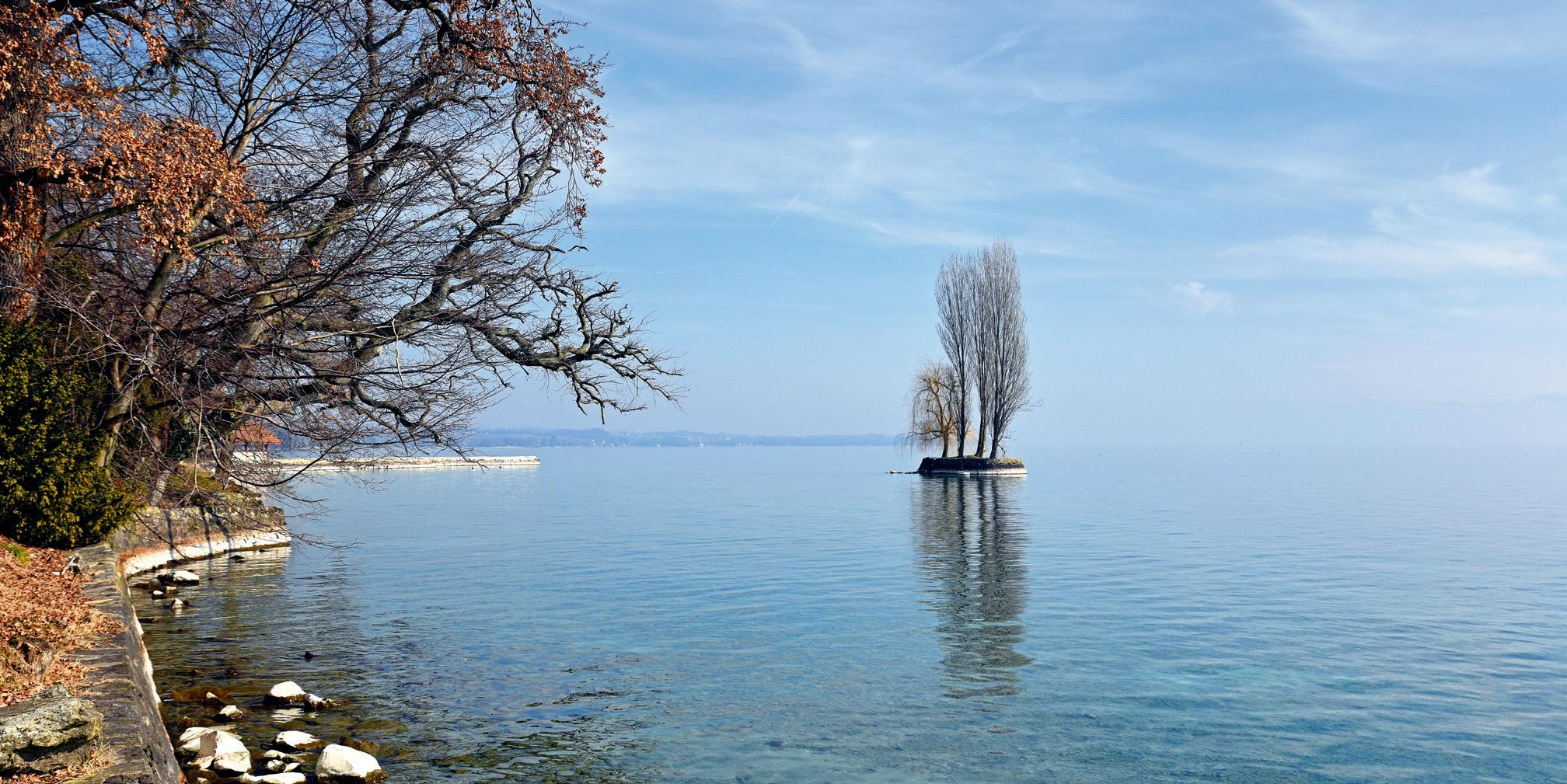
ABVL
L’Association des amis des bateaux à vapeur du Léman (ABVL)
The Association Friends of the Steamboats on Lake Geneva (ABVL) 32
L’ABVL a besoin de vous!
The ABVL needs your help! 33
Rejoignez l’ABVL !
Join the ABVL ! 35
OFFRES COMBINÉES / PACKAGES
Croisières et découvertes
Cruise and discover 37
INTERVIEW
Irwin Gafner
«L’esprit familial de la CGN me plaît»
“I like the family spirit of the CGN” 38
REPORTAGE
Chantier naval de la CGN Cap sur l’avenir
CGN’S Shipyard
Setting a course for the future 42
TOUR DU LAC / LAKE TOUR
Les îles du Léman
Islands of Lake Geneva 50

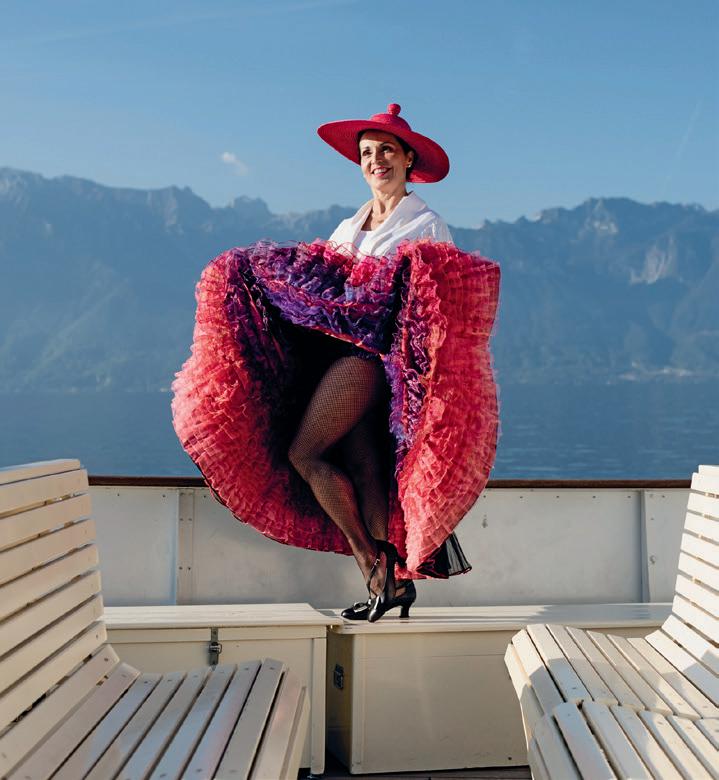

ENVIRONNEMENT / ENVIRONMENT
Lac Léman et climat
Dix points à retenir Lake Geneva and the climate 10
ÉVÉNEMENT / EVENT
Fête des Vignerons 2019
L’événement d’une génération
A once in-a-generation event 62
JEUX / GAMES
Fun time!
Jeu des sept différences Catch the differences 71
AGENDA
Evénements et croisières à thème Parade navale 2019 Naval parade 2019 72
De janvier à décembre
From January to December 73
INDEX ALPHABÉTIQUE /



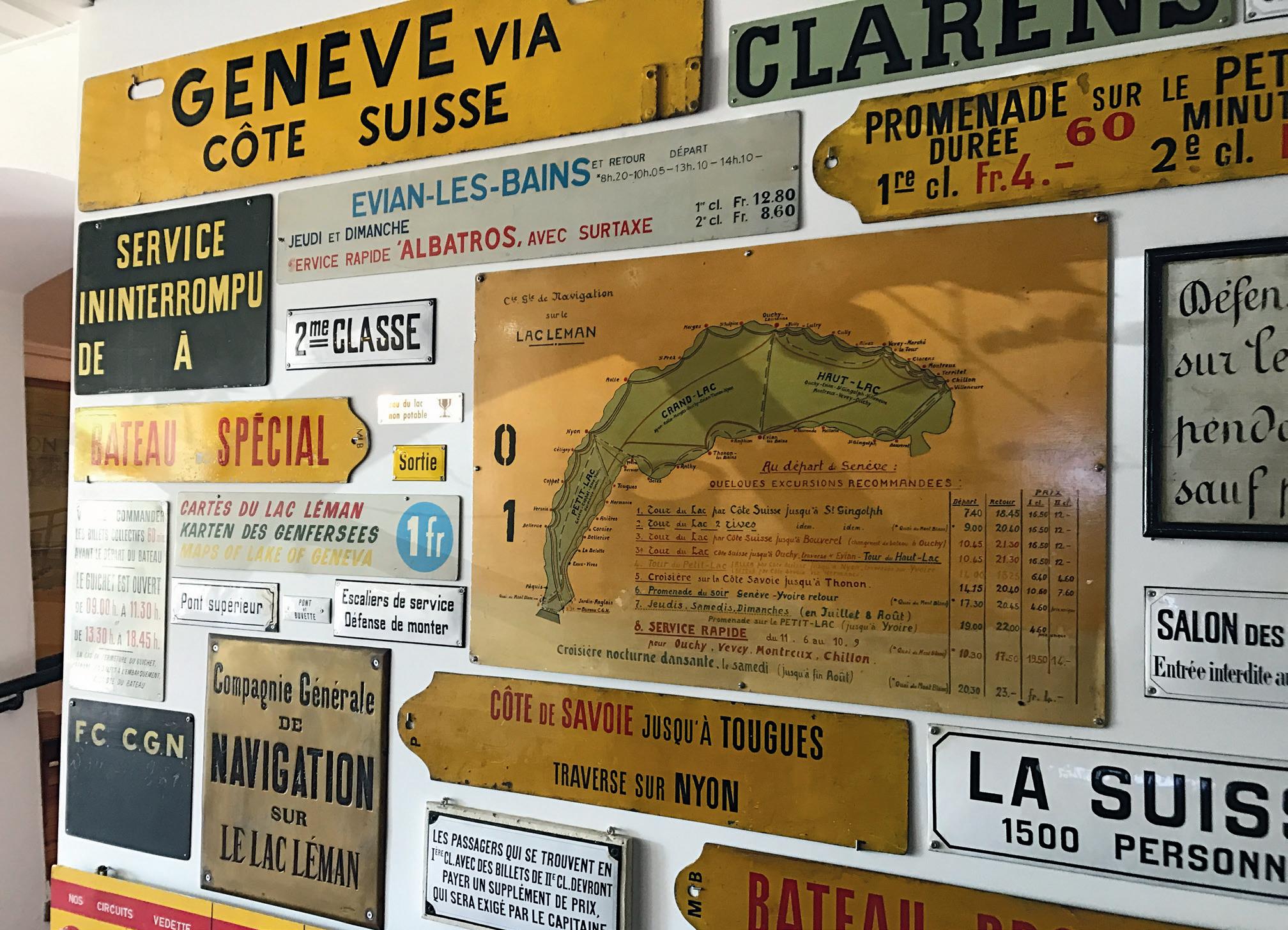
La CGN a remis officiellement, le 21 août 2018, ses archives et collections au Musée du Léman, où elles se trouvaient déjà jusque-là, mais sous forme de prêt. Sur les 14 000 objets faisant partie des collections du musée, plus de 1400 sont en lien direct avec l’histoire des bateaux à vapeur et la CGN. Si actuellement trois salles lui sont déjà entièrement dédiées, ce nombre doublera dans le cadre du projet d’extension du musée. Outre plusieurs milliers de documents administratifs, allant des statuts aux procès-verbaux, règlements et correspondances, la CGN a apporté plus de 200 objets racontant l’histoire de la compagnie: une partie de la machine à vapeur de l’Helvétie, cloches, hublots, porte-voix, panneaux de boiseries des salons, affiches, manches à air, pièces de timonerie, registres du personnel, ancres ou bouées de sauvetage. La collaboration entre la CGN et le musée s’est développée ces vingt dernières années, les archives et les expertises du musée ayant contribué à la restauration des unités historiques de la compagnie. ✵ www.museeduleman.ch
The archives of the CGN entrusted to the Musée du Léman
On 21 August 2018, the CGN officially handed over its archives and collections to the Musée du Léman, where they had been residing for some time on a loan basis. Of the 14,000 objects in the museum’s collections, more than 1,400 are directly linked to the history of the CGN steamboats.While three rooms are currently dedicated to the CGN, this number will be doubled as part of the museum’s extension. In addition to several thousand administrative documents, ranging from articles of association to minutes of meetings, regulations and correspondence, the CGN has provided more than 200 objects telling the story of the company: part of the steam engine from the Helvétie, bells, portholes, megaphones, wood panelling from the lounges, posters, air vents, wheelhouse parts, personnel registers, anchors and life belts. Collaboration between the CGN and the museum has intensified over the past twenty years, with the museum’s archives and expertise contributing to the restoration of the company’s historic assets. ✵
www.museeduleman.ch








































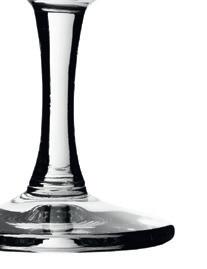

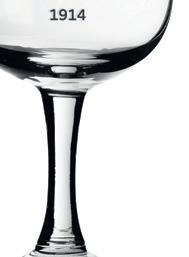




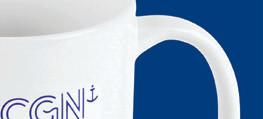





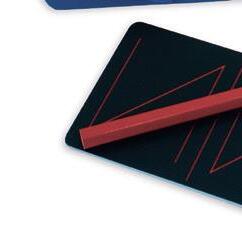
VERRES
BELLE ÉPOQUE


BELLE EPOQUE GLASSES
CHF 10.– LE VERRE



CASQUETTE
KIT OBJECTIF
POUR SMARTPHONE LENS’ KIT FOR SMARTPHONE





CHF 12.-

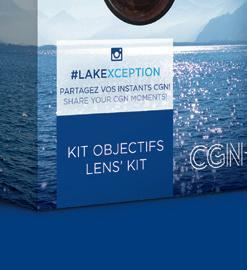









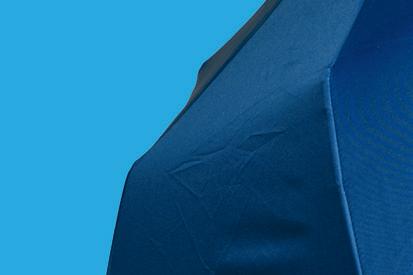
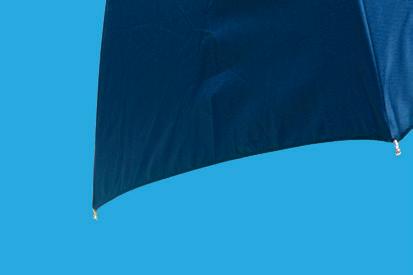
LIVRE « LES BATEAUX DE LA CGN » FLEET HISTORICAL BOOK






CHF 39.MAGNET
PLAQUE VINTAGE VINTAGE SIGN
CHF 5.-
CHF 10.AFFICHE VINTAGE VINTAGE POSTER
LUNETTES DE SOLEIL SUNGLASSES
CARTE POSTALE POSTCARD
CHF 5.-
CHF 18.-
CHF 2.-
CGN.CH




CHF 10.–




CHF 15.-

RETROUVEZ TOUS LES OBJETS DE LA BOUTIQUE À BORD, AUX GUICHETS OU SUR FIND ALL THE OBJECTS ON BOARD, AT OUR TICKET OFFICE OR ON



Nous accompagnons les paraplégiques. À vie.
Les victimes bénéficient de notre réseau de prestations unique: des soins médicaux compétents, une prise en charge et une rééducation professionnelles, ainsi qu’un accompagnement compréhensif – jusqu’à un âge avancé. www.paraplegie.ch
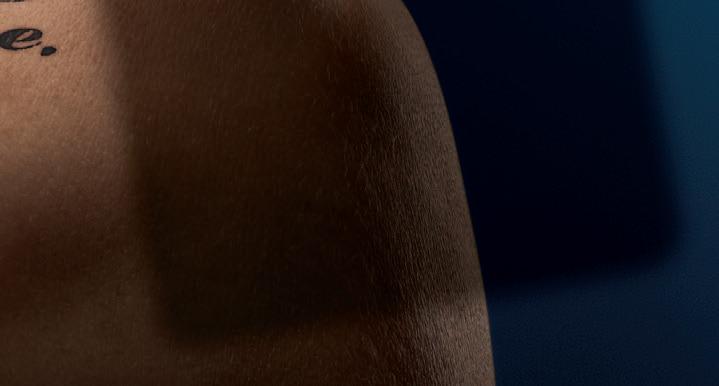


Dans le cadre du développement du nombre de clients en provenance de l’Asie et pour mieux répondre aux attentes de la clientèle indienne, Eldora Traiteur a conclu une collaboration avec l’Auberge de la Crochettaz, à Epesses, qui est un des meilleurs restaurants indiens de la région et dont la réputation n’est pas à faire.
Pour la saison 2019, la CGN pourra ainsi proposer aux groupes en provenance de l’Inde une offre culinaire qui répond au mieux à leurs attentes. La restauration indienne sera également disponible pour des événements MICE (Meetings et Incentives) et pour des locations de bateaux, dont le nombre de demandes en provenance de l’Inde est également en constante augmentation. ✵
In an attempt to develop the number of customers from Asia and to meet the expectations of our Indian clientele, Eldora Traiteur has signed an agreement with the Auberge Crochettaz in Epesses, which is one of the best Indian restaurants in the region and a firm favourite with many restaurant-goers. For the 2019 season, the CGN can thus offer groups from India a selection of dishes that better satisfies their expectations. Indian fare will also be available for MICE events (meetings and incentives) for boat rental, with its constantly increasing demand from India. ✵

Le prix a été remis le 12 novembre 2018 au président de CGN Belle Epoque SA, M. Maurice Decoppet ici sur la photo avec M. Didier Zuchuat, vice-président de l’Association Patrimoine du Léman et responsable du centre de documentation du Musée du Léman, à Nyon.
The prize was presented on 12 November 2018 to the Chairman of CGN Belle Epoque SA, Mr Maurice Decoppet, seen here with Mr Didier Zuchuat, Vice-President of the Association Patrimoine du Léman and Director of Documentation at the Musée du Léman, in Nyon.
Le titre de «Restaurant historique de l’année 2019» décerné aux salons de la flotte Belle Epoque de la CGN!
Le jury de l’ICOMOS (International Council on Monuments and Sites, association internationale active dans la conservation du patrimoine) a récompensé la CGN en reconnaissance des travaux de restauration et de rénovation effectués au cours des vingt dernières années sur l’ensemble de l’équipement des salons de 1re classe de la flotte Belle Epoque du lac Léman. ✵
The title of "Historic Restaurant of the Year 2019" awarded to the lounges of the CGN Belle Epoque fleet!
The jury of ICOMOS (International Council on Monuments and Sites, an international association active in the field of heritage conservation) has rewarded the CGN for the restoration and renovation work it has carried out over the past twenty years on the equipment in the first class lounges of the Belle Epoque fleet on Lake Geneva. ✵
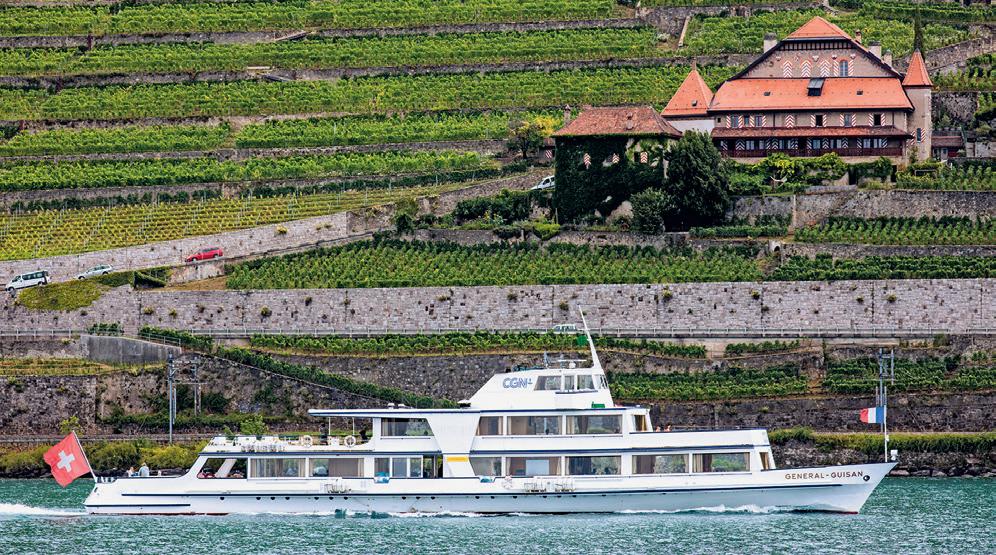
Contemplez les célèbres vignobles en terrasses de Lavaux, inscrits au Patrimoine mondial de l’Unesco, tout en dégustant le vin de la région, accompagné d’une délicieuse assiette de produits du terroir. ✵
Admire the famous terraced vineyards of Lavaux – included on the UNESCO world heritage list – while tasting regional wine accompanied by a delicious plate of local products. ✵ www.cgn.ch
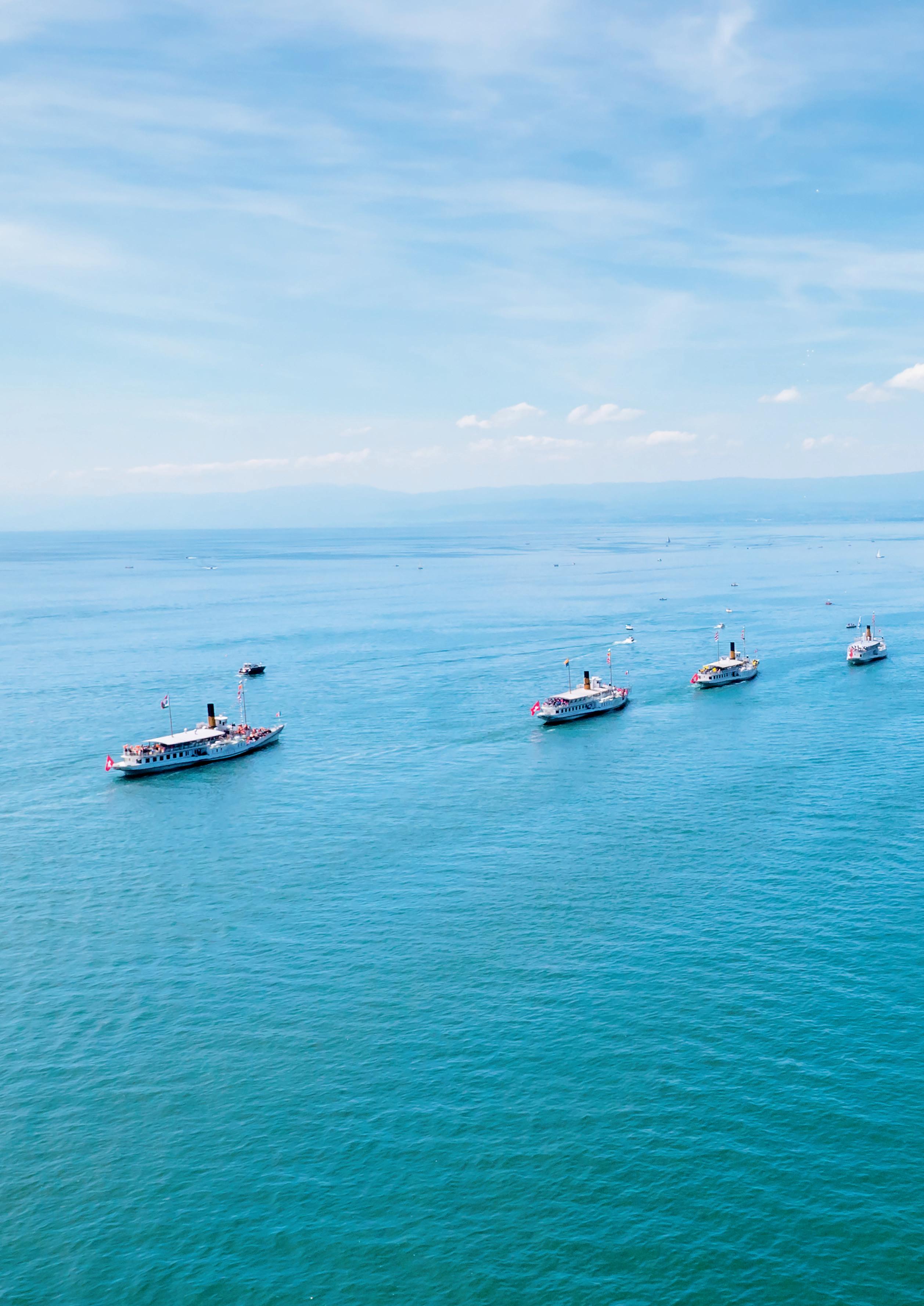

INTRODUCTION TO THE EIGHT SHIPS AND THEIR HISTORY
TEXTES / TEXTS: MAURICE DECOPPET

Vapeur / Steamer
Vétéran de la flotte, le Montreux est équipé d’une machine à vapeur récente (2001), télécommandée par le capitaine sans intervention du mécanicien – une première mondiale!
Veteran of the fleet, the Montreux is equipped with a modern steam engine (2001), remote controlled by the captain and without intervention of a mechanic – a world first !

Diesel-électrique / Diesel-electric
Vapeur à l’origine, équipé en diesel-électrique depuis 1955. Rénovation complète en 2013. Le Vevey permet d’offrir des croisières Belle Epoque toute l’année.
Originally a steamer, the boat was converted to diesel-electric propulsion in 1955. Completely renovated in 2013, the Vevey offers Belle Epoque cruises all year round.

Diesel-électrique / Diesel-electric
L’Italie est le jumeau du Vevey. Equipé d’une propulsion diesel-électrique en 1958, il a bénéficié d’une rénovation complète entre 2015 et 2016. Comme le Vevey, il permet d’offrir des croisières Belle Epoque toute l’année.
The Italie is the Vevey’s sister-ship. Equipped with diesel-electric propulsion in 1958, it profited from a complete overhaul between 2015 and 2016. As the Vevey, it offers Belle Epoque cruises all year round.
Vapeur / Steamer
Bateau amiral de la flotte CGN, La Suisse a bénéficié, de 2007 à 2009, du plus important projet de rénovation intégrale d’un bateau historique en Europe.

The La Suisse, flagship of the CGN fleet, profited between 2007 and 2009 from the most extensive overhaul of a paddle boat in Europe.




Vapeur / Steamer
Complètement rénové entre 2004 et 2006, le Savoie a conservé sa machine d’origine. Engagé surtout dans le Petit-Lac au départ de Genève.
Completely renovated between 2004 and 2006, the Savoie retained its original steam engine. Operating primarily in the “Petit-Lac” departing from Geneva.
Vapeur / Steamer
Le Simplon possède la machine à vapeur la plus réactive de la flotte. Il a bénéficié de deux rénovations partielles importantes entre 2004 et 2005 et entre 2010 et 2011.
The Simplon has the most responsive steam engine of the fleet. It profited from two extensive partial overhauls 2004-2005 and 2010-2011.
Diesel-électrique / Diesel-electric
Vapeur à l’origine, l’Helvétie est équipé d’une propulsion diesel-électrique depuis 1977. Désarmé, il est en attente du financement d’une rénovation complète.
Originally a steamer, the Helvétie was converted to diesel-electric propulsion in 1977. Decommissioned, it is awaiting the funding for a complete renovation.
Vapeur / Steamer
Le Rhône est le dernier vapeur à roues à aubes construit en Suisse. Il est équipé d’une machine à vapeur à commande hydraulique unique au monde. Rénovation complète prévue en 2019-2020.
The Rhône was the last paddle wheeler built in Switzerland. The boat is equipped with a hydraulically-controlled steam engine, unique in the world. Complete renovation planned for 2019-2020.
LE VÉTÉRAN, AVEC UNE MACHINE À VAPEUR
DATANT DU XXIE SIÈCLE (1904)
Rénovation partielle avec installation d’une propulsion diesel-électrique: 1958-1962
Rénovation générale avec une «revaporisation»: 1998-2001
Capacité actuelle: 560 personnes
Restauration: 172 personnes
Longueur: 68,3 m
Puissance: 650 kW (885 CV)
PARTICULARITÉS
- «Sister-ship» (bateau jumeau) du Général-Dufour construit en 1905, désarmé en 1965 et démoli en 1977.
- Boiseries du salon de 1re classe provenant du bateau Valais démoli en 2003.
- Le plus lourdement transformé de la flotte, mais également le plus ancien.
- Prototype, dans ses formes, des bateaux actuels et, en même temps, dernier témoin des bateaux de type «lourd».
Le Montreux est le vétéran de la flotte Belle Epoque alors même qu’il est équipé de la machine à vapeur la plus récente, soit une machine télécommandée par le capitaine depuis la passerelle et qui fonctionne sans intervention du mécanicien – une première mondiale! L’histoire du bateau a été plutôt mouvementée. Il subit une première grande transformation et rénovation entre 1959 et 1961: installation d’un groupe de propulsion diesel-électrique et profonde métamorphose de sa silhouette. En 1998, à l’occasion de son 125e anniversaire, la CGN se lance dans un ambitieux programme de «revaporisation» des quatre unités historiques qui avaient perdu leur machine à vapeur d’origine au profit d’un groupe diesel-électrique (le Vevey en 1955, l’Italie en 1958, le Montreux donc en 1959 et enfin l’Helvétie en 1977). Le Montreux est le seul qui bénéficiera finalement d’une revaporisation, qui s’accompagnera d’une restauration importante de tous les aménagements intérieurs et d’une rénovation de la coque et des superstructures. Il s’agit, de 1999 à 2001, de la première rénovation complète d’un bateau Belle Epoque de la CGN. ✵
Courses horaires du Montreux
Eté (du 16 juin au 1er septembre): les après-midis, croisière de Lausanne-Ouchy à Chillon et retour. Les soirs, croisière gourmet Beau-Rivage Palace, de Lausanne-Ouchy à Yvoire et retour (petite restauration, uniquement les dimanches et lundis).
THE VETERAN, EQUIPPED WITH A 21st CENTURY STEAM ENGINE (1904)
Partial overhaul with the installation of a diesel-electric propulsion plant: 1958-1962
Complete overhaul with a reconversion to steam: 1998-2001
Capacity: 560 passengers
Foodservice: 172 persons
Length: 68.3 m
Power: 650 kW (885 HP)
CHARACTERISTICS
- Sister ship of the Général-Dufour (built in 1905, decommissioned in 1965 and broken up in 1977).
- Woodwork of the 1st class salon from the Valais (dismantled in 2003).
- The most extensive transformation of any boat of the fleet, but then it was also the oldest.
- Prototype, as far as the shape is concerned, of the current boats and, at the same time, the last remaining witness of “heavy” type boats.
The Montreux is the veteran of the Belle Epoque fleet, even though it is equipped with the most modern steam engine: remotely-controlled from the bridge by the captain and functioning without the need for a mechanic – a world first!
The history of the ship is rather eventful: it was subjected to a major overhaul between 1959 and 1961, which consisted in the re-motorization with a diesel-electric power plant and a radical change of its silhouette. On the occasion of the CGN’s 125th anniversary, the company launched an ambitious program to re-equip four of the historic boats, which had lost their original steam engines in favor of diesel-electric power, with steam power. These were the Vevey in 1955, the Italie in 1958, the Montreux, as mentioned, in 1959, and finally the Helvetie in 1977. The program was a bit too ambitious and finally only the Montreux profited from a reconversion, accompanied by a major renovation of the hull, the superstructure, and the interiors. This was the first complete overhaul from 1999 to 2001 and a return to its original state of a Belle Epoque boat of the CGN. ✵
Scheduled cruises of the Montreux Summer (from 16 June to 1 September): Afternoons on the Lausanne-Ouchy – Chillon return route and evenings on the Lausanne-Ouchy – Yvoire return route for the Beau-Rivage Palace gourmet cruise (light catering only on Sundays and Mondays).
la flotte the fleet


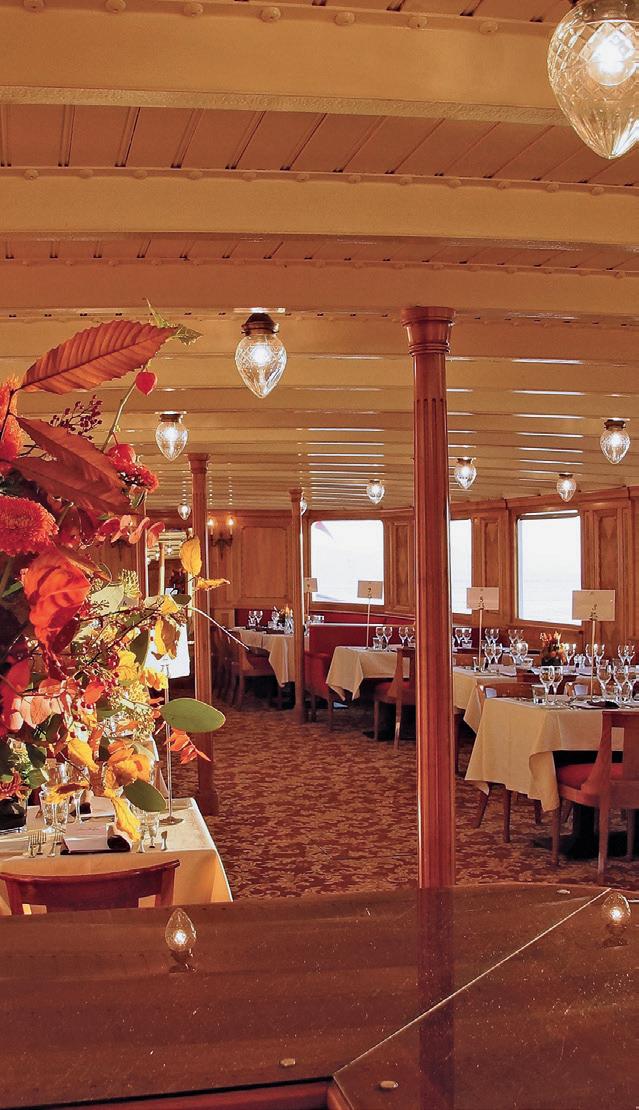
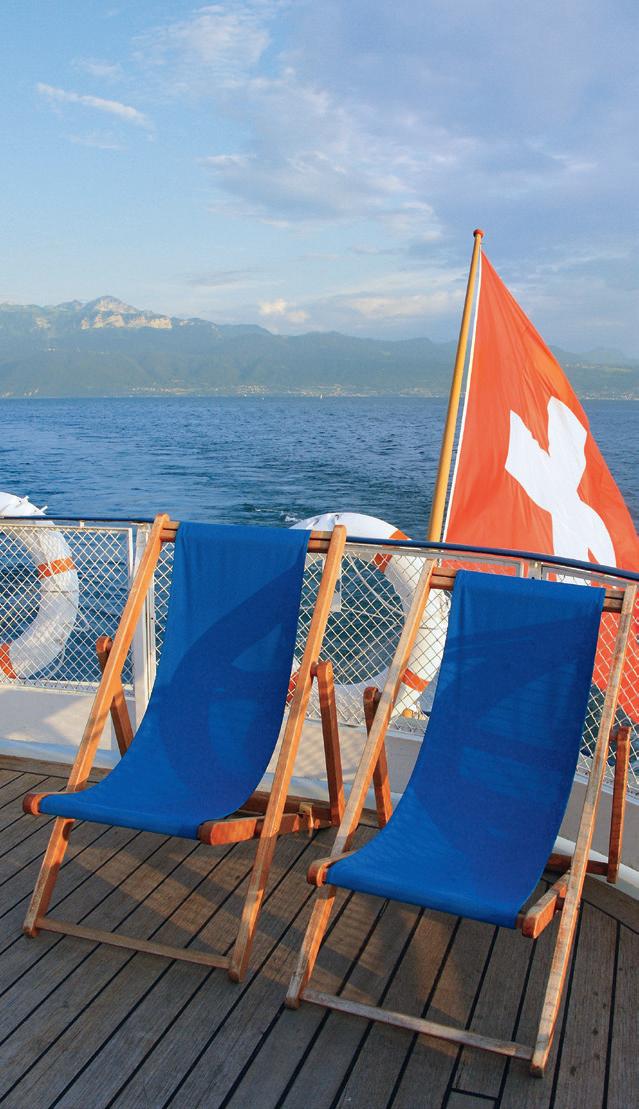
AVEC L’ITALIE, LE BATEAU BELLE ÉPOQUE
À LA POINTE DE L’ÉVOLUTION TECHNOLOGIQUE (1907)
Rénovation partielle avec installation d’une propulsion diesel-électrique: 1953-1955
Rénovation générale: 2012-2013
Capacité: 560 personnes
Restauration: 150 personnes
Longueur: 66 m
Puissance: 540 kW
PARTICULARITÉS
- «Sister-ship» (bateau jumeau) de l’Italie.
- Bateau avec le salon de 1re classe le mieux conservé de la flotte et bénéficiant de la technologie la plus moderne.
- Salon en marronnier incrusté d’amarante et ébène rehaussé de garnitures en bronze ciselé. Reconstitution d’un «fumoir» au pont supérieur devant la cheminée.
Al’origine, le Vevey était équipé d’une machine à vapeur classique de Sulzer Frères, à deux cylindres et à double expansion, une machine fort semblable à celle que l’on trouve aujourd’hui encore sur le Savoie de 1914. En 1955, le type de propulsion vapeur est abandonné en faveur d’un groupe diesel-électrique.
Le Vevey a bénéficié d’une rénovation générale entre mai 2012 et août 2013, l’équipant d’un nouveau type de propulsion diesel-électrique à la pointe de l’évolution technologique. Environ 60 000 heures de travail ont été nécessaires pour lui offrir une nouvelle jeunesse. Grâce aux recherches menées par l’Association Patrimoine du Léman (APL), il a été possible de restaurer les éléments datant des premières années du XXe siècle et de restituer la silhouette originale du bateau. Le système de propulsion diesel-électrique moderne lui permet de naviguer également en hiver, alors que les vapeurs ne sont pas maintenus sous pression en basse saison. ✵
Courses horaires du Vevey
• Eté (du 16 juin au 1er septembre): Lausanne-Ouchy – Yvoire –Genève – Nyon – Yvoire – Lausanne-Ouchy – Montreux –Lausanne, sauf du 18 juillet au 11 août (Fête des Vignerons).
• Durant la Fête des Vignerons (du 18 juillet au 11 août): Genève – Nyon – Yvoire – Lausanne et retour.
• Les vendredis soir: croisières «Perches au large», au départ de Genève (du 18 juillet au 11 août).
• Hiver 2019-2020: les croisières doivent encore être confirmées.
Plus d’informations sur www.cgn.ch et www.abvl.ch (OGS)
TOGETHER WITH THE ITALIE, THE BELLE ÉPOQUE BOAT AT THE TOP OF TECHNOLOGICAL EVOLUTION (1907)
Partial overhaul with the installation of a diesel-electric power plant: 1953-1955
Complete overhaul: 2012-2013
Capacity: 560 passengers
Foodservice: 150 persons
Length: 66 m
Power: 540 kW
CHARACTERISTICS
- Twin of the Italie.
- Boat with the best preserved 1st class salon of the fleet and benefitting from the most modern technology.
- Salon in chestnut, inlaid with amaranth and ebony, set off by chiseled bronze decorations. Reconstruction of a smoking room on the upper deck forward of the chimney.
Originally, the Vevey was equipped with a classic twocylinder double expansion steam engine from Sulzer Brothers, a machine similar to the one in the Savoie of 1914, still going strong. In 1955 steam propulsion was abandoned in favor of a diesel-electric power plant.
The Vevey profited from a general overhaul between May 2012 and August 2013 which included the installation of a new kind of diesel-electric power plant at the top of modern technology. It took more or less 60’000 hours of work in order to offer it a rebirth.Thanks to the research conducted by the Patrimonial Association of the Lake of Geneva (APL), it was possible to find elements dating from the beginning of the 20th century to restore its original silhouette.
The modern diesel electric propulsion also allows it to circulate in the winter, while the steamers are not kept under steam. ✵
Scheduled cruises of the Vevey
• Summer (from 16 June to 1 September): Lausanne-Ouchy –Yvoire – Geneva – Nyon – Yvoire – Lausanne-Ouchy –Montreux – Lausanne-Ouchy, except during the Fête des Vignerons from 18 July to 11 August.
• During the Fête des Vignerons from 18 July to 11 August: Geneva – Nyon – Yvoire – Lausanne-Ouchy and return.
• On Friday evenings: “Perchs fillets” cruise, sailing from Geneva, from 18 July to 11 August.
• Winter 2019-2020: to be confirmed. More information at www.cgn.ch and www.abvl.ch (OGS) in due course.
la flotte the fleet



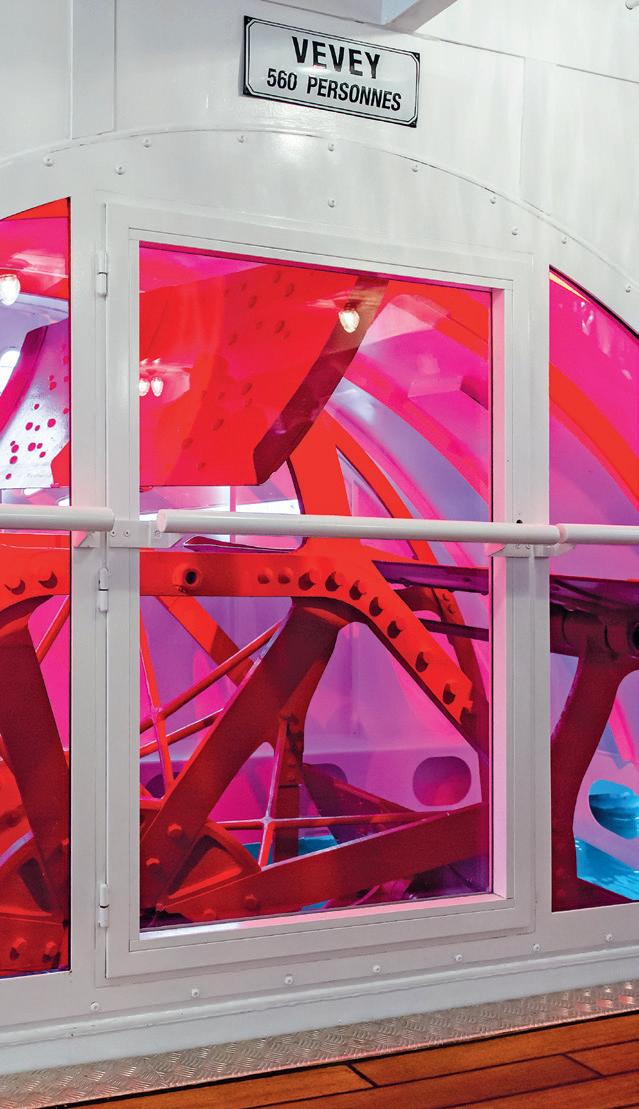
LE BATEAU QUI A PARCOURU LE PLUS DE KILOMÈTRES (1908)
Rénovation générale: 2015-2016
Rénovation partielle avec installation d’une propulsion diesel-électrique: 1955-1958
Capacité: 560 personnes
Restauration: 150 personnes
Longueur: 66 m
Puissance: 540 kW
PARTICULARITÉS
- Jumeau du bateau Vevey.
- Magnifique salon néo-Empire en acajou rehaussé de bronzes dorés.
- Le bateau des lacs suisses qui a parcouru le plus de kilomètres.
Bateau jumeau du Vevey, commandé en 1906 chez Sulzer Frères et mis en service en 1908, l’Italie a reçu son nom en raison des liens plus étroits qui unissaient ce pays au nôtre suite à l’ouverture du tunnel ferroviaire du Simplon Le bateau était équipé à l’origine d’une machine à vapeur classique fort semblable à celle que l’on trouve aujourd’hui encore sur le Savoie. En 1958, le type de propulsion «vapeur» est abandonné en faveur d’un groupe diesel-électrique. Pour les amoureux de la flotte Belle Epoque, il est devenu légendaire, surtout en raison de sa très regrettée course quotidienne translémanique Bouveret-Genève et retour, qu’il a effectuée sans interruption pendant quarante-sept ans, de 1959 à 2005 d’avril à octobre. Désarmé pendant dix ans, l’Italie a bénéficié d’une rénovation complète entre 2015 et 2016, à l’identique du Vevey, en majeure partie grâce aux dons récoltés par l’ABVL. Comme pour le Vevey, les recherches menées par l’Association Patrimoine du Léman (APL) ont permis de restituer l’aspect d’origine du bateau dans son style Belle Epoque. Le bateau a été remis en service en novembre 2016. ✵
Courses horaires de l’Italie
• Printemps (du 14 avril au 15 juin) et automne (du 2 septembre au 20 octobre) «Riviera Tour»: croisière du Haut-lac (Le Bouveret – Saint-Gingolph – Vevey – Montreux –Chillon – Villeneuve – Le Bouveret).
• Eté (du 16 juin au 1er septembre) «Riviera Tour»: croisière du Haut-lac, précédée de la croisière matinale reliant Le Bouveret – Montreux – Vevey – Lausanne – Vevey.
• Du 21 octobre jusqu’à la fin de l’année: consultez les courses horaires du bateau.
Informations: www.cgn ou www.abvl.ch (OGS)
Complete overhaul during the years 2015-2016
Partial renovation with the installation of a diesel-electric power plant: 1955-1958
Capacity: 560 passengers
Foodservice: 150 persons
Length: 66 m
Power: 540 kW
CHARACTERISTICS
- Twin of the Vevey.
- Magnificent mahogany Neo-Empire salon, decorated with gilded bronze fittings.
- Has collected more mileage than any other boat on Swiss lakes.
Twin of the Vevey, the Italie, ordered in 1908 from Sulzer Brothers and put into service in 1908, was baptized to illustrate the even closer ties which united this country and ours as a result of the opening of the Simplon railway tunnel. It was originally equipped with a classic steam engine, very similar to the one still found today on the Savoie. In 1958, steam propulsion was abandonned in favor of a diesel-electric group. For the fans of the Belle Epoque fleet, it became a legend through its daily “translémanique” cruises from Le Bouveret to Geneva without interruption for 47 years from 1959 to 2005. Decommissioned for ten years, the Italie finally was able to profit from a complete renovation between 2015 and 2016, identical to that of the Vevey, thanks in grand part to the donations collected by the ABVL. As for the Vevey, the research conducted by the Patrimonial Association of the Lake of Geneva (APL) permitted the restoration of its original Belle Epoque style.The boat returned to service in November 2016. ✵
Scheduled cruises of the Italie
• Spring (from 14 April to 15 June) and autumn “Riviera Tour” (from 2 September to 20 October): Upper lake (Le Bouveret – Saint-Gingolph – Vevey –Montreux – Chillon – Villeneuve – Le Bouveret)
• Summer (from 16 June to 1 September) “Riviera Tour”: Upper lake preceded by a morning cruise on the Le Bouveret – Montreux – Vevey – Lausanne-Ouchy –Vevey route.
• From 21 October until the end of the year: check the boat’s scheduled sailings
Informations: www.cgn or www.abvl.ch (OGS)
la flotte the fleet
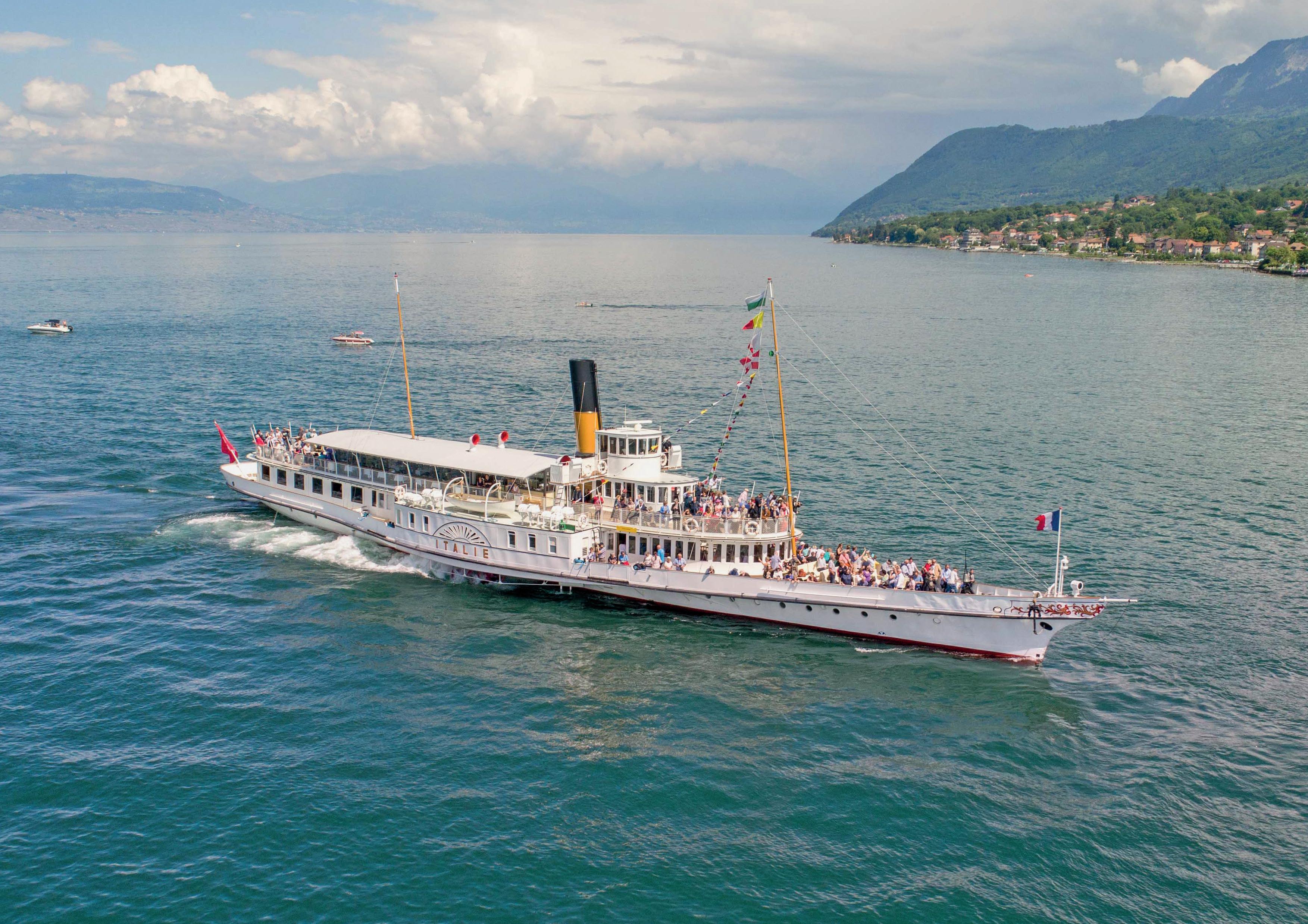



BATEAU «AMIRAL» DE LA CGN (1910)
Rénovation générale: 2007-2009
Capacité actuelle: 850 personnes
Restauration: 252 personnes
Longueur: 78,5 m
Puissance: 1030 kW (1400 CV)
PARTICULARITÉS
- Machine à vapeur la plus ancienne et, avec celle du Simplon, la plus puissante de la flotte.
- Figures de proue et de poupe sculptées et recouvertes à la feuille d’or.
- A la poupe du bateau, canot d’intervention reconstruit selon le modèle d’origine.
La Suisse devient, lors de son lancement le 30 mai 1910, le bateau «amiral» de la flotte CGN, soit le bateau le plus emblématique. Il devait être le plus grand et le plus élégant de tous les bateaux à vapeur du pays, et la CGN choisit pour son salon, parmi cinq projets différents, des ornements sculptés particulièrement élégants, ainsi que des tapis de sol et tapisseries de sièges d’Aubusson.
Le navire a subi, au cours des décennies, plusieurs modifications, tant techniques que structurelles: abandon du charbon et passage à la chauffe à l’huile lourde en 1960 et à l’huile légère en 1999, nouvelle grande chaudière économique, équipée de deux brûleurs, en 1971 (retubée en 2009 et qui est toujours en service). La rénovation de 1971 donne lieu à des modifications pas très heureuses des rotondes du pont principal et surtout du pont supérieur ainsi qu’à l’installation d’une nouvelle timonerie et d’une nouvelle entrée latérale du salon de première classe, toutes deux peu esthétiques.
Entre 2007 et 2009, La Suisse bénéficie d’une rénovation générale, grâce à des fonds privés mis à disposition par l’ABVL et les actionnaires de la CGN. Grâce aux recherches de l’Association Patrimoine du Léman (APL) La Suisse a aussi retrouvé son apparence d’origine, ses figures de proue et de poupe ainsi que son canot d’intervention historique. Il s’agit alors du plus important projet de rénovation complète d’un bateau historique en Europe. ✵
Courses horaires de La Suisse
• Printemps (du 14 avril au 15 juin): Lausanne-Ouchy – Chillon et retour, suivies d’une course du soir Lausanne-Ouchy –Montreux et retour.
• Eté (du 16 juin au 1er septembre): Lausanne – Saint-Gingolph –Le Bouveret et retour, via Chillon – Montreux – Vevey
• Automne (du 2 septembre au 20 octobre): Lausanne-Ouchy –Chillon et retour, suivies d’une course du soir Lausanne-Ouchy –Montreux et retour.
FLAGSHIP OF THE CGN (1910)
Complete overhaul: 2007-2009
Current capacity: 850 passengers
Foodservice: 252 persons
Length: 78.5 m
Power: 1030 kW (1400 HP)
CHARACTERISTICS
- Oldest and, along with the Simplon, equipped with the most powerful steam engine of the fleet.
- Sculptured and gilded figurehead and stern decoration.
- Life boat rebuilt as the original and located at the stern.
On its launching on May 30th, the La Suisse became the flagship, and thus the most emblematic boat, of the fleet. It was intended to be the largest and the most elegant of all the steamboats in the country.Thus it was that the CGN selected from five different projects specially elegant sculpural decorations, as well as Aubusson carpeting and upholstery.
Over the past decades, the boat was subject to several modifications, both structural and technical: renunciation of coal and conversion to heavy oil in 1960 and to light oil in 1999, a new, more economical, boiler with two burners in 1971 (re-tubed in 2009 and still in service), but also a rather unfortunate redesign of the rotundas on the main and upper decks in the same year, with, in addition, a new and not very esthetic wheelhouse and a lateral entrance to the salon.
Between 2007 and 2009, it benefitted from a complete overhaul, thanks to the funds made available by the ABVL and the shareholders of the CGN. Thanks also to the research done by the Patrimonial Association of the Lake Geneva (APL), the La Suisse found its original look with the gilded figurehead and stern decoration and a historical life boat. It was the most important renovation project of a historical boat in Europe. ✵
Scheduled cruises of the La Suisse
• Spring (from 14 April to 15 June): Lausanne-Ouchy –Chillon return, followed by an evening cruise Lausanne-Ouchy – Montreux and return.
• Summer (from 16 June to 1 September): Lausanne –Saint-Gingolph – Le Bouveret and return via Chillon –Montreux – Vevey
• Autumn (2 September to 20 October): Lausanne-Ouchy –Chillon return, followed by an evening cruise Lausanne-Ouchy – Montreux and return.
Informations: www.cgn ou/or www.abvl.ch (OGS)
la flotte the fleet




LE BATEAU À VAPEUR QUI A MARQUÉ L’ÉVOLUTION DES BATEAUX BELLE ÉPOQUE DE LA CGN (1914)
Rénovation générale: 2004-2006
Capacité: 600 personnes
Restauration: 150 personnes
Longueur: 68 m
Puissance: 660 kW (900 CV)
PARTICULARITÉS
- «Sister-ship» (bateau jumeau) du Valais construit en 1913, désarmé en 1961 et démoli en 2003.
- Seule unité conservée de la série des bateaux de la classe des «60 m» avec une machine à vapeur classique.
Largement inspiré des plans du vapeur amiral La Suisse, le Savoie est mis à l’eau le 7 janvier 1914. Raffiné et élégant, il pouvait alors accueillir 1100 passagers. Ce bateau est un des rares aujourd’hui à avoir vécu trois vies.
1914 à 1963 – Un engagement sans faille
Basé au Bouveret, le Savoie est affecté aux «courses express» reliant Port-Valais et Genève via la côte de Savoie pendant douze ans. Il poursuit ensuite son engagement sur les lignes les plus fréquentées et est également appelé à remplacer les grands bateaux sur les courses rapides pendant 49 saisons sans interruption. Durant l’hiver 1962-1963, le bateau est arrêté, ses chaudières étant en mauvais état.
1966 à 1967 – Première rénovation
Pour la première fois lors d’une rénovation, la CGN conserve la machine d’origine et ne remplace que les chaudières, interrompant ainsi le déclin de la propulsion à vapeur dans la flotte.
2004 à 2006 – Rénovation complète
Dix-huit mois de restauration permettent au Savoie de retrouver sa silhouette et son salon de 1re classe d’origine. La machine à vapeur est conservée et dotée d’une nouvelle chaudière, alors que 50% des tôles de la coque sont remplacées. ✵
Courses horaires du Savoie
• Printemps/Eté/Automne (du 14 avril au 20 octobre):
Genève – Nyon – Yvoire et retour, et croisière gourmet
«Table du Chef» à midi
• Du 23 mai au 21 septembre:
Croisière gourmet additionnelle «Table du Chef», le soir
Informations: www.cgn ou www.abvl.ch (OGS)
THE STEAMER THAT MARKED THE EVOLUTION OF THE BELLE ÉPOQUE BOATS OF THE CGN (1914)
Complete overhaul: 2004-2006
Current capacity: 600 passengers
Foodservice: 150 persons
Length: 68 m
Power: 660 kW (900 HP)
CHARACTERISTICS
- Sister ship of the Valais (built in 1913, decommissioned in 1961 and broken up in 2003).
- The only unit of the “60 meter” class with a classical steam engine preserved today.
Considerably inspired by the plans of the flagship La Suisse, the Savoie was launched on January 7th, 1914. Refined and elegant, it could accommodate 1100 passengers. This boat is one of the rare having lived three lives.
1914 to 1963 – A faultless commitment (the first life)
With its home port in Le Bouveret, the Savoie assumed the “express runs” connecting Port-Valais and Geneva via the Savoy coast line for twelve years. It continued its function on the busiest lines and was often called upon to replace the large boats on fast runs for 49 uninterrupted seasons. During the winter 1962/1963 it was taken out of service due to the poor condition of its boilers
1966 to 1967 – The first overhaul (the second life)
For the first time in the history of overhauls, the CGN maintained the original steam engine, replacing only the boilers. Thus, the decline of steam propulsion of the fleet was finally interrupted.
2004 à 2006 – Complete overhaul (the third life)
After 18 months of work, only 50% of the hull and the superstructure, as well as the original steam engine, could be preserved. The rest of the boat had to be completely rebuilt. ✵
Scheduled cruises of the Savoie
• Spring/summer/autumn (from 14 April to 20 October): Geneva – Nyon – Yvoire return and gourmet cruise “Chef’s Table” at midday
• From 23 May to 21 September: Additional evening gourmet cruise, “Chef’s Table”
Informations: www.cgn or www.abvl.ch (OGS)
la flotte the fleet




Dernière et plus importante rénovation partielle à prévoir: 2022-2023
Rénovations partielles: 2004-2005, 2010-2011, 2017-2018
Capacité actuelle: 850 personnes
Restauration: 310 personnes
Longueur: 78,5 m
Puissance: 1030 kW (1400 CV)
PARTICULARITÉS
- «Sister-ship» (bateau jumeau) de l’Helvétie construit en 1926
- Premier bateau à vapeur lancé sur le Léman avec la chaudière à l’arrière et la machine à l’avant, «tirant» le bateau (gain de place sur le pont principal)
- Salon de 1re classe en érable blanc, le dernier fourni pour un bateau par le réputé ébéniste lausannois Henry Bobaing.
Il est le vapeur le plus imposant, offre la plus grande capacité de la flotte Belle Epoque, et sa machine à vapeur est réputée la plus réactive. Il est mis en chantier fin juillet 1914, mais les travaux sont interrompus quelques jours plus tard par le déclenchement de la Première Guerre mondiale. Il est mis à l’eau et on y installe encore la machine en 1915. A la fin du conflit, la CGN décide de terminer la construction du bateau et de le mettre en service, ce qui sera finalement le cas en 1920. Dès 1959, c’est le premier vapeur de la CGN à être chauffé au mazout au lieu du charbon.
Le Simplon a bénéficié de deux rénovations partielles: la première en 2004-2005, suite à une avarie dans le compartiment de la chaudière le mettant hors service pendant deux ans, et la seconde en 2010-2011 avec une révision complète de la machine à vapeur et l’installation de propulseurs d’étrave. Pendant l’hiver 2017-2018, il est complètement repeint extérieurement. ✵
Courses horaires du Simplon
• Eté (du 16 juin au 1er septembre — sauf durant la Fête des Vignerons du 18 juillet au 11 août): Genève – Nyon – Yvoire – Lausanne-Ouchy et retour.
• Croisière «Perches au large»: Les vendredis soir, au départ de Genève.
• Du 18 juilllet au 11 août, durant la Fête des Vignerons: Lausanne-Ouchy – Yvoire – Genève – Nyon – Yvoire –Lausanne-Ouchy – Vevey – Montreux – Lausanne-Ouchy et parfois quelques croisières privées.
• Du 30 septembre au 11 octobre: assure la traversée entre Lausanne-Ouchy et Evian (à la place du Léman), du lundi au vendredi.
Informations: www.cgn ou www.abvl.ch (OGS)
Last and most important partial renovation to be done: 2022-2023
Partial renovations: 2004-2005 and 2010-2011
Capacity: 850 passengers
Foodservice: 310 persons
Length: 78.5 m
Power: 1030 kW (1400 HP)
CHARACTERISTICS
- Sister ship of the Helvétie in its appearance, built in 1926.
- The first steamboat launched on the Lake of Geneva with the boiler placed behind the engine, thus “pulling” the boat (gain of space on the main deck).
- 1st class salon in white maple, the last made for a boat by the reputed Lausanne cabinetmaker Henry Bobaing.
It is the most imposing of the Belle Epoque boats, with the highest capacity and a steam power plant reputed to be the most reactive of them all. The keel was laid at the end of July 1914, but work was stopped a few days later due to the start of the 1st World War.The steam engine was finally installed in 1915. At the end of the conflict, the CGN decided to finish the construction and put the boat into service.This was finally the case in 1920. As of 1959, it became the first boat to be fuelled with oil instead of coal.
It benefited from two partial renovations, the first in 2004/2005 as a result of a serious accident in the boiler room which kept it out of service for two years, and in 2010/2011 the complete overhaul of the steam engine and the installation of bow thrusters. During the winter of 2017/2018 the exterior was entirely repainted. ✵
Scheduled sailings of the Simplon
• Summer (from 16 June to 1 September — Except during the Fête des Vignerons from 18 July to 11 August): Geneva – Nyon – Yvoire – Lausanne return.
• “Perch Fillets” cruise: Friday evenings, sailing from Geneva.
• From 18 July to 11 August, during the Fête des Vignerons: Lausanne-Ouchy – Yvoire – Geneva – Nyon – Yvoire –Lausanne-Ouchy – Vevey – Montreux – Lausanne-Ouchy and sometimes private cruises.
• From 30 September to 11 October: Operates the route between Lausanne-Ouchy and Evian instead of the Léman, from Monday to Friday.
Informations: www.cgn or www.abvl.ch (OGS)
la flotte the fleet
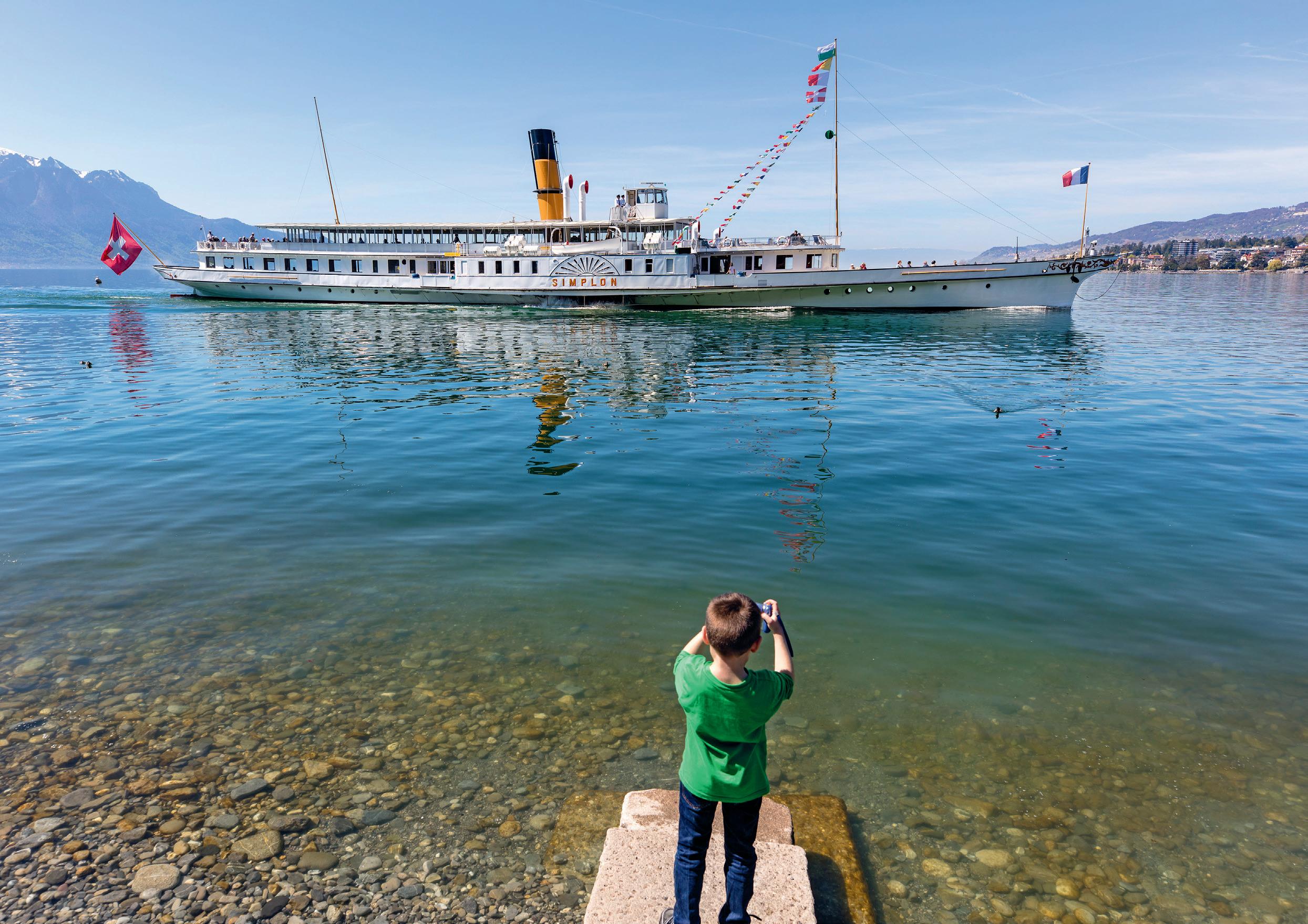



LE TROISIÈME GRAND BATEAU-SALON BELLE ÉPOQUE DE LA CGN (1926)
Désarmé depuis 2002
Rénovation partielle extérieure: 2011
Rénovation générale souhaitée: dès 2026
Capacité: 850 personnes
Restauration: 330 personnes
Longueur: 78,5 m
Puissance: 1100 kW
PARTICULARITÉS
- Construit sur le modèle du Simplon.
- Figure de proue sculptée et peinte de style Art déco.
- Une partie de la machine d’origine est conservée et exposée au Musée du Léman à Nyon.
Al’issue de la Première Guerre mondiale et avec l’espoir de retrouver la Belle Epoque renaissante, la CGN commande, en 1923, un troisième grand vapeur de mêmes dimensions que La Suisse et le Simplon. Avec le premier choc pétrolier de 1975 et la hausse du prix des carburants, la CGN renonce à remplacer les chaudières en fin de vie du bateau et transforme ce dernier en unité diesel-électrique. Depuis sa motorisation, l’Helvétie n’a toutefois jamais navigué à pleine satisfaction et a été progressivement relégué au service de réserve. En 2002, le bateau est désarmé. En été 2011, la CGN décide, en accord avec l’ABVL, de saisir l’occasion d’une mise à disposition du bateau pour abriter le «Musée olympique éphémère» en 2012 et 2013 amarré au quai d’Ouchy. L’ABVL finance une première opération de remise en état de la coque et d’une partie des superstructures. Pour la coque, il s’agit notamment du sablage, qui inclut aussi le safran, les bastingages et les tambours de roues, soit 1100 m2 de surface avec un budget de Fr. 350 000.–. Son amarrage devant le quai d’Ouchy a pris fin en 2015 après l’exposition 100 ans ensemble… Le CIO & Lausanne, et le bateau, qui n’est pas en état de naviguer, est stationné depuis au chantier naval de la CGN. ✵
Désarmé depuis 2002, l’Helvétie pourrait profiter d’une rénovation complète dès 2026, si les fonds nécessaires sont récoltés d’ici là.
THE THIRD OF THE LARGE BELLE ÉPOQUE SALON BOATS OF THE CGN (1926)
Decommissioned in 2002
Partial external renovation: 2011
Complete overhaul coveted up 2026
Capacity: 850 passengers
Foodservice: 330 persons
Length: 78.5 m
Power: 1100 kW
CHARACTERISTICS
- Twin of the Simplon in its appearance.
- Bow figurehead.
- The original steam engine is exhibited in the Musée du Léman in Nyon.
In 1923, after the end of the 1st World War and with the hope of a rebirth of the Belle Epoque, the CGN ordered a third large steam boat of the same class as the La Suisse and the Simplon. As a result of the first oil crisis and the increase in fuel prices, the CGN decided to forego the replacement of the boilers at the end of their useful life and change to dieselelectric power plants.
Ever since its re-motorization, the Helvétie had never operated satisfactorily and was progressively relegated to the role of a reserve boat. In 2002, it was disarmed.
During the summer of 2011 the CGN, in agreement with the ABVL, decided to put the boat at the disposal of the Olympic Museum during its renovation and extension between 2012 and 2013 to house the “Transient Olympic Museum”, The ABVL paid for refurbishing the hull and parts of the superstructure. As concerned the hull, the work consisted primarily of sandblasting, which included also the rudder, the railings and the side-wheel housings, all in all 100 m2 with a budget of CHF 350’000.–.
The anchorage along the Quai d’Ouchy came to an end at the end of 2015 after the exhibition “100 Years of the IOC in Lausanne” and the boat was returned to the CGN shipyard. ✵
Helvétie could be scheduled for a complete overhaul from 2026, if the necessary funding can be found by then.
la flotte the fleet





DERNIER BATEAU À ROUES À AUBES CONSTRUIT
EN SUISSE (1927)
Rénovation générale: 2019-2020
Future capacité: 600 personnes
Restauration: 186 personnes (à confirmer après rénovation)
Longueur: 68 m
Puissance: 625 kW (850 CV)
PARTICULARITÉS
- Système de graissage automatique sous pression, qui nécessite la présence d’un capot de protection au-dessus des bielles.
- Dernier bateau à vapeur entièrement assemblé par un constructeur suisse, équipé d’une machine prototype unique au monde.
- Salon néo-classique en cerisier copié des deux constructions précédentes.
Le Rhône commence sa carrière lors de la Fête des Vignerons de 1927 mais n’entre réellement en service qu’en 1928 à cause de la mise au point délicate de sa machine. Il est le dernier bateau à vapeur à roues à aubes construit en Suisse. Il se singularise sur le plan technique par sa machine à vapeur unique en son genre, avec un graissage automatique nécessitant de couvrir le vilebrequin et les excentriques par des capots afin d’éviter que des jets d’huile n’atteignent les passagers qui les contemplent depuis le pont principal. Première grande rénovation en 1968-1969. La machine est complètement révisée en 2002-2003, et un programme pour la rendre visible en remplaçant ses capots métalliques par d’autres en plexiglas est financé par l’Association des amis des bateaux à vapeur du Léman (ABVL) en 2011. En même temps, l’ABVL finance la mise en valeur du salon de 1re classe. ✵
Complete overhaul: scheduled as of 2019
Future capacity: 600 passengers
Foodservice: 186 persons (to be confirmed after overhaul)
Length: 68 m
Power: 625 kW (850 HP)
CHARACTERISTICS
- Automatic pressurized lubricating system, requiring hoods over the cams.
- A prototype steam engine unique in the world.
- Neoclassic salon in cherry wood, copied from the two previous constructions.
The Rhône started its career on the occasion of the Fête des Vignerons (Vintner Festival) of 1927. It was the last side-wheel paddle steamer to be built in Switzerland and is distinguished on a technical level by a unique steam engine lubricated automatically.This required that hoods cover the crankshafts and eccentrics in order to avoid spraying passengers on the main deck with oil while admiring the machine. First complete overhaul 1968-1969. The steam engine was completely overhauled 2002/2003. A program to improve the visualization of the machine by replacing the steel hoods with ones of Plexiglass was financed by the ABVL in 2011. At the same time, the ABVL provided the money to refurbish the 1st class salon. ✵
Rénovation du Rhône
Mis hors service en novembre 2017, le Rhône bénéficiera cette année et la prochaine d’une grande rénovation et sera remis en service au printemps 2021.
Les objectifs principaux de la rénovation sont les suivants:
• remise en état complète de la structure;
• rénovation de l’ensemble propulsif et embarquement de chaudières neuves afin d’assurer l’exploitation commerciale pour au moins les trente prochaines années;
• mise en conformité du bateau avec les exigences de l’Office fédéral des transports (OFT) concernant la sécurité et amélioration de l’accueil des personnes à mobilité réduite. En termes de sécurité, il s’agit plus spécifiquement de prendre en compte les dernières normes en vigueur, de développer des moyens accrus de détection et de lutte contre le feu, d’installer des cloisons étanches supplémentaires, de prévoir des radeaux de sauvetage autogonflants, de mettre en place un propulseur d’étrave pour faciliter et réduire la durée des manœuvres et augmenter la sécurité de navigation, ainsi que de nouveaux appareils à gouverner et instruments de navigation;
• amélioration de la fonctionnalité, du confort et des aspects liés à l’hygiène;
• restitution la plus complète possible de l’aspect originel du bateau tenant compte d’une exploitation commerciale moderne et des propositions de la Commission patrimoniale;
• prise en compte de facteurs environnementaux, notamment dans l’achat des nouvelles chaudières permettant un potentiel de réduction de la consommation de carburant. En outre, l’application des principes du développement durable sera privilégiée, notamment dans le cadre de la déconstruction, de l’élimination des déchets et du choix des matériaux lors de la rénovation;
• modernisation des cuisines et revue du buffet restaurateur.
Taken out of service in November 2017, the Rhône will be subject to major refurbishment over the next two years before being brought back into service in spring 2021.
The main objectives of the refurbishment are as follows:
• complete renovation of the structure;
• renovation of the propulsion system and installation of new boilers with a view to ensuring commercial operations for at least the next thirty years;
• compliance of the boat with the requirements of the Federal Office of Transport (FOT) with regard to the safety, reception and transport of people with reduced mobility. In terms of safety, it is more particularly a question of taking all recent standards into account, developing enhanced fire-detection and fire-fighting resources, installing additional bulkheads, providing self-inflating lifeboats, installing a bow thruster in order to facilitate and reduce the duration of manoeuvres and increase navigational safety and installing new steering equipment and navigational instruments;
• improved functionality, comfort and health-related aspects;
• as complete a restitution as possible of the original appearance of the boat, taking modern commercial use into account as well as the proposals of the Heritage Commission;
• environmental factors taken into account, in particular in the purchase of new boilers with a view to reducing fuel consumption. Furthermore, the principles of sustainable development will be applied, in particular within the framework of deconstruction, waste disposal and the choice of materials during the renovation process;
• modernisation of the kitchens and review of buffet restaurateur.
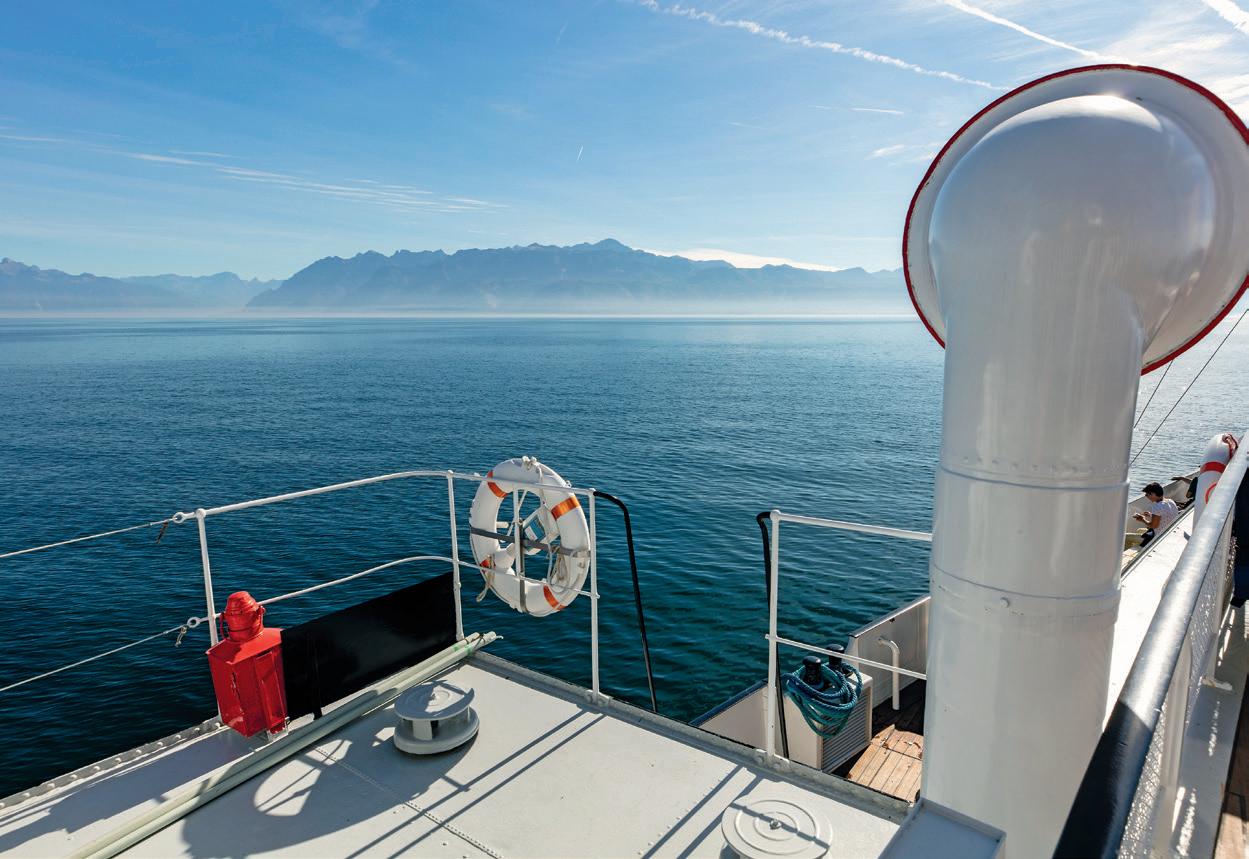

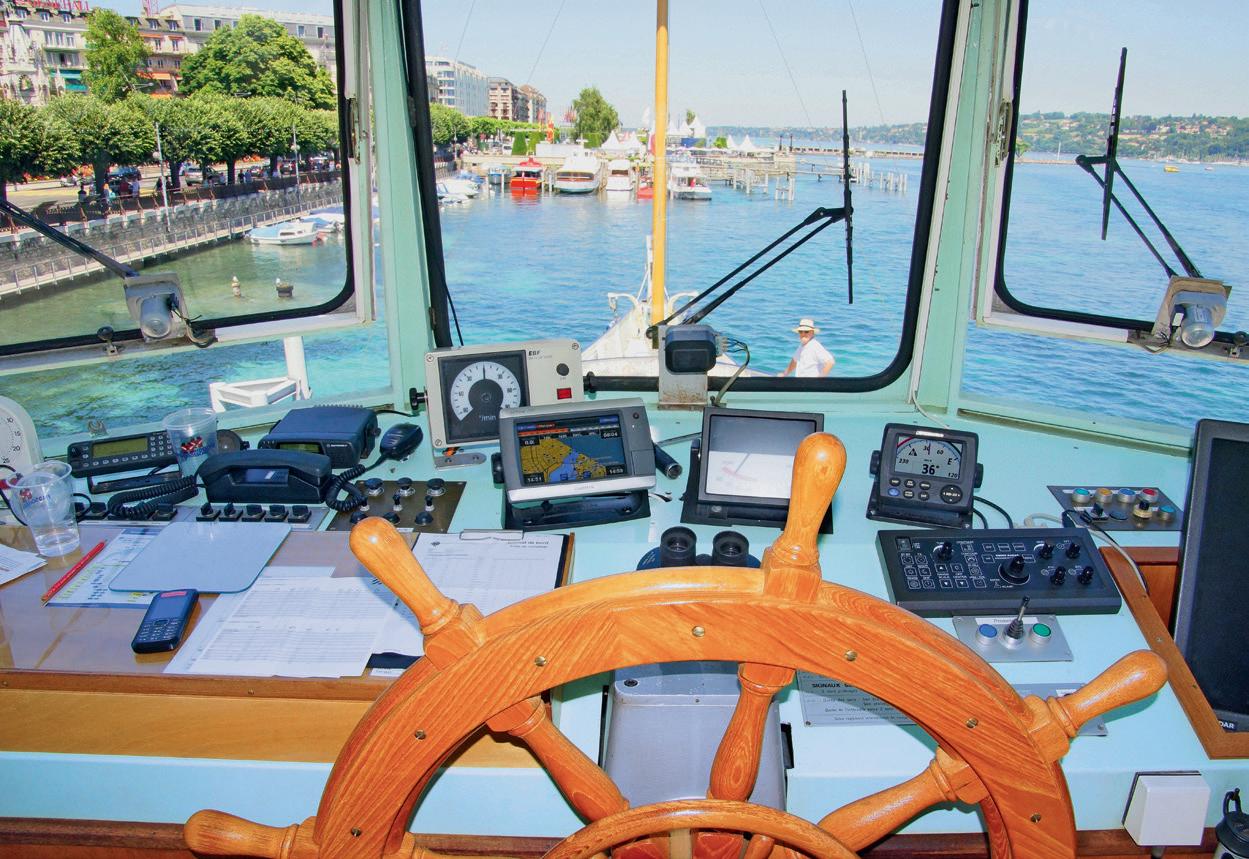











Le comité de l’ABVL, en 2019 (de gauche à droite):
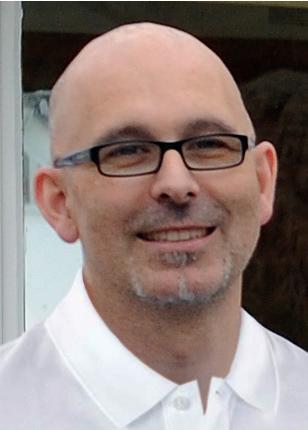

Maurice Decoppet (président), Yves de Siebenthal (vice-président), Evelyne Chevallaz-Belotti (coordinatrice générale), Thomas Beck (trésorier), François Bosshard (secrétaire), Christine Biolley (secrétaire) et Luc-Antoine Baehni (directeur général de la CGN, membre). Carole Hosp (membre), Antoine Jacquenoud (membre), Jean-Jacques Schwaab (membre), Yves de Gunten (membre), Sébastien Buet (membre) et Jean-François Kung (membre).
L’Association des amis des bateaux à vapeur du Léman (ABVL) est un acteur incontournable de la conservation de la flotte Belle Epoque de la CGN.
Fondée en juin 2002 par de véritables passionnés soucieux de la survie de cette flotte qui se trouvait subitement en danger pour des raisons financières, elle compte à ce jour quelque 20 000 donateurs et près de 4000 membres actifs.
Sa mission est définie à l’art. 1 de ses statuts: «l’ABVL a pour but de rechercher des fonds pour la conservation et le maintien en service horaire des huit bateaux Belle Epoque de la CGN, que sont le Montreux, le Vevey, l’Italie, La Suisse, le Savoie, le Simplon, l’Helvétie et le Rhône.» Grâce aux dons récoltés par l’ABVL, les huit bateaux Belle Epoque de la Compagnie générale de navigation sur le lac Léman (CGN) ont pu être partiellement ou totalement rénovés. A ce jour, plus de 35 millions de francs au total ont été récoltés par l’ABVL pour des rénovations effectuées ou à venir. La part apportée par l’ABVL, après sa création en 2002, représente donc environ le tiers du montant global investi pour les rénovations de cette flotte. ✵
RÉNOVATIONS FINANCÉES
PAR L’ABVL
S/S Simplon (1920)
Financement de deux rénovations partielles entre 2003 et 2005 puis, entre 2010 et 2011, du sablage de la coque, de la révision générale de la machine à vapeur d’origine, de la réhabilitation des salons de 1re classe et de 2e classe du pont principal, de la mise en valeur du pont supérieur et de l’installation de propulseurs d’étrave. Pendant l’hiver 20162017, financement du retubage des deux chaudières datant de 1966.
S/S La Suisse (1910)
Financement de plus de 80% de la rénovation complète entre 2007 et 2009.
S/S Montreux (1904)
Financement de la mise au point, sur plusieurs années, de la nouvelle machine à vapeur prototype, puis de la rénovation partielle du salon de 1re classe pendant l’hiver 2014-2015. L’ABVL a également financé en 2016 l’étude et le remplacement du surchauffeur de la chaudière.
S/S Rhône (1927)
Financement, en 2011, de la mise en valeur du salon de 1 re classe. Pour la machine à vapeur, financement du remplacement des capots métalliques faisant partie du système de graissage automatique, qui en obstruaient la vision, par des capots transparents en plexiglas.
M/S Helvétie (1926)
Financement d’une première rénovation partielle en 2011-2012, avec un carénage de conservation, le sablage de la coque et des roues à aubes, ainsi qu’une rénovation limitée des superstructures.
S/S Savoie (1914)
En 2011-2012, financement de la révision générale de la machine à vapeur d’origine.
M/S Vevey (1907)
Dans le cadre de la rénovation générale en 2012-2013, financement de la reconstruction des luminaires d’origine.
M/S Italie (1908)
L’ABVL a mis à disposition 10,6 millions de francs sur les 13,6 millions nécessaires à la rénovation complète, qui a été effectuée entre mai 2015 et octobre 2016.
S/S Rhône (1927)
Participation de l’ABVL à hauteur de 3 millions de francs aux coûts de la rénovation 20192021 devisés à 15 843 000 francs (TTC), majoritairement pris en charge par les trois cantons lémaniques Vaud, Genève et Valais dans le cadre d’un partenariat entre fonds publics et privés. n
LA FONDATION PRO VAPORE
L’ABVL a également créé une fondation en 2006, qui a son siège à Genève, dont le but statutaire est identique au sien et à laquelle elle confie les fonds récoltés. Pro Vapore, contrôlée en tant que fondation par un organe de surveillance, est le garant de la bonne gestion des sommes qui lui sont remises par l’association. Les deux sont inscrites au Registre du commerce. n
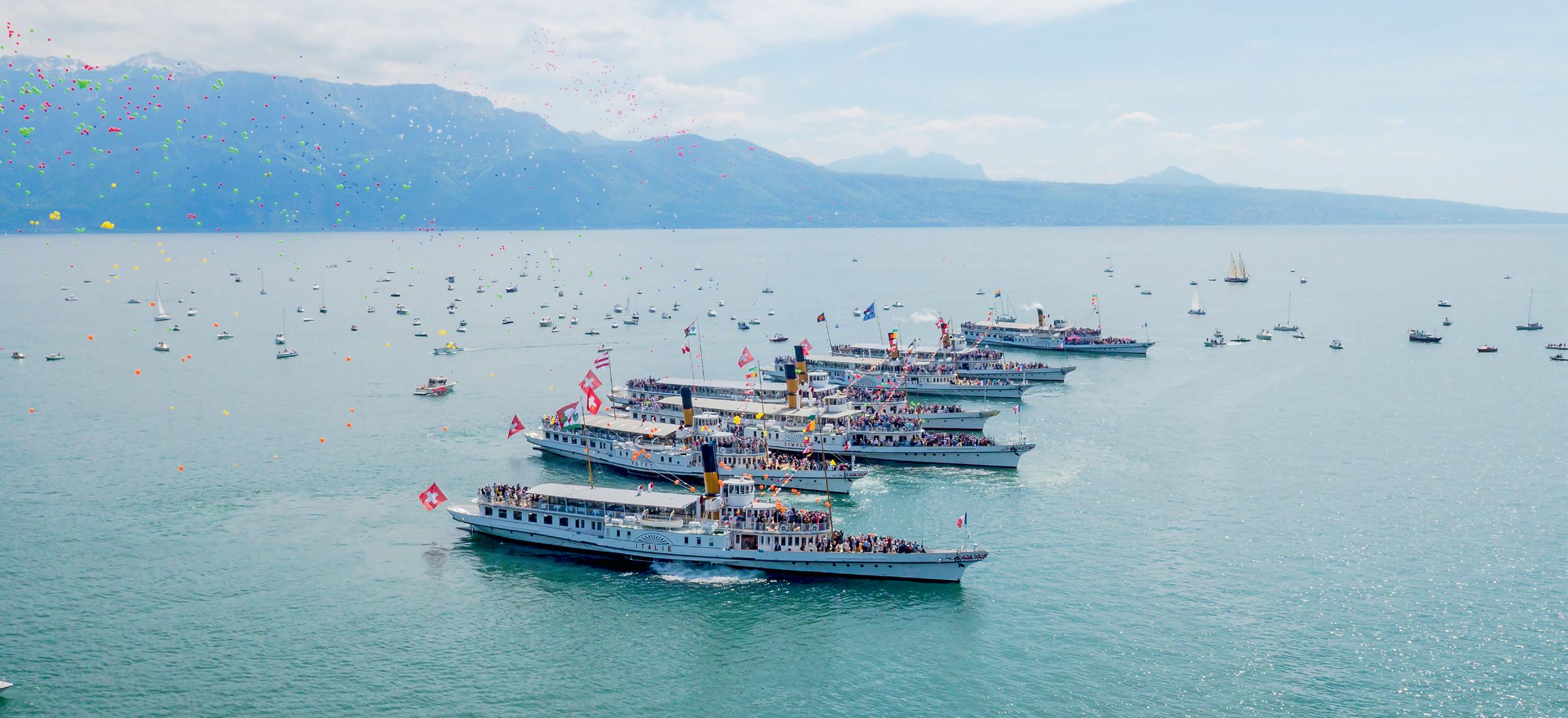
Depuis 2002, l’Association des amis des bateaux à vapeur du Léman (ABVL) s’engage pour que les huit bateaux de la flotte Belle Epoque de la CGN puissent un jour à nouveau fendre les flots du lac Léman ensemble…
Si cette flotte est classée monument historique d’importance nationale, ce qui la met à l’abri de la destruction, son entretien dans le meilleur état de conservation possible demande un investissement financier conséquent, dont une partie importante doit provenir de fonds privés.
Dernier bateau-salon à vapeur à roues à aubes construit en Suisse en 1927, le Rhône bénéficie en ce moment, et pour une durée de quinze mois environ, d’une rénovation complète. Si l’essentiel du financement est assuré par les actionnaires principaux de la CGN, soit les cantons de Vaud, de Genève et du Valais, l’ABVL a été sollicitée à y participer à hauteur de 3 millions de francs afin de permettre le lancement des travaux.
A l’horizon 2023-2025, ce sera au tour du Simplon de bénéficier d’une dernière et plus importante rénovation partielle. Un autre bateau reste encore désaffecté à ce jour: l’Helvétie (1926), lui aussi en attente d’une rénovation complète. Nous n’oublions pas qu’il fêtera son centenaire en 2026!
Chaque don compte! Sans l’engagement indéfectible de l’ABVL depuis plus de seize ans en faveur de la flotte Belle Epoque de la CGN, il ne resterait vraisemblablement aujourd’hui plus qu’un ou deux bateaux à roues à aubes en navigation, comme La Suisse et le Savoie. n
Rejoignez-nous comme donatrice ou donateur par un versement
EN SUISSE
La Poste Suisse – CCP 17-197675-0
IBAN: CH61 0900 0000 1719 7675 0
EN SUISSE OU DEPUIS L’ÉTRANGER PAR VIREMENT BANCAIRE
• En francs suisses: UBS Compte «ABVL»
IBAN: CH62 0024 3243 4589 5701 H
• En euros: UBS Compte «ABVL»
IBAN: CH 68 0024 3243 4589 5761 K
EN FRANCE
La Lyonnaise de Banque (compte en euros)
Compte: 00032572501
IBAN: FR76 1009 6182 2900 0325 7250 178 • BIC CMCIFRPP
Since 2002, the Association Friends of the Steamboats on the Lake of Geneva (ABVL) has been committed to making the dream come true: that one day the eight boats of the Belle Epoque fleet can once again cruise together on Lake Geneva…
Even though the fleet is classified as a “historical monument of national importance”, which will protect it from demolition, maintaining it in the best possible state of conservation requires considerable financial investment, of which a large proportion must come from the private sector.
The last side-wheel paddle steamer built in Switzerland in 1927, the Rhône, is currently being fully renovated in a process that will take about fifteen months. Even though the majority of the necessary funds is provided by the principal shareholders of the CGN, i.e. the cantons of Vaud, Geneva and Valais, the ABVL has been asked to contribute CHF 3 million to allow the work to go forwards.
In 2023-2025, it will be the turn of the Simplon to enjoy a final and even bigger partial renovation.
One last boat remains decommissioned, the Helvétie (1926). We have not forgotten that it will be celebrating its centenary in 2026!
Every donation counts! Without the unfailing commitment of the ABVL to the Belle Epoque fleet of the CGN over the past 16 years, there would most likely only exist one or two side-wheel paddle boats, such as La Suisse and the Savoie, to continue navigating on Lake Geneva. n
Join us as a donor through a contribution
IN SWITZERLAND
La Poste Suisse – CCP 17-197675-0
IBAN: CH61 0900 0000 1719 7675 0
IN SWITZERLAND OR FROM ABROAD THROUGH A BANK TRANSFER
• In Swiss francs: UBS “ABVL” Account
IBAN: CH62 0024 3243 4589 5701 H
• In Euros: UBS “ABVL” Account
IBAN: CH 68 0024 3243 4589 5761 K
IN FRANCE
La Lyonnaise de Banque (Account in Euros)
Account: 00032572501
IBAN: FR76 1009 6182 2900 0325 7250 178 • BIC CMCIFRPP
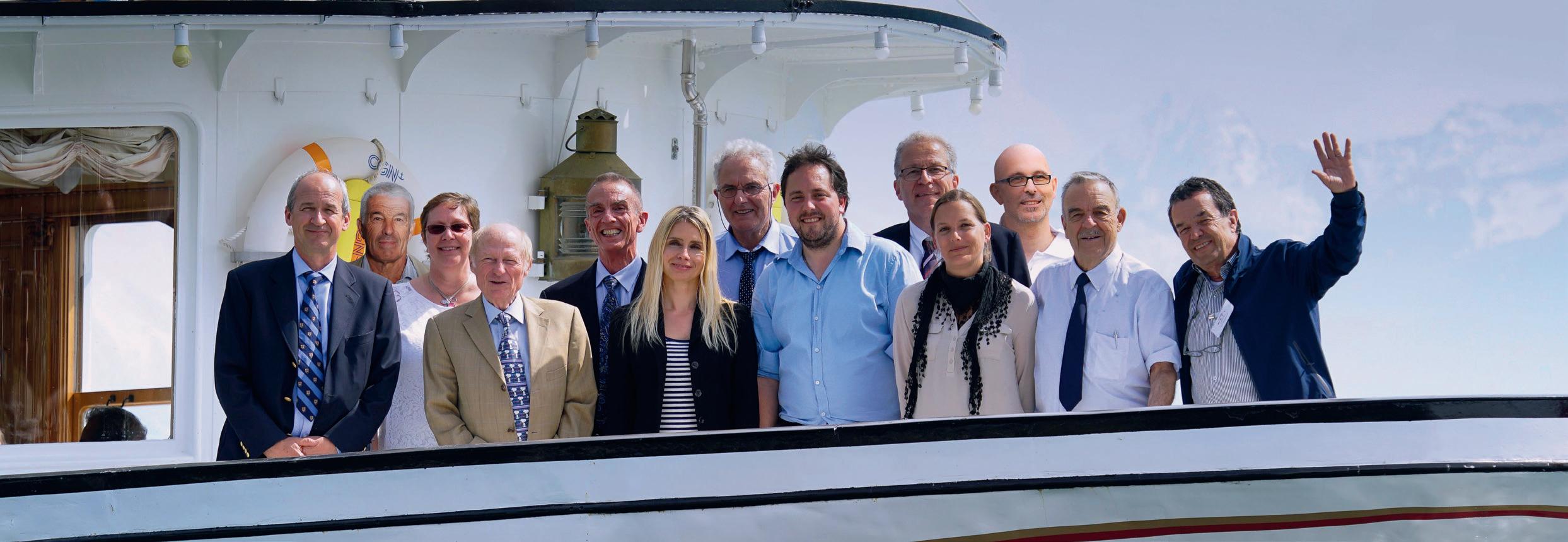
The Board of the ABVL, in 2019 (from left to right): Luc-Antoine Baehni (CGN’s CEO, Member), Jean-François Kung (Member), Christine Biolley (Secretary), Thomas Beck (Treasurer), Yves de Siebenthal (Vice-President), Evelyne Chevallaz-Belotti (General coordinator), François Bosshard (Secretary), Antoine Jacquenoud (Member), Yves de Gunten (Member), Carole Hosp (Member), Sébastien Buet (Member), Maurice Decoppet (President) and Jean-Jacques Schwaab (Member).
The ABVL has become an essential actor in the conservation of the CGN’s Belle Epoque fleet.
Created in June 2002 by two passionate individuals deeply concerned with the survival of a fleet suddenly in danger for financial reasons, it can today count on some 20,000 donors and more than 4,000 active members. Its objective is defined in Art. 1 of its statutes:The ABVL has as its objective the search for funds destined for the conservation and the maintenance in regular service of the eight Belle Epoque boats: Montreux, Vevey, Italie, La Suisse, Savoie, Simplon, Helvétie and Rhône. Thanks to the donations collected by the ABVL, eight Belle Epoque boats belonging to the company operating the boats on Lake Geneva (the CGN) have been partially or completely renovated. To date, the association has collected over CHF 35 millions. The money provided by the ABVL since it’s creation in 2002 represents approximately 35% of the total amount invested in the renovation of this fleet. ✵
S/S Simplon (1920)
Two partial overhauls between 2003 and 2005 and between 2010 and 2011 consisting of sandblasting the hull, completely overhauling the original steam engine, restoring the 1st and 2nd class lounges on the main deck, improving the upper deck and installing bow thrusters. During the winter of 2016/2017 retubing of the two boilers dating from 1966.
S/S La Suisse (1910)
Complete renovation between 2007 and 2009.
S/S Montreux (1904)
Financing the fine-tuning of the new prototype steam engine over a number of years. Partial renovation of the 1st class lounge during the winter 2014/2015. In addition, in 2016, the ABVL financed the replacement of the superheater, an important part of the boiler.
S/S Rhône (1927)
In 2011, financing the improvement of the first class salon. Replacing the steel hoods of the steam engine, which hindered the view but were needed for the automatic lubrication system, with ones made of transparent Plexiglas.
M/S Helvétie (1926)
Financing a first partial renovation 2011/2012: careening for conservation purposes, sandblasting of the hull and the paddle wheels, as well as a limited renovation of the superstructure.
S/S Savoie (1914) 2011-2012, financing of the complete overhaul of the original steam engine.
M/S Vevey (1907)
During the complete overhaul 2012-2013, financing of the Belle Epoque lighting fixtures.
M/S Italie (1908)
The ABVL collected over CHF 10.6 millions for the complete renovation, budgeted at CHF 13.6 millions. The work was undertaken between May 2015 and October 2016.
S/S Rhône (1927)
Participation by the ABVL totalling CHF 3 millions within a total budget of CHF 15,843,000.–(all taxes included), primarily covered by the three cantons around the lake – Vaud, Geneva and Valais – within the framework of a partnership between public and private funds. n
The ABVL has also created a Geneva-based foundation in 2006 called “Pro Vapore”, with identical statutory objectives as the association, to which it has entrusted management of the funds collected. The foundation, controlled by a supervisory government agency, guarantees the good management of the funds povided by the association. Both the association and the foundation are listed on the Trade Register. n

En adhérant à l’ABVL, vous devenez un acteur important de la conservation d’une flotte de bateaux unique au monde!
Avantages membres
• Cadeau de bienvenue
• Participation à l’assemblée générale annuelle
• Evénements exclusifs
• Newsletter
• Actions spéciales
Cotisations annuelles
Individuel: Fr. 30.– / 25 euros
Couple: Fr. 50.– / 40 euros
Junior (6-18 ans): Fr. 20.– / 15 euros
Collectif: Fr. 100.– / 80 euros
Membre à vie: se renseigner auprès de l’ABVL
Inscriptions en ligne: www.abvl.ch ou via la brochure ABVL se trouvant sur tous les bateaux de la CGN.
In coming on board as a member of the ABVL, you will become a key player in the conservation of a fleet of boats unique in the world!
Member advantages
• Welcome gift
• Special offers
• Exclusive events
• Participation in the annual general meeting
• Newsletter
Annual fees
Individual: CHF 30.– / 25 Euros
Couple: CHF 50.– / 40 Euros
Junior (age 6-18): CHF 20.– / 15 Euros
Institutions or organizations: CHF 100.– / 80 Euros
Life member: contact the ABVL
Online registration: www.abvl.ch or by means of the ABVL folder to be found on all the CGN boats.
DER
Mit Ihrem Beitritt können Sie den Erhalt einer einzigartigen Flotte aktiv mitgestalten!
Als Mitglied haben Sie folgende Vorteile
• Willkommensgeschenk
• Einladung an die jährliche Generalversammlung
• Einladung an exklusive Events
• Newsletter
• Spezialangebote
Mitgliederbeitrag
Einzelmitglied: SFr. 30.– / 25 Euros
Ehepaar: SFr. 50.– / 40 Euros
Junior (6-18 Jahre): SFr. 20.– / 15 Euros
Kollektivmitglied: SFr. 100.– / 80 Euros
Mitglied auf Lebenszeit: Erkundigen Sie sich bei der ABVL
Internet-Anmeldung durch www.abvl.ch oder mit dem Coupon in unserem ABVL-Prospekt, den Sie auf allen Schiffen der CGN finden.
Avenue de Rhodanie 17 • Case postale 60 • CH-1001 Lausanne
Tél. +41 (0)21 614 62 88 • Fax +41 (0)21 614 62 89 • info@abvl.ch www.abvl.ch

Isolations industrielles
Plafonds suspendus et parois mobiles
Isolations anti-feu
Isolations de chambres froides et climatisées
Lutte contre le bruit et acoustique
Haute température et réfractaire
Faux planchers
Juillet Août Sept +33 684 03 54 6 0 www.jean-guennal.com

LAMBDA
Technique d’isolation Lausanne SA
Immeuble Le Portique
Avenue de Sévelin 28-32 – Case postale
1000 Lausanne 20
Tél. 021 626 33 84 – Fax 021 626 33 86 www.lambda.ch – la@lambda.ch

Achetez votre billet combiné (croisière + entrée) aux points de vente CGN et profitez d’un rabais sur l’entrée à l’un des onze lieux touristiques de la région.
Buy a packaged offer (cruise + entrance) at CGN’s ticket offices and enjoy a discount at one of the eleven tourist attractions in the region.
THONON PASS, THONON (F) THONON PASS, THONON (F)


www.thononlesbains.com


www.olympic.org/musee MUSÉE OLYMPIQUE, LAUSANNE OLYMPIC MUSEUM, LAUSANNE
SWISS VAPEUR PARC, LE BOUVERET SWISS VAPEUR PARC, LE BOUVERET

www.swissvapeur.ch
JARDIN DES CINQ SENS, YVOIRE (F) GARDEN OF FIVE SENSES, YVOIRE (F)


www.jardins5sens.net
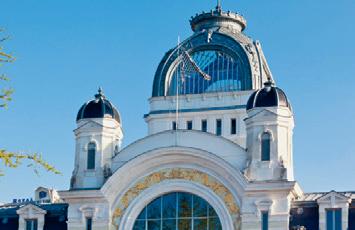

MUSÉE DU LÉMAN, NYON LÉMAN-MUSEUM, NYON


www.museeduleman.ch
ALIMENTARIUM, VEVEY ALIMENTARIUM, VEVEY

www.alimentarium.org
CHAPLIN’S WORLD, CORSIER-SUR-VEVEY CHAPLIN’S WORLD, CORSIER-SUR-VEVEY

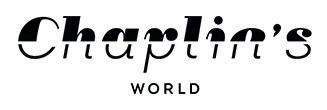
www.chaplinsworld.com

CHÂTEAU

www.redcrossmuseum.ch
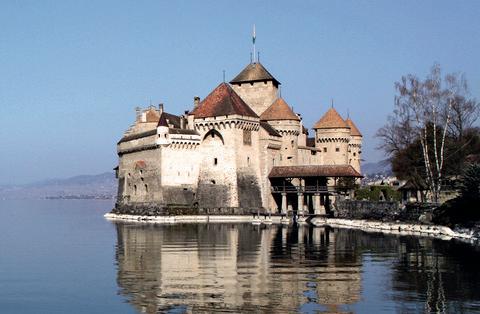

MUSÉE INTERNATIONAL DE LA CROIX-ROUGE ET DU CROISSANT-ROUGE, GENÈVE REDCROSS MUSEUM, GENEVA www.chillon.ch Fr. 15.70 au lieu de / instead of Fr. 18.50**
IRWIN GAFNER
Nommé directeur technique de la CGN en novembre 2017, Irwin Gafner a donné un nouveau cap à ses collaborateurs. Renouvellement de la flotte, disponibilité des navires et développement durable, sa vision prévoit de nombreuses évolutions.
PROPOS RECUEILLIS PAR THOMAS PFEFFERLÉ
PHOTOS: VANINA MOREILLON
Ala tête des 120 collaborateurs techniques de la CGN depuis fin 2017, Irwin Gafner a une vision claire et ambitieuse pour l’avenir de la compagnie. Réfléchi et pragmatique, son projet doit permettre à l’entreprise de consolider sa position de leader sur le Léman, tout en répondant aux besoins en termes de croissance et de développement durable. Entre la construction des prochains navires, la rénovation de la flotte actuelle et la transformation du chantier naval, l’ingénieur a lancé des travaux de grande envergure.
À TOUTE VAPEUR: Vous avez élaboré une stratégie des plus ambitieuses. Parlez-nous des grandes lignes de votre projet.
IRWIN GAFNER: Pour l’avenir, notre stratégie repose sur trois axes: le renouvellement de la flotte, la disponibilité de nos bateaux et le développement durable. Cela pour répondre à une demande toujours plus forte dans le secteur du transport public. En parallèle, nous devons assurer la rénovation de nos bateaux historiques, la CGN disposant de la plus prestigieuse flotte Belle Epoque du monde. Nous souhaitons également améliorer l’efficience énergétique de nos bateaux afin de réduire leur empreinte écologique.

1977
Naissance à Genève.
2001
Il obtient son Master d’ingénieur mécanicien à l’EPFL.
2002
Il obtient son second Master d’ingénieur motoriste à l’IFP à Paris.
2002-2003
Il travaille pour un équipementier automobile américain.
2003-2005
Il relance le laboratoire des activités moteur de l’EPFL, au sein duquel il sera chargé de cours jusqu’en 2017.
2005-2007
Il travaille chez Liebherr à Bulle et développe le moteur des grues mobiles de l’entreprise.
2008-2017
Il travaille chez Holcim et gère la production du site d’Eclépens; il dépose un brevet pour réduire les émissions d’oxyde d’azote de la cimenterie.
2017
Il rejoint la CGN pour en reprendre la direction technique.

Quel est le principal défi en matière de développement et comment comptez-vous le relever?
Bien que ce travail ait commencé depuis plusieurs années, notre flotte nécessite une importante remise à neuf. Certains navires, construits il y a plus de quarante ans, commencent à être limités en termes de performances et de capacité. Parmi nos principaux projets, on peut mentionner la construction du premier BMA, bateau moyen accéléré, notre prochain navire. Avec une capacité totale de 700 personnes, dont 600 places assises, il permettra de répondre à l’augmentation de la demande du transport public lacustre.
Où sera construit ce navire et quand commencera-t-il à naviguer?
Il est conçu au sein de nos locaux, en étroite collaboration avec des partenaires internationaux. Le premier navire sera assemblé dans le bassin de radoub de la CGN à Ouchy. Il devrait commencer à naviguer en 2021 pour assurer la liaison la plus fréquentée entre Evian et Lausanne, sur la ligne N1. Un second BMA pourrait être construit dans la foulée et être affecté à la ligne N2, entre Thonon et Lausanne. Deux autres unités devraient suivre dans les prochaines années.
Qu’est-ce qui vous a attiré au sein de la CGN?
L’esprit familial de la CGN me plaît. Après avoir gagné de l’expérience au sein de trois multinationales, intégrer à nouveau une compagnie suisse à taille humaine me permet de renouer avec mes racines. La CGN est aussi une compagnie historique, dont les prestigieux bateaux Belle Epoque représentent un patrimoine inestimable. Le fait de contribuer à le sauvegarder tout en modernisant la flotte contemporaine de la compagnie s’avère passionnant. D’ailleurs, le fameux vapeur Rhône commencera sa rénovation dès le mois d’avril, afin de pouvoir de nouveau naviguer sur les rives du Léman d’ici au printemps 2021. ✵
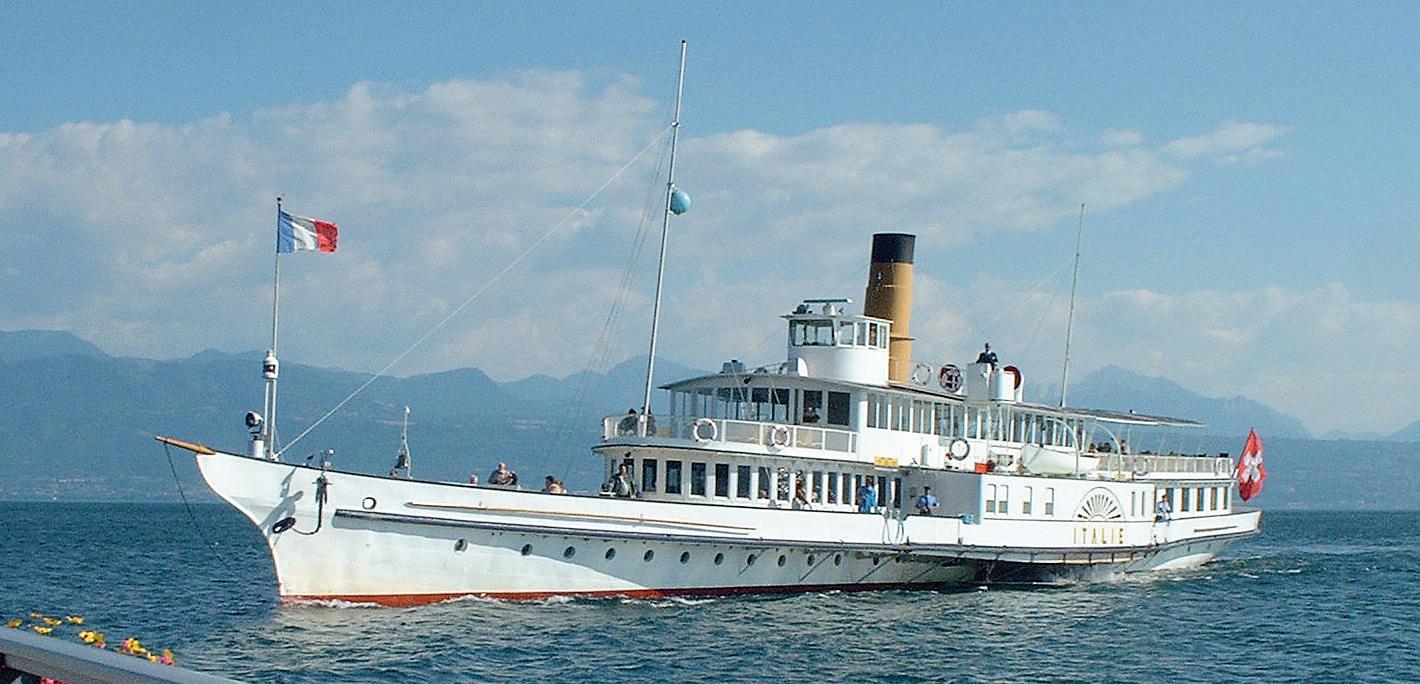
• Service de bennes 4 à 45 m3 • Centre de tri • Chaudière, citerne, etc.

IRWIN GAFNER
Appointed Technical Director of the CGN in November 2017, Irwin Gafner has set a new course for his employees. Renewal of the fleet, availability of the boats and sustainable development –his vision involves numerous changes.
INTERVIEW BY THOMAS PFEFFERLÉ
Responsible for 120 technical employees of the CGN since the end of 2017, Irwin Gafner has a clear and ambitious vision for the future of the company. Thoughtful and pragmatic, his project is intended to help the company consolidate its position as the leader on Lake Geneva while satisfying growth and sustainable development needs. Between the construction of the next generation of boats, the renovation of the current fleet and the transformation of the shipyard, the engineer has initiated a number of large-scale work sites.
À TOUTE VAPEUR: You have developed a highly ambitious strategy. Could you explain the main outlines of your project?
IRWIN GAFNER: For the future, our strategy is based on three key focal points: the renewal of the fleet, the availability of our boats and sustainable development. The aim is to be able to meet the increasing demand in the public transport sector. At the same time, we must renovate our historic boats, as the CGN boasts the most prestigious Belle Epoque fleet in the world. We also intend to improve the energy efficiency of our boats in order to reduce their environmental footprint.
What is the main challenge in terms of development and how do you propose to address it?
While the work began several years ago, our fleet requires comprehensive refurbishment. Built more than 40 years ago, certain boats are beginning to show their limitations in terms of performance

1977
He born in Geneva.
2001
He obtains a master’s in Mechanical Engineering from the EPFL.
2002
He obtains a second master’s in Automotive Engineering from the IFP in Paris.
2002 - 2003
He works for an American automobile equipment manufacturer.
2003 - 2005
He redevelops the motor activities laboratory at the EPFL, working as a lecturer there until 2017.
2005 - 2007
He works for Liebherr in Bulle and develops the motor for its mobile cranes.
2008 - 2017
He works for Holcim and manages production at the Eclépens site while also filing a patent to reduce nitrogen oxide emissions from the cement works.
2017
He joins CGN to take over technical management.
and capacity. Our main projects include the construction of the first accelerated medium boat, which will be our next boat. With a total capacity of 700 people and 600 seats, it will meet the increased demand for public transport on the lake.
Where will this boat be built and when will it begin to operate?
It is designed in our offices in close collaboration with international partners. The first boat will be assembled in the CGN dry dock in Ouchy. It should be put into service in 2021 on the most popular route, the N1 line between Evian and Lausanne. A second such boat could be built immediately afterwards and be assigned to the N2 line between Thonon and Lausanne.Two other units should then follow in the coming years.
What attracted you to the CGN?
I like the family spirit of the CGN Having acquired experience with three multinationals, returning to a Swiss company on a human scale has brought me back to my roots. The CGN is also a historical company and its prestigious Belle Epoque boats represent an invaluable heritage. Contributing to safeguarding this while modernising the company’s contemporary fleet is a fascinating challenge. Furthermore, renovation work on the famous steamer, the Rhône, will begin in April 2019 with a view to returning to service on Lake Geneva by spring 2021. ✵
A Ouchy, le site du chantier naval de la CGN abrite une intense activité. De nombreux corps de métier collaborent étroitement afin d’entretenir et rénover la flotte de la compagnie et de construire ses prochains navires. Reportage dans les coulisses de l’entreprise.
TEXTE: THOMAS PFEFFERLÉ
Lorsque l’on monte à bord des navires de la CGN, on ne songe pas forcément à tous les efforts qui sont fournis en continu par les collaborateurs de l’entreprise pour maintenir le cap. Afin de faire naviguer ses bateaux, la compagnie emploie jusqu’à 120 personnes au sein de sa division technique, quand les navigants ne sont pas engagés sur les bateaux en hiver. Dans cette équipe, de nombreux corps de métier se côtoient: électriciens, mécaniciens et mécaniciens vapeur, constructeurs
métalliques, menuisiers, ébénistes et peintres travaillent en étroite collaboration. Autant de professionnels qui appliquent leurs connaissances techniques aux spécificités du domaine naval. Avec son projet d’agrandissement, la rénovation de la halle sud du chantier naval va permettre de répondre aux besoins de l’entreprise. Une fois rénovée, cette halle comprendra un étage supplémentaire et pourra ainsi abriter des locaux de stockage pour les différents ateliers. Des travaux de grande envergure rendus possibles grâce à un crédit bancaire de plus
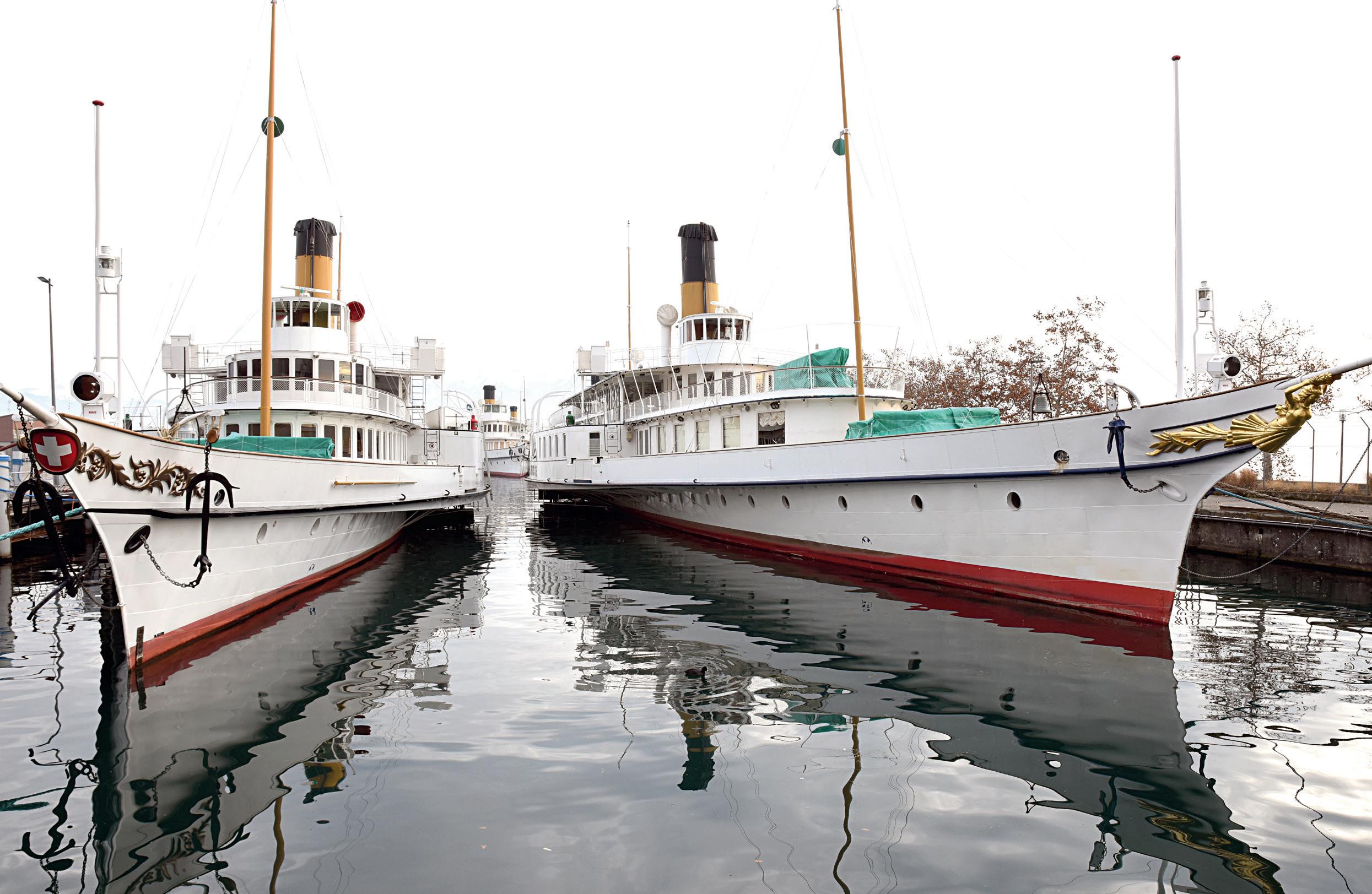

de 5 millions de francs approuvé l’an dernier par les autorités cantonales actionnaires majoritaires de l’entreprise – Vaud, Genève et Valais.
Rénover la flotte existante
L’une des zones centrales du chantier naval se situe dans la halle nord, bâtie il y a plus de cinquante ans. Dans cet immense bâtiment directement connecté aux eaux du Léman, des ouvriers s’affairent au sein du bassin de radoub. Cette fosse, assez vaste pour contenir un navire entier de plus de 80 m de long, permet de travailler à sec afin d’entreprendre les rénovations nécessaires à l’entretien des bateaux.
C’est là qu’en 2018 les opérations menées par les hommes du chantier naval ont permis d’améliorer considérablement l’efficience énergétique de deux navires. Mis en service en 2005, le Valais, avec ses 30 m de long et sa capacité d’accueil de 200 personnes, utilise désormais près d’un quart de car-
burant en moins pour sa propulsion. Un gain énorme notamment obtenu en améliorant l’hydrodynamique de sa coque. Egalement rénové en 2018, le Léman, mis en service en 1990, économise aujourd’hui plus de 20% de carburant par rapport aux précédentes années. Une prouesse technique et écologique rendue possible grâce aux améliorations effectuées sur la carène du bateau (la partie immergée de la coque d’un navire). Avec une longueur proche de 50 m et une capacité d’accueil de près de 600 passagers à son bord, le Léman navigue désormais avec une quille allongée à l’avant et un duck-tail à l’arrière (une sorte d’aileron horizontal limitant les vagues et le frein dans l’eau). En parallèle de ces projets, la flotte Belle Epoque est également au centre des priorités de la CGN. Le Rhône gagnera par ailleurs le bassin de radoub dès le mois de mai pour entamer sa grande rénovation.



Sur cette page
Plusieurs corps de métier se côtoient au sein du chantier naval, tels que des menuisiers, des constructeurs métalliques ou encore des mécaniciens vapeur.
Page de droite
Le bassin de radoub permet de travailler au sec sur les navires afin de les rénover. Ici, la coque du Vevey est améliorée et des nouveaux moteurs de propulsion sont posés sur ce navire historique.
On this page Several trades rub shoulders within the confines of the shipyard, including carpenters, metal manufacturers and steam mechanics.
Right-hand page
The dry dock makes it possible to work on the boats in dry conditions for renovation purposes. Here, the hull of the Vevey is improved and new propulsion engines are fitted on this historic vessel.




Bâtir le futur
C’est aussi dans le bassin de radoub que se construit l’avenir de la CGN. Au sein de ces halles techniques, pour lesquelles des agrandissements sont prévus, le prochain géant du lac voit progressivement le jour. Conçu et réalisé sur place, le futur navire à passagers de la CGN permettra ainsi de répondre efficacement à la demande croissante dans le segment du transport public lacustre. Il faut dire que les capacités et dimensions de ce BMA (bateau moyen accéléré) ont de quoi impressionner: 700 places au total, dont 600 assises, un système de propulsion hybride entre des moteurs diesel et électriques) et une coque dont les propriétés hydrodynamiques ont été conçues pour répondre aux spécificités du lac, dont les vagues peuvent atteindre 2 m en cas de mauvais temps. Rendue possible grâce à un futur crédit d’environ 15 millions de francs, la construction de ce futur navire devrait ensuite déboucher sur celle de trois autres, si les autorités concernées valident le plan d’affaires de la CGN. Après la mise en service du premier BMA, en 2021 (qui permettra d’assurer la liaison la plus demandée entre Evian et Lausanne avec une cadence de 45 minutes), la CGN envisage la cons-truction d’unités supplémentaires au cours des années suivantes pour étoffer encore sa flotte de transport public.
Attirer les talents
Sur les quais du chantier naval, où près d’une dizaine de navires sont amarrés en attendant d’être

entretenus ou rénovés, les experts techniques de l’entreprise s’activent pour garder le cap donné par leur nouveau directeur, Irwin Gafner, monté à bord de la CGN fin 2017 (lire l’interview page 38) Pour faire naviguer sa flotte, la compagnie doit s’appuyer sur de nombreux savoir-faire spécifiques au secteur naval. Des profils de compétences qui s’avèrent particulièrement rares sur le marché. Pour y faire face, le directeur technique veille à tisser des collaborations internationales avec les industries navales à la pointe de la technologie afin de bénéficier pleinement de leur expertise et connaissance du domaine. Déjà partenaire du chantier naval, l’EPFL collabore par ailleurs avec la CGN depuis peu. Le long de la jetée de la Compagnie, l’entreprise a mis ses infrastructures à disposition afin de tester certains prototypes de bateaux conçus par les étudiants. A terme, le projet doit permettre de renforcer les ponts entre les milieux industriel et académique afin de faire émerger les innovations nécessaires au soutien de la croissance. ✵
reportage reportage
CGN’S SHIPYARD
The CGN shipyard in Ouchy is a hive of activity. Numerous professions work in close cooperation to maintain and renovate the company’s fleet and build the future boats. A report from behind the scenes.
TEXT: THOMAS PFEFFERLÉ


When you climb aboard the boats of the CGN, you don’t necessarily think about the constant efforts made by the company’s employees to ensure we stick to our heading. To operate its boats, the company employs some 120 people in its technical division. Numerous professions rub shoulders within this team: electricians, mechanics and steam mechanics, metalworkers, carpenters, cabinetmakers and painters work in close collaboration. So many professionals who apply their technical knowledge to the particularities of the naval field.
With its expansion project, the renovation of the south hangar of the shipyard will help meet the company’s needs. Once renovated, this hangar will include an additional floor and will thus be able to house the storage areas for the different workshops. This involves large-scale work financed by a loan of more than CHF 5 millions granted last year by the cantonal authorities who are majority shareholders in the company – Vaud, Geneva and Valais.
Renovating the existing fleet
One of the central areas of the shipyard is located in the northern hangar, dating back more than
50 years. In this immense building connected directly to Lake Geneva, the workers busy themselves in the dry-dock. This basin – large enough to hold an entire boat more than 80 metres long – makes it possible to work out of the water in order to undertake the renovations necessary to the maintenance of the boats. It was here, at the end of 2018, that the operations carried out by the shipyard workers massively improved the energy efficiency of two boats. Brought into service in 2005, the 30-metre-long Valais with a capacity of 200 people now uses almost one-third less fuel.This is a massive gain, primarily obtained by improving the hydrodynamics of its hull. Also renovated in 2018 after being brought into service in 1990, the Léman now saves more than 20% of the fuel used in previous years. This technical and eco-logical feat was achieved thanks to the improvements made to the boat’s draught (the immersed part of a boat’s hull, ed.). Approaching 50 metres in length and with a capacity of almost 600 passengers aboard, the Léman now operates with a lengthened keel at the front and a duck-tail at the rear (a sort of horizontal fin limiting waves and the drag in the water, ed.)
Ci-dessus, à gauche Amarrés aux quais du chantier naval, ou à sec au sein du bassin de radoub, les navires de la CGN sont continuellement rénovés et améliorés en termes d’efficience énergétique.
Ci-dessus, à droite De nombreux corps de métier y sont représentés, tels que les mécaniciens qui œuvrent sur les moteurs de la flotte.
Above, left Moored to the quays of the shipyard or in the dry dock, the boats of the CGN are constantly renovated and improved in terms of energy efficiency.
Above, right
A number of trades are represented, including the mechanics who work on the fleet’s engines.

Building the future
It is also in the dry-dock that the future of the CGN is built. Inside these technical hangars which are scheduled for expansion, the next giant of the lake is gradually taking shape. Designed and built on site, the future passenger boat of the CGN will provide an effective response to the increasing demand in the lake-based public transport sector. Admittedly, the capacities and dimensions of this accelerated medium boat are quite impressive: 700 places in total with 600 seated, a hybrid propulsion system combining diesel and electric motors) and a hull boasting hydrodynamic characteristics designed to deal with the particularities of the lake, where the waves can reach up to two metres in bad weather. Made possible by a loan of about 15 million Swiss francs granted last year by the cantons and French municipalities concerned, the construction of this future boat should then be followed by another three. After the first BMA is brought into service in 2021 (to run every 45 minutes on the most popular route between Evian and Lausanne), the CGN intends to build additional vessels in the coming years to expand its public transport fleet even further.
On the quays of the shipyard, where close to ten boats are moored awaiting maintenance or renovation, the company’s technical experts make every effort to maintain the course set by the new Director, Irwin Gafner, who climbed aboard the CGN at the end of 2017 (read the interview on page 41). To operate its fleet, the company must rely on wide-ranging know-how specific to the naval sector. These skill sets are particularly rare on the market. To address this issue, the Technical Director makes every effort to develop international partnerships with naval industries at the cutting edge of technology in order to take full advantage of their expertise and knowledge in their respective fields. Already a partner of the shipyard, the EPFL has only recently begun working in collaboration with the CGN. Along its pier, the company has made its infrastructures available in order to test certain boat prototypes designed by the students. In the long term, the project should help build stronger bridges between the industrial and academic sectors in order to develop the innovations necessary to promoting growth. ✵

Le plus grand lac d’Europe occidentale compte cinq îles. Certaines sont privées, d’autres ouvertes au public. Chacune d’elle a sa propre histoire. Nous allons vous les raconter.
Western Europe’s largest lake boasts five islands. Some are privately-owned while others are open to the public. Each island has its own history. And we would like to tell you little bit about them.
TEXTE / TEXT: JOËLLE LORETAN
tour du lac lake tour

PHOTO: © JP_KAYAK
Localisation: au large de Villeneuve
Superficie: de 20 à 77 m2… selon les sources!
Propriété: publique (communes de Villeneuve et de Noville)
Accessibilité: libre
C’est au large de Villeneuve que se trouve la plus petite île du Léman, celle qui inspira quelques vers du poème Le Prisonnier de Chillon de Lord Byron (1816). Née de l’amoncellement des alluvions déversés sans répit par le Rhône depuis l’époque glaciaire, elle fut consolidée au XVIIIe siècle par des enrochements. Cette île est donc presque naturelle. Plusieurs légendes entourent ce lopin de terre: il aurait été érigé au milieu du XIXe siècle par une jeune veuve, en mémoire de son amour, noyé à cet endroit-là. On raconte aussi qu’il aurait été offert par nos autorités fédérales à la reine Victoria il y a cent cinquante ans, mais qu’elle l’aurait rendu alors qu’on lui réclamait des impôts fonciers. D’autres sources disent que la souveraine aurait transmis ce patrimoine à ses descendants et qu’il leur appartiendrait aujourd’hui encore. Mais le vrai maître du lieu, c’est cet imposant platane qui fête cette année ses 168 ans. Planté en 1851 avec deux autres platanes, il est le seul à avoir tenu le coup et marque aujourd’hui incontestablement l’identité du lieu. ✵
TheLocation: off Villeneuve
Area: between 20 and 77 m2… depending on who you listen to!
Ownership: public (municipalities of Villeneuve and Noville)
Access: free
The smallest island in Lake Geneva lies offshore opposite Villeneuve and was the inspiration for a number of lines of the poem The Prisoner of Chillon by Lord Byron (1816). Growing out of the accumulation of sediment constantly deposited by the Rhone since the Ice Age, it was consolidated in the 18th century by means of riprapping. This island is thus almost natural. Several legends surround this little plot of land: it is said to have been raised in the mid-19th century by a young widow in memory of her lover who drowned in this precise spot. The story also goes that it was offered to Queen Victoria 150 years ago by our federal authorities, but that she returned it when asked to pay property tax. Other sources claim that the sovereign handed this heritage down to her descendants and that it still belongs to them. The true master of the island, however, is the impressive plane tree that is celebrating its 168th anniversary this year. Planted in 1851 along with two other plane trees, it is the only one to have stood the test of time and unquestionably marks the identity of the place. ✵

Localisation: Rolle, au large du port
Superficie: 2368 m2
Propriété: publique (commune de Rolle)
Accessibilité: libre
Vers 1835, un groupe de commerçants locaux a l’idée d’ériger une île «brise-vagues». Le but est alors de protéger le port situé à l’ouest, là où les bois en provenance du Jura sont embarqués pour Genève. C’est en 1838 qu’elle est baptisée de son nom officiel, un hommage à Frédéric-César de La Harpe, mort la même année. Mais qui est cet illustre compatriote? Avocat et personnalité politique vaudoise, il est précepteur du tsar Alexandre Ier de Russie. Pendant onze ans, il lui enseigne ainsi les principes libéraux qui l’habitent. Cet inspirateur de la Révolution vaudoise joue un rôle décisif dans l’histoire de notre pays à deux occasions: une première fois en 1798 quand il réclame une intervention française pour «libérer» les Vaudois de la domination bernoise, et une seconde en 1813 lorsqu’il convainc les vainqueurs de Napoléon de laisser la Suisse maîtresse de son destin. L’île de La Harpe est la plus grande du Léman. ✵
Location: Rolle, opposite the port
Area: 2,368 m2
Ownership: public (municipality of Rolle)
Access: free
Around 1835, a group of local traders had the idea of erecting an island as a breakwater. The aim was to protect the port situated to the west where the lumber from the Jura was loaded onto boats for Geneva. The island was given its official name in 1838 in homage to Frédéric-César de La Harpe who died the same year. But who was this illustrious citizen? A lawyer and political figure in the canton of Vaud, he served as tutor to Czar Alexander I of Russia. For eleven years, he taught him the liberal principles in which he believed. On two occasions, this driving force behind the Vaud revolution played a decisive role in the history of our country: once in 1798 when he called for French intervention to “liberate” the people of Vaud from Bernese domination and a second time in 1813 when he convinced the conquerors of Napoleon to allow Switzerland to be the master of its own destiny. L’île de La Harpe is the largest island in Lake Geneva. ✵
L’île
Localisation: Bursinel
Superficie: 150 m2
Propriété: privée
Située à 70 m du rivage, elle serait l’île la plus ancienne du Léman. Pourtant, on trouve peu, voire aucune information sur elle. Les archives sont beaucoup plus généreuses avec le domaine de Choisi qui lui fait face et dont la superficie représente tout de même 10% du territoire de la commune de Bursinel. Ce parc aurait d’ailleurs partiellement inspiré Hergé pour L’Affaire Tournesol et aurait également servi de cadre cinématographique. Depuis 2015, le domaine (sur lequel se trouve un château et une maison de maître) appartient à des propriétaires privés désireux de rester anonymes. Et pour la petite histoire, Sir Winston Churchill séjourna dans le domaine de Choisi en 1946. L’importance historique du château, ainsi que sa valeur architecturale, lui valent d’être classé à l’inventaire cantonal du patrimoine ainsi qu’à l’inventaire suisse des biens culturels d’importance nationale. ✵
Location: Bursinel Area: 150 m2
Ownership: private
Located 70 metres from shore, it is said to be the oldest island in Lake Geneva. And yet there is very little, if any, information to be found about it. The archives are far more abundant with regard to the Domaine de Choisi estate which looks out at it from shore and accounts for 10% of the municipality of Bursinel. This park is said to have served, in part, as inspiration for Hergé’s The Calculus Affair while also being used as a cinema backdrop. Since 2015, the estate (home to a castle and mansion house) has belonged to private owners who are keen to remain anonymous. And for the anecdote, Sir Winston Churchill stayed at the Domaine de Choisi in 1946. The historical importance of the castle and its architectural value have led it to be listed in the cantonal heritage inventory and the Swiss inventory of cultural assets of national importance. ✵

L’île

Localisation: Genève
Superficie: 1680 m2
Propriétaire: publique (Ville de Genève)
Accessibilité: libre
En plein centre-ville, l’île Rousseau est un espace de verdure sur le Rhône. Aujourd’hui si romantique, l’endroit a pourtant eu un passé agité. A vocation militaire, ce bastion appartenant à l’enceinte défensive de la ville a été construit en 1585-1588. Placé au milieu du Rhône, il était un point stratégique pour surveiller l’accès à la Rade. Dès 1587, le site réaffecté est destiné à la construction et à la réparation des bateaux du gouvernement. On y trouve ensuite un battoir à poudre et un entrepôt de quarantaine pour les marchandises provenant de régions touchées par des maladies infectieuses. En 1832, l’île est reliée au pont des Bergues et transformée en promenade publique. Les admirateurs de Jean-Jacques Rousseau décident d’aménager l’île de manière à rappeler celle du petit lac d’Ermenonville, chère au philosophe genevois. On y plante des peupliers d’Italie et des saules pleureurs. En 1835, une statue est érigée en l’honneur de l’homme de lettres et l’île est rebaptisée de son nom. L’île Rousseau est restaurée et réaménagée à l’occasion du tricentenaire de la naissance de Rousseau, en 2012. Devenue jardin public, elle est la plus fréquentée des îles du Léman. ✵
Location: Geneva
Area: 1,680 m2
Ownership: public (City of Geneva)
Access: free
Located at the heart of the city, the île Rousseau is an area of greenery in the middle of the Rhône. A romantic setting today, it nevertheless had a somewhat turbulent past. A military site, this bastion belonging to the city’s defensive works was built in 1585-1588. Situated in the middle of the Rhône, it was a strategic point to oversee access to the harbour. From 1587, the reassigned site was used for the construction and repair of government boats. This was then replaced by a powderbeating plant and a quarantine warehouse for goods from regions affected by infectious diseases. In 1832, the island was connected to the Pont des Bergues bridge and transformed into a public promenade. Admirers of Jean-Jacques Rousseau decided to convert the island such as to recall the island in the little lake of Ermenonville so dear to the Genevan philosopher. They planted poplar trees from Italy and weeping willows. In 1835, a statue was erected in homage to this literary giant and the island was renamed in his honour. L’île Rousseau was restored and redeveloped for the three-hundredth anniversary of Rousseau’s birth in 2012. Now a public garden, it is the most frequented of the islands in Lake Geneva. ✵
Localisation: Clarens-Montreux, devant le port du Basset
Superficie: 1120 m2
Propriété: privée
En 1880, seul un amas de rochers émergeait de l’eau. C’est vers 1886 que l’ingénieur montreusien Joseph d’Allinges, chargé de la construction de la ligne de train du Tonkin (Saint-Gingolph – Evian), déverse des barques remplies de pierres sur cet écueil de rochers. L’île est née. Le cadastre l’enregistre en 1889 sous le nom de Salagnon, référence aux barques chargées de sel qui étaient autrefois soumises aux contrôles de la douane de Clarens. L’île est achetée en 1900 par le peintre françaisThéobald Chartran. Un escalier et un petit port y sont aménagés, puis une villa de style florentin. C’est aujourd’hui, dit-on, l’une des maisons les plus photographiées au monde! Théobald Chartran y séjourne tous les étés jusqu’à sa mort en 1907 et y organise des soirées fastueuses avec d’illustres personnalités (hommes politiques, mécènes, artistes renommés). L’île appartient tour à tour à un comte russe, à un commerçant zurichois, puis à une Américaine, Mary Shillito. En 1947, elle devient propriété d’un homme d’affaires zurichois, Ernst Pflüger; son fils Ernest Bernhard Pflüger en est toujours le détenteur. L’île et la villa sont classées comme biens culturels d’importance nationale. Et pour la petite histoire, l’actrice Simone Signoret y tourne en 1949 une séquence de Suzanne et son marin, film réalisé par le réalisateur suisse Leopold Lindtberg. ✵
Location: Clarens-Montreux, opposite the port du Basset
Area: 1,120 m2
Ownership: private
In 1880, nothing more than a heap of rocks poked out of the water. In about 1886, the Montreux-based engineer Joseph d’Allinges, tasked with building the Tonkin railway (SaintGingolph – Evian), emptied barge-loads of stones onto this pile of rocks. And so the island was born. It was recorded in the land register in 1889 under the name Salagnon, a reference to the barges loaded with salt which used to be subject to controls by the Clarens customs office. The island was purchased in 1900 by the French painter Théobald Chartran. Some steps and a little port were built, followed by a Florentine-style villa. Today, it is said to be one of the most photographed houses in the world! Théobald Chartran stayed here every summer until his death in 1907, and organised lavish evenings with illustrious guests (politicians, philanthropists, famous artists). The island then passed into the hands of a Russian count, a merchant from Zurich and Mary Shillito, an American. In 1947, it became the property of a Zurich-based businessman, Ernst Pflüger; his son, Ernest Bernhard Pflüger, is the current owner. The island and the villa are listed as cultural assets of national importance. And for the anecdote, the actress Simone Signoret filmed a sequence from Suzanne et son marin here in 1949, a film by the Swiss director Leopold Lindtberg. ✵

tour du lac lake tour



A force de le contempler, d’y naviguer et de s’y baigner, on a l’impression de le connaître par cœur. Et pourtant, le Léman a encore bien des choses à nous raconter!
TEXTE: SYLVIE ULMANN

1. Le Léman est né d’un glacier
Les scientifiques se disputent encore quant à savoir comment le plus grand lac alpin d’Europe a vu le jour. Mais la théorie qui semble faire de plus en plus l’unanimité serait que la cuvette du Léman a été creusée par les mouvements du glacier du Rhône au fil des différentes phases de glaciation. Le lac lui-même serait né lors du retrait du glacier, il y a 15 000 ans environ. Aujourd’hui, le Rhône, qui le traverse d’est en ouest, lui apporte 75% de son eau.
2. Le Léman a déjà connu des phénomènes météorologiques extrêmes
Comme ce tsunami qui l’a balayé en 563. Une vague de 13 m à Lausanne, 8 à Genève, certainement due à l’effondrement d’un pan de montagne. Les rochers ne sont pas tombés directement dans le lac, comme on pourrait l’imaginer, mais ont causé un éboulement sur le delta du Rhône et déplacé d’impressionnants volumes de matière. Ceux-ci ont à leur tour mobilisé d’énormes masses d’eau, qui ont provoqué la fameuse vague.
3. Le Léman reste à flot
Le niveau du lac est lié à la fonte des glaciers et à l’assèchement des rivières, deux phénomènes euxmêmes très probablement dus au changement climatique. Saisons sèches et fortes canicules estivales se sont succédé ces dernières années, mais le niveau du Léman est demeuré stable. Ce qu’il doit sans doute à sa taille (582,4 km2, 72,8 km de long et 308,99 m de profondeur). De plus petits lacs, comme ceux d’Annecy, en France, ou de Bret, dans le canton de Vaud, ont énormément souffert de ces conditions climatiques.
4. Le Léman se réchauffe
La Commission internationale pour la protection des eaux du Léman (CIPEL) – commission intergouvernementale franco-suisse chargée de surveiller l’évolution de la qualité des eaux du lac Léman, du Rhône et de leurs affluents – suit de près leur température. En surface, celle-ci a augmenté de 2°C en 46 ans, passant de 10,9°C en moyenne annuelle à 5 m de profondeur en 1970 à 12,9°C en 2016. «Ce changement a des conséquences sur le fonctionnement de l’écosystème. Ainsi, l’omble chevalier se reproduit dans des eaux à 8°C, entre 50 et 100 m de profondeur. Les conditions de frai idéales n’existent plus au moment voulu. Elle va alors se décaler dans le temps», explique Audrey Klein, secrétaire générale de la CIPEL. Un suivi d’autres espèces a eu lieu il y a deux ans, mais le recul manque encore pour interpréter les informations recueillies. A terme, l’idée est d’adapter les périodes de pêche à ces changements.
5. Le Léman est sous pression
Les eaux du lac sont considérées comme propres, mais la vigilance reste de mise. En 2020, la CIPEL lancera un nouveau plan d’action. En ligne de mire: les micropolluants, ces substances trop petites pour être retenues par les filtres des stations d’épuration (STEP). Issus des médicaments ou des produits phytosanitaires, ils sont principalement rejetés par les ménages, l’industrie et l’agriculture.Très variés, ils sont présents en quantités moins importantes que les fameux PCB, aujourd’hui interdits, mais dont on décèle toujours des traces. Problème: en se dégradant, ils peuvent générer des substances encore plus dangereuses.
6. Le Léman n’échappe pas au fléau des plastiques
Comme toutes les eaux continentales, le Léman n’échappe pas à leur présence. L’Association pour la sauvegarde du Léman (ASL) vient de publier les résultats d’une étude démontrant que quelque 50 tonnes de plastiques finissent chaque année dans le lac. Une grande partie y reste, ce qui constitue un risque pour toute la chaîne alimentaire. Ces plastiques proviennent des déversoirs d’orage, des eaux de ruissellement, des rejets directs, des eaux usées ou des retombées atmosphériques. Ils ne sont pas tous égaux. D’un côté, les micro et nanoplastiques, d’une taille comprise entre 5 et 0,001 mm pour les premiers, les seconds mesurant moins de 0,001 mm. Ceux-ci échappent aux filtres des STEP. De l’autre, les macroplastiques, qui dépassent les 5 mm. Ils sont retenus dans les STEP. Des opérations de nettoyage du Léman ont lieu régulièrement. L’action Net’Léman, organisée par l’ASL en mars dernier, a ainsi rassemblé 1000 bénévoles et permis de sortir des eaux plus de 5500 kg de déchets en tout genre. Mais mieux vaudrait bien entendu se rappeler que le lac n’est pas une poubelle.
7. Le Léman n’est plus menacé par les phosphates
Dans les années 1980, les phosphates étaient le principal ennemi du lac. Ils étaient aussi la cause numéro un de l’eutrophisation – ou désoxygénation – de l’eau, un phénomène contre lequel la CIPEL lutte depuis sa création en 1962. Avec succès, car les teneurs en phosphore, qui étaient passées de moins de 15 µg/l avant les années 1960 à 89,5 µg/l en 1979, sont retombées en 2017 à environ 18 µg/l. Certes, c’est légèrement audessous de l’objectif, qui consistait à ramener cette concentration moyenne à 15 µg/l pour limiter durablement la croissance des algues, mais le lac est sur la bonne voie.
8. Le Léman manque d’oxygène en profondeur
En profondeur, les concentrations en oxygène devraient toujours dépasser 4 mg/l, de manière à éviter que le phosphore ne ressorte des sédiments. Cette quantité assure aussi le maintien de la vie aquatique. Pour ce faire, le lac doit se «brasser» régulièrement. Hélas, ce phénomène naturel a lieu
de moins en moins souvent. Durant l’hiver 20162017, les conditions météorologiques n’ont permis qu’un brassage partiel, jusqu’à 190 m de profondeur. Résultat, à 309 m de profondeur, les concentrations en oxygène demeurent beaucoup trop faibles.
9. Un Léman plus chaud = davantage de soleil et moins de stratus? Ces dernières décennies, Météosuisse a effectivement observé une diminution du stratus et une augmentation de l’ensoleillement en hiver. Pas de quoi se réjouir pour autant: «Difficile d’affirmer que ces phénomènes sont vraiment liés ou non au réchauffement. Ce qui est sûr en revanche, c’est que les périodes sèches et chaudes en été se multiplient et causent davantage d’orages violents», souligne Mikhaël Schwander, de Météosuisse. Il rappelle que 2018 a été l’année la plus chaude depuis que les mesures de température existent, soit 150 ans.
10. Le Léman fait à la fois office de chauffage et de climatisation Naturellement d’abord, puisque l’hiver, il restitue la chaleur accumulée pendant la belle saison, adoucissant les températures aux alentours, et les rafraîchissant l’été, par effet inverse. Plusieurs installations utilisent également les températures des eaux profondes du lac pour chauffer ou climatiser des bâtiments. A Genève, le système thermique Genève Lac Nations (GLN) y recourt à cet effet pour ceux des organisations internationales et des entreprises du quartier des Nations et de Sécheron. Toujours dans la Cité de Calvin, le projet Genilac vise à chauffer habitations et bâtiments commerciaux au centre-ville d’ici à 2021. Il devrait s’étendre au secteur de l’aéroport en 2022. Ce vaste réseau hydrothermique doit acheminer l’eau du lac, pompée à 45 m de profondeur, où la température est stable tout au long de l’année, directement dans les bâtiments, pour les rafraîchir. Couplé à des pompes à chaleur haute performance, ce système est également en mesure de les chauffer. Il devrait permettre de diminuer les émissions de CO2 liées à l’utilisation d’énergies fossiles de 25% d’ici à 2020. A noter qu’en fin de cycle, l’eau retourne à son milieu naturel, à une température proche du milieu ambiant (3°C en hiver et 15°C en été), de façon à ne pas perturber la faune et la flore. ✵


environnement environment


LAKE GENEVA AND THE CLIMATE
By dint of observing it, sailing on it and swimming in it, we feel as if we know it by heart. Lake Geneva nevertheless still has a great deal to tell!
TEXT: SYLVIE ULMANN
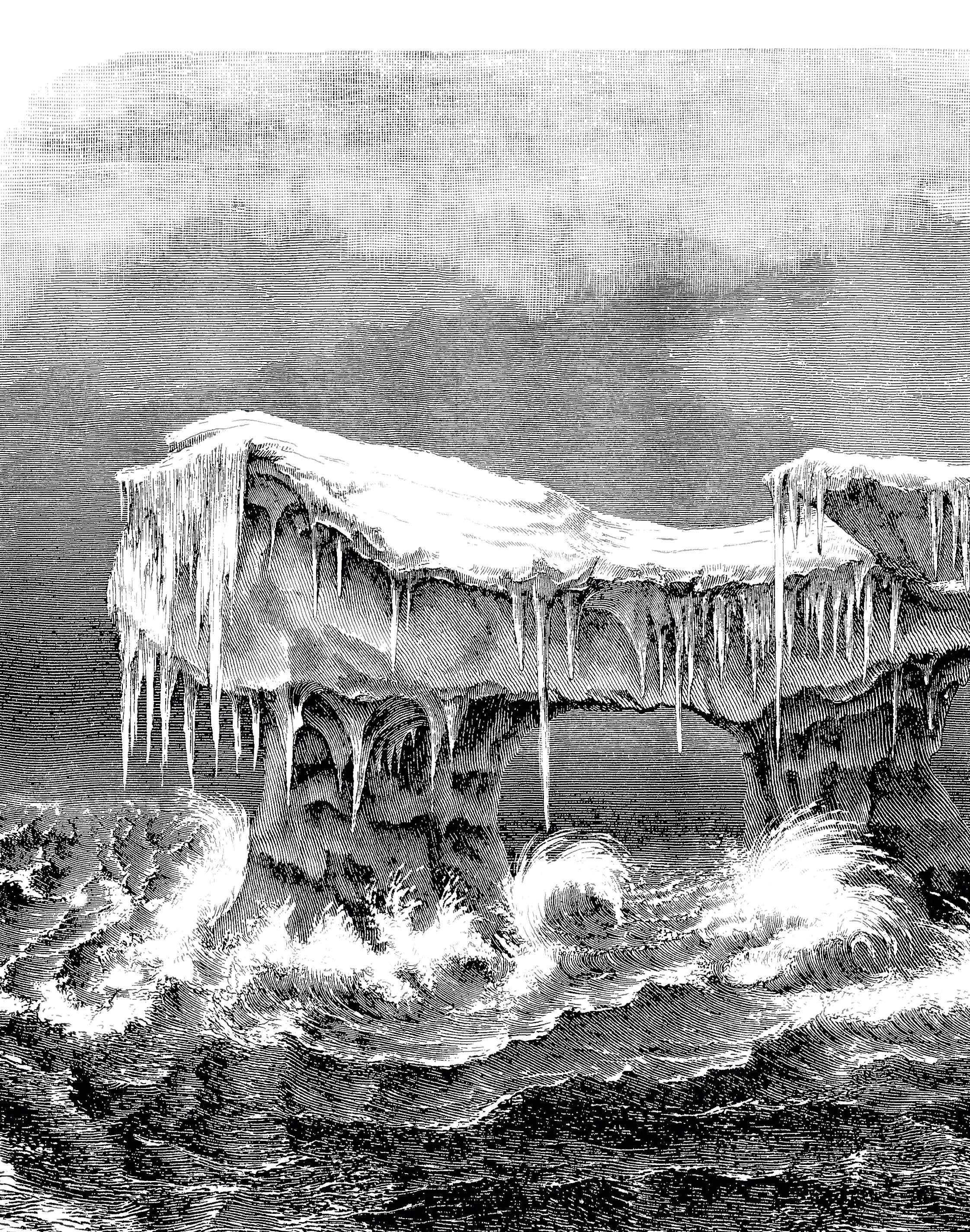
1. Lake Geneva was created by a glacier Scientists are still disputing how Europe’s largest mountain lake was created.The theory that appears to enjoy the greatest consensus is that Lake Geneva was formed by the movements of the Rhone glacier throughout the different phases of glaciation. The lake itself would only appear to have seen the light of day with the retreat of the glacier roughly 15,000 years ago. Today, flowing east to west, the Rhone provides some 75% of the lake’s water.
2. Lake Geneva has already experienced extreme meteorological events
Take the tsunami that swept through it in the year 563, for example. The wave reached a height of thirteen metres in Lausanne and eight in Geneva, most probably as the result of a mountain slope collapsing. The rocks didn’t fall directly into the lake, as we might imagine, but caused a landslide in the Rhone delta, displacing massive amounts of matter. These in turn generated huge volumes of water which caused the infamous wave.
3. Lake Geneva stays afloat
The level of the lake is closely linked to the melting of the glaciers and the drying of the rivers, two phenomena which are themselves most probably the result of climate change. In recent years, we have seen a succession of dry seasons and impressive summer heat waves, but the level of Lake Geneva has remained stable. This is doubtless thanks to its size (582.4 km2, 72.8 km long and 308.99 m deep). Smaller lakes, such as Lake Annecy in France and Lac de Bret in the canton of Vaud, have suffered terribly from these circumstances.
4. Lake Geneva is becoming warmer
The International Commission for the Protection of the Waters of Lake Geneva (CIPEL) – a FrancoSwiss intergovernmental commission tasked with monitoring the changes in the quality of the water in the lake, the Rhone and their tributaries – keeps a very close eye on their temperature. On the surface, this has increased by 2°C over the past 46 years, from an annual average of 10.9°C at a depth of 5 m in 1970 to 12.9°C in 2016. “This change has consequences for the way in which the ecosystem works.The arctic char, for example, reproduces in waters measuring 8°C at a depth of between 50 and 100 m. However, the ideal spawning conditions no longer exist at the required time.They will shift over time,” explains Audrey Klein, Secretary General of the CIPEL. Other species were monitored two years ago, but there is as yet insufficient hindsight to interpret the information. In the long term, the idea is to adapt the fishing season to these changes.
5. Lake Geneva is under pressure
The waters of the lake are considered to be clean, but the authorities remain vigilant. In 2020, the CIPEL will launch a new action plan targeting micro pollutants – substances that are too small to be trapped by the filters in waste water treatment stations (STEP). Derived from medicines or phytosanitary products, they are primarily thrown away by households, industry and agriculture. Varying considerably, they are found in smaller quantities than the infamous PCs, which are now prohibited, traces of which can nevertheless still be found. Problem: as they decompose, they can give rise to even more dangerous substances.

6. Lake Geneva is not immune to the scourge of plastics
Like all continental waters, Lake Geneva is polluted by plastics. The Association pour la sauvegarde du Léman (ASL) has just published the results of a study illustrating that some 50 tonnes of plastic find their way into the lake every year. A large proportion of it remains there, representing a risk for the entire food chain. It comes from storm drains, run-off water, direct dumping, waste water and atmospheric fallout. Not all plastics are equal. Micro- and nanoplastic, measuring between 5 and 0.001 mm in the case of the former and less than 0.001 mm in the case of the latter, are not trapped by STEP filters. Larger than 5 mm, macroplastics are trapped in the STEPs. Regular cleaning operations are organised for Lake Geneva. Net’Léman, organised last March by ASL, brought together 1,000 volunteers who removed more than 5,500 kg of all kinds of waste from the lake. Naturally, the ideal solution would be to remember that the lake is not a dustbin.
7. Lake Geneva is no longer threatened by phosphates
During the 1980s, phosphates were the lake’s main enemy.They were also the leading cause of eutrophication – or deoxygenisation – of the water, a phenomenon that the CIPEL has endeavoured to reverse since it was founded in 1962. Successfully as it happens, as the phosphorus content – which increased from less than 15 µg/l before 1960 to 89.5 µg/l in 1979 – had been pegged back again to approximately 18 µg/l in 2017. While this is still a little below the objective set, which involved reducing the average concentration to 15 μg/l to ensure the sustainable limitation of algae growth, the lake is nevertheless on the right road.
8. Lake Geneva is lacking oxygen at depth Deep under the surface, oxygen concentrations should still exceed 4 mg/l in order to prevent phosphorous escaping from the sediment. This level also ensures that aquatic life can thrive. To this end, the lake needs to be “stirred” on a regular basis. Unfortunately, this natural phenomenon is
occurring less and less frequently. During the winter of 2016-2017, the meteorological conditions only allowed a partial stirring down to a depth of 190 m. This meant that the concentrations of oxygen remain far too low at a depth of 309 meters.
9. A warmer Lake Geneva = more sun and less stratus?
Over the past few decades, Météosuisse has observed a reduction in stratus clouds and an increase in winter sunshine.That’s not the cause for celebration that it might seem: “It is difficult to assert whether or not these phenomena are genuinely linked to global warming.What is certain, on the other hand, is that the number of hot and dry periods is increasing, causing more violent storms,” stresses Mikhaël Schwander of Météosuisse. He recalls that 2018 was the warmest year on record since measures were first taken some 150 years ago.
10. Lake Geneva serves as a means of both heating and cooling Naturally, because in winter it restitutes the heat accumulated during the warmer weather, thereby giving rise to milder temperatures in the surroundings and to refreshing conditions in summer due to the reverse effect. Several installations also use the temperatures of the lake’s deep water to heat or cool buildings. In Geneva, the Geneva Lake of Nations (GLN) thermal system calls on the international organisations and the companies of the Nations and Séchero districts. Still in Calvin’s city, the Genilac project aims to heat houses and commercial properties in the city centre by 2021. It should be extended to the airport sector in 2022.This vast hydrothermal network is designed to carry lake water (pumped at a depth of 45 m where the temperature is stable all year round) directly to buildings so that employees can keep cool. Combined with high-performance heat pumps, this system can also be used to warm them. It should reduce CO2 emissions linked to the use of fossil fuels by 25% by 2020. It should be noted that after a cycle, the water returns to the ambient environment at temperature (3°C in winter and 15°C in summer) so as not to disturb the flora and fauna. ✵
FÊTE DES VIGNERONS 2019
La Fête des Vignerons, c’est un spectacle grandiose, mais aussi une grande manifestation populaire qui égayera toute la ville de Vevey du 18 juillet au 11 août 2019. Un événement qui figure au Patrimoine immatériel mondial de l’Unesco depuis 2016.
TEXTE: MÉLANIE BLANC
Début 2019, la ville de Vevey a été classée parmi les 52 destinations à visiter cette année par le prestigieux NewYork Times. La raison? La Fête des Vignerons, qui aura lieu cet été du 18 juillet au 11 août. Une manifestation qui n’a lieu que trois à quatre fois par siècle et qui réunit des centaines de milliers de personnes afin de célébrer les vignerons et l’art de la vigne. La 12e édition qui se tiendra cette année promet d’être encore plus spéciale que les précédentes. Les organisateurs osent même affirmer que, durant un mois, Vevey deviendra la capitale de la Suisse avec son gigantesque spectacle, mais aussi, et surtout, avec la présence de chaque canton à l’occasion des «journées cantonales» organisées pour la première fois.
Les origines de la fête
L’origine de la Fête des Vignerons remonte probablement au XVII e siècle. A cette époque, la Confrérie des vignerons clôt son assemblée générale par une parade qui conduit ses membres, accompagnés de nombreux curieux, des hauts de la ville de Vevey jusqu’au bord du lac Léman, où est dressé un banquet. Cette joyeuse fête ne cesse de grandir au fil du temps. Ses coûts aussi, raison pour laquelle elle se déroule ensuite tous les trois, puis six ans.
La dernière parade de la Confrérie a lieu en 1791. C’est six ans plus tard, en 1797, qu’ont lieu la première Fête des Vignerons et son tout premier spectacle, sur une scène dressée sur la place du Marché. La fête n’a dès lors lieu qu’une fois par génération. En 1797, les estrades peuvent accueillir 2000 spectateurs. En 1889, plus de 12 000 per-
sonnes s’installent dans les gradins. En 1955, le cap des 16 000 spectateurs est atteint. Cette année, 20 000 personnes pourront assister à chacune des 20 représentations. Cette fête, qui incarne les notions de transmission et de dialogue entre les générations, figure sur la liste du Patrimoine immatériel mondial de l’Unesco depuis décembre 2016. Elle rejoint ainsi Lavaux, le vignoble voisin, classé en 2007.
De 3 à 86 ans
La mise en scène du spectacle a été confiée à Daniele Finzi Pasca. Ce Tessinois a notamment travaillé pour le Cirque du Soleil et le Cirque Eloize et a créé les cérémonies de clôture des Jeux olympiques de Turin en 2006 et de Sotchi en 2014. Pour la Fête des Vignerons, il a imaginé l’histoire d’un grand-père et sa petite-fille, au fil des saisons. Un voyage initiatique au cours duquel l’enfant découvre le mystère qui la relie à son grand-père et à la terre. Ce spectacle poétique et ludique se déroulera dans une arène enveloppant les spectateurs dans un gigantesque nid. La grande scène centrale de 1400 m2 sera entourée de quatre scènes surélevées de 300 m 2 chacune, permettant de créer des tableaux plus intimistes. Pas moins de 700 t de charpente ont été nécessaires pour construire cette gigantesque structure. Et ce sont plus de 5400 acteurs figurants amateurs, âgés de 3 à 86 ans, qui fouleront les plateaux de l’immense arène de la place du Marché. Si les deux tiers d’entre eux participent à la fête pour la première fois, une trentaine en sont à leur quatrième édition. Autre moment très attendu du show, le Ranz des vaches, interprété par un collectif de onze ténors amateurs. Cette
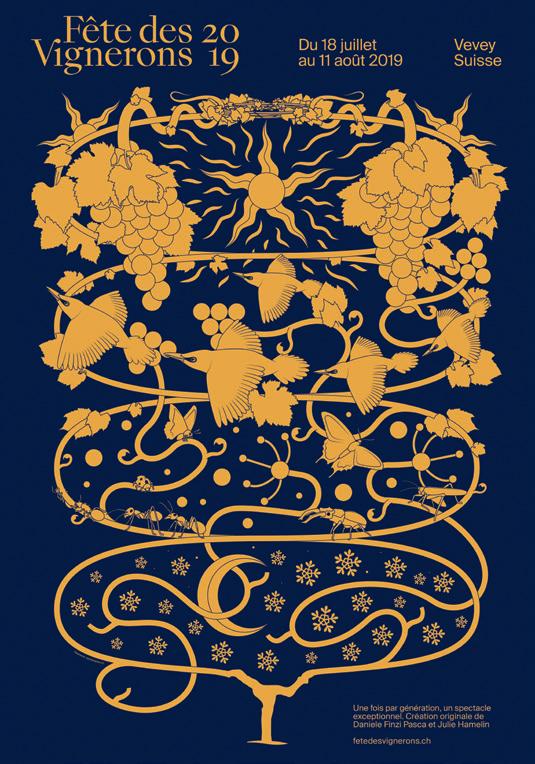

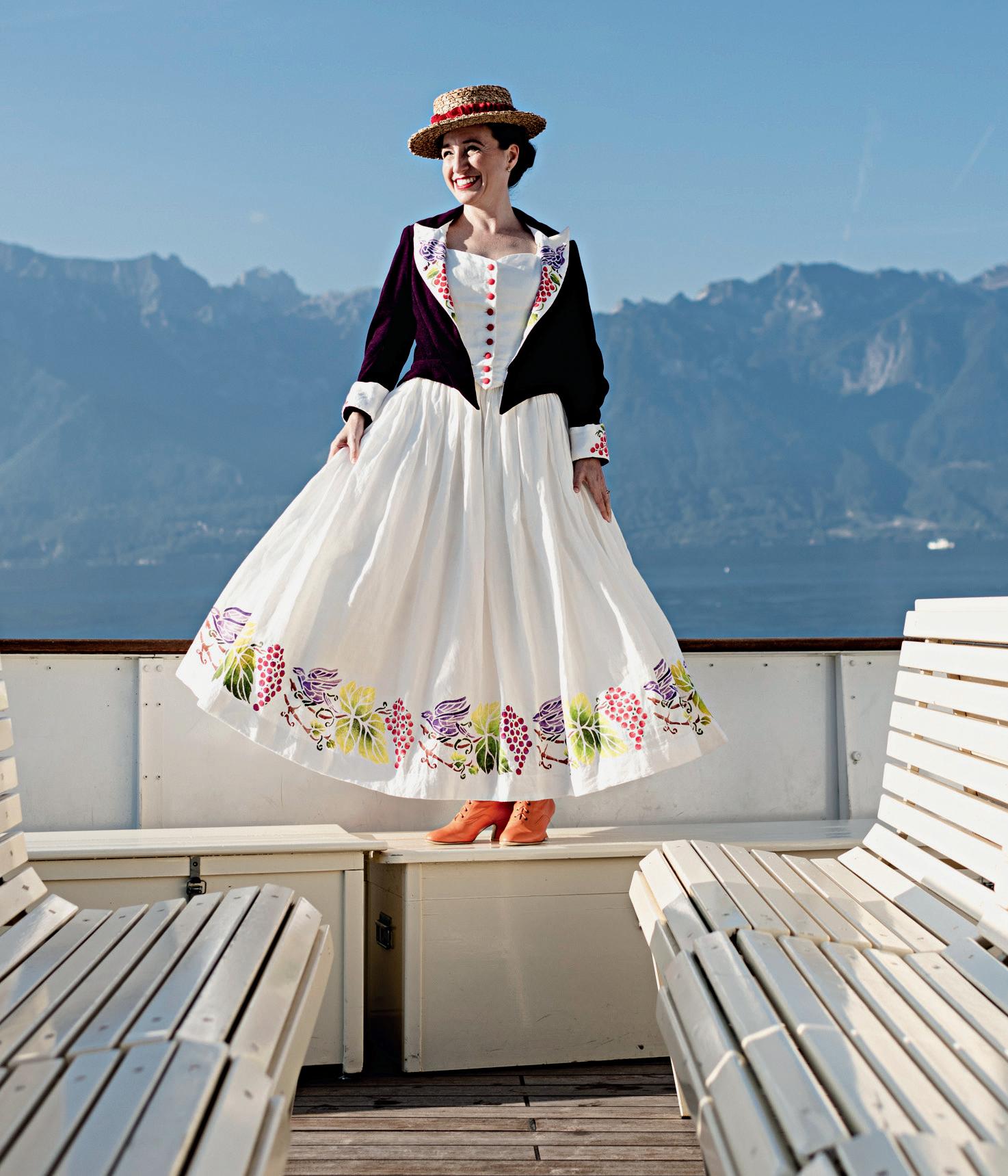

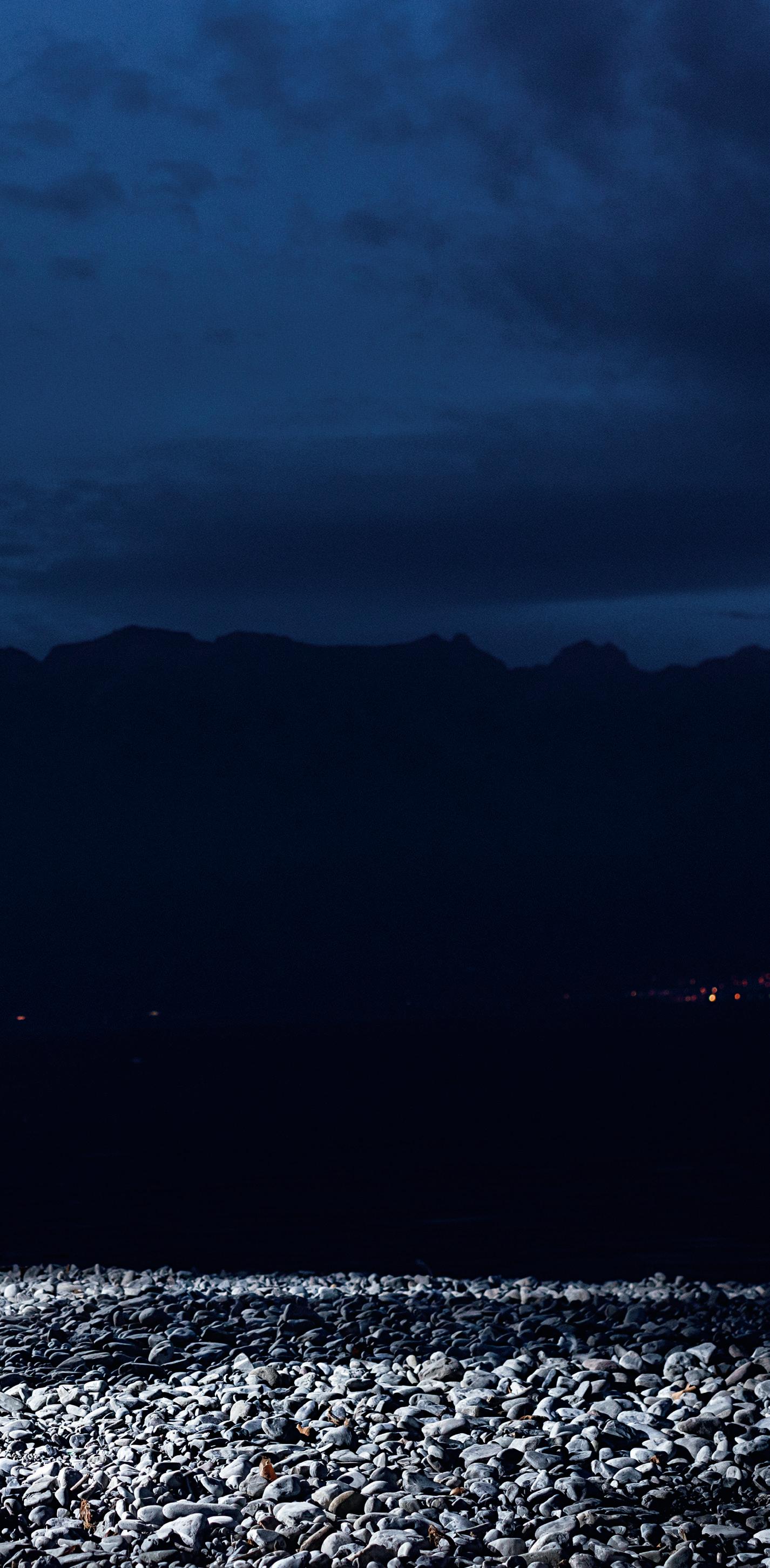
chanson de vachers et de bergers d’alpage a presque été élevée au rang d’hymne national vu l’engouement populaire qu’elle suscite.
Bien plus qu’un spectacle
Pour la «Journée de la Confédération» se déroulant le jeudi 1er août 2019, l’ABVL et la CGN ont le plaisir de vous faire gagner 2 x 5 billets Catégorie Premium
(d’une valeur totale de Fr. 3600.–) en répondant à la question suivante… En quelle année s’est tenue la toute première Fête des Vignerons?
Envoyez votre réponse…
PAR INTERNET: www.abvl.ch/concours FEVI2019 en remplissant le formulaire en ligne
PAR COURRIER: ABVL, Concours FEVI2019, Case postale 60, 1001 Lausanne en précisant nom, prénom, adresse complète, téléphone et e-mail.
Conditions de participation
Le concours a lieu du dimanche 14 avril 2019 à 12 h au mardi 2 juillet 2019 à 12 h. Il est ouvert à toute personne de 18 ans révolus, résidant en Suisse. Les données personnelles des participants peuvent être utilisées à des fins de promotion et de marketing par la CGN et l’ABVL. Une seule participation par personne est autorisée pendant toute la durée du concours. Les collaborateurs de la CGN et de l’ABVL ainsi que leur famille ne sont pas autorisés à participer. Les prix ne peuvent être ni échangés, ni convertis en espèces. Le/la gagnant(e) sera averti(e) personnellement. Tout recours juridique est exclu.
For the «Journée de la Confédération», on thursday 1 August 2019, ABVL and CGN offer you the chance to win 2 x 5 Premium tickets
(Total value: CHF 3600.–) by answering the following question…
In which year was the very first Fête des Vignerons held?
Send your answer…
INTERNET: www.abvl.ch/concours FEVI2019 by filling out the form online POST MAIL: ABVL, Concours FEVI2019, Case postale 60, 1001 Lausanne Write surname, name, address, phone number and E-mail.
Conditions for participation
The competition will run from midday Sunday 14 April 2019 to midday Tuesday 2 July 2019. It is open to any person living in Switzerland who has already celebrated their 18th birthday. Participants’ personal data may be used by the CGN and ABVL for promotional and marketing purposes. A single participation is authorised per person throughout the entire duration of the competition. Employees of the CGN and the ABVL as well as their families are not eligible for participation. Prizes cannot be exchanged or converted into cash. The winner will be notified in person. All recourse to legal proceedings is excluded.
PHOTO: © FRED MERZ / LUNDI13 / FÊTE DES VIGNERONS.
La Fête des Vignerons, c’est aussi une grande manifestation populaire dans les rues de Vevey, rendues piétonnes pour l’occasion. Ce sont ainsi 20 000 visiteurs qui sont attendus chaque jour en marge du spectacle. Plus de 50 stands de nourriture et boisson, 8 restaurants éphémères, dont une table des chefs, un village du monde et un club de nuit attendent les visiteurs pendant toute la durée de l’événement. Accolées à la face sud de l’arène, les Terrasses de la Confrérie, la plateforme lacustre de la Confrérie des vignerons, serviront des produits du terroir vaudois, face au magnifique panorama lémanique et alpin. Les enfants ne seront pas en reste: un vaste espace leur sera dédié au jardin
Doret, avec diverses animations, parmi lesquelles des conteurs, des spectacles vivants, des clowns, un manège et une grande roue. Grande nouveauté de cette 12e édition, les «journées cantonales», au cours desquelles chaque canton suisse présentera, à tour de rôle, ses traditions culturelles, gastronomiques et viticoles. Fête nationale oblige, c’est la Confédération qui sera à l’honneur le 1er août.Vous l’aurez compris, Vevey est une destination à ne manquer sous aucun prétexte cet été! ✵
Plus d’informations sur www.fetedesvignerons.ch
Avec son ponton situé à deux pas de la place du Marché, la flotte de la CGN est un moyen de transport idéal pour accéder au cœur de la fête. En plus des croisières habituelles, la CGN propose, chaque jour de spectacle, des courses spéciales entre Lausanne et Vevey. Les horaires sont adaptés à ceux des spectacles afin de permettre aux spectateurs d’arriver tranquillement dans les arènes et de repartir tout aussi sereinement. Une course spéciale retour pour Le Bouveret est également assurée pour les spectacles qui ont lieu en soirée. Service de petite restauration à bord. Réservation obligatoire.
Tarifs pour le trajet Lausanne – Vevey Fr. 39.– (aller-retour) • Fr. 23.– (aller simple) Demi-tarif uniquement pour les enfants de 6 à 16 ans Gratuit pour les enfants de moins de 6 ans Informations et réservations sur www.cgn.ch/fevi ou via l’INFOLINE au 0900 929 929 (Fr. 0.50/min depuis la Suisse)
Rue Tavernier 9, 1170 AUBONNE
Tél. 021 807 45 50, fax 021 807 45 51, e-mail: jacsa@bluewin.ch

publicitaire o ert.




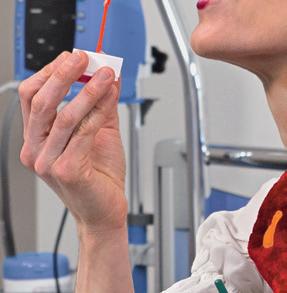




Du rire et du rêve pour nos enfants hospitalisés
Grâce à vos dons, les enfants hospitalisés reçoivent chaque semaine la visite des docteurs Rêves. Merci pour votre soutien. CCP 10-61645-5 theodora.org

FÊTE DES VIGNERONS 2019
The Fête des Vignerons is a magnificent sight and a large-scale popular event that will colour the entire town of Vevey from 18 July to 11 August 2019. It is an event which has been on the UNESCO intangible world heritage list since 2016.
TEXT: MÉLANIE BLANC
At the beginning of 2019, the town of Vevey was ranked among the 52 destinations to visit this year by the prestigious New York Times. Why? The Fête des Vignerons, which will be held this summer from 18 July to 11 August. It is an event which only takes place three or four times a century, attracting hundreds of thousands of people to celebrate winemakers and the art of winegrowing.
The 12th edition, which will be held this summer, promises to be even more special than previous editions. The organisers even make the bold claim
that for one month, Vevey will become the capital of Switzerland not only thanks to its large-scale event but also, and more particularly, due to the presence of each canton in the “cantonal days” organised this year for the very first time.
The origins of the festival
The origin of the Fête des Vignerons can probably be traced back to the 17th century. In those days, the Brotherhood of Winemakers would bring its general assembly to a close with a parade leading its members, along with numerous curious onlookers,
from the heights of the town of Vevey to the shores of Lake Geneva where a banquet would be held. This joyful festival has continued to grow over time, as have its costs, which is why it was held every three years then every six. The last parade of the Brotherhood was held in 1791. Six years later, in 1797, the first Fête des Vignerons was held along with its first show, on a stage raised on the market square. The festival is now only held once a generation. In 1797, the stages could hold up to 2,000 people. And in 1889, more than 12,000 people took their place in the stands. In 1955, the milestone figure of 16,000 spectators was reached.This year, some 20,000 people could attend each of the 20 performances. This festival, which embodies the notions of transmission and dialogue between generations, was included on the UNESCO intangible world heritage list in December 2016. It therefore joins Lavaux, the neighbouring vineyard, which was classified in 2007.
From 3 to 86
Production of the show has been entrusted to Daniele Finzi Pasca.This native of Ticino has worked for the Cirque du Soleil and the Cirque Eloize and also created the closing ceremonies for the 2006 and 2014 Olympic Games in Turin and Sotchi respectively. For the Fête des Vignerons , he has dreamed up the story of a grandfather and his granddaughter as the seasons come and go. An initiatory journey during which the child discovers the mystery binding her to her grandfather and the Earth.This fun, poetic show will be held in an arena wrapping the spectators in a gigantic nest. Measuring 1,400 m², the large central stage will be surrounded by four raised daises each measuring 300 m2 and enabling more intimate tableaux to be created. Some 700 tonnes of wood were needed to build this enormous stage. And more than 5,400 amateur extras, aged between 3 and 86, will swarm across the stages of the huge arena on the market square. While two-thirds of them are participating in the festival for the first time, some thirty people will be taking part in their fourth edition. Another much-awaited moment of the show is the Ranz des vaches, performed by a group of eleven amateur tenors. This song of the cowhands and shepherds of the alpine pastures has almost become a national hymn in light of the popularity of the song.
So much more than a show
The Fête des Vignerons is also a large-scale popular event in the streets of Vevey, which are made into pedestrian streets for the occasion. Some 20,000 visitors are expected each day alongside the show. More than fifty food and drinks stands, eight transient restaurants including a table of chefs, a world village and a nightclub await visitors during the course of the event. Along the southern end of the arena, “Les Terrasses de la Confrérie” – the riparian platform of the Brotherhood of Winemakers – will serve local Vaud products against the magnificent backdrop of Lake Geneva and Alpine summits. And there will be plenty for children to do too: a huge play area will be available to them at the Jardin Dore, with a range of events including storytelling, live entertainment, clowns, a merry-go-round and a big wheel. A new development this year are the “cantonal days”, during which each Swiss canton will take turns presenting their cultural, gastronomic and winemaking traditions. On the occasion of the national day on 1 August, he Confederation will be given pride of place. It is clear, then, that Vevey is a must-see destination this summer! ✵
More informations at www.fetedesvignerons.ch
With its pontoon located only a stone’s throw from the market square, the CGN fleet is an ideal means of getting to the very heart of the festival. In addition to the usual cruises, the CGN runs a special return trip every showday between Lausanne and Vevey. The times fit with those of the show to enable spectators to make their way comfortably to the arena and to leave just as easily. A special return trip to Le Bouveret is also operated for evening shows.
Small catering service on board. Reservations required.
Fares Lausanne – Vevey CHF 39.– (return) • CHF 23.– (single) Half price for children aged 6 to 16. Free for children under 6. Information and bookings at www.cgn.ch/fevi or via the INFOLINE on 0900 929 929 (CHF 0.50/min from Switzerland)


/ FÊTE DES VIGNERONS 2019


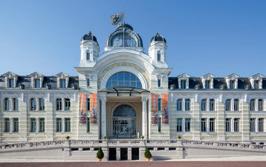
Le Palais Lumière
Quai Besson
F-74500 Evian
Tél. +33 450 83 15 90

Ouvert du mercredi au dimanche de 10 h à 18 h lundi et mardi de 14 h à 18 h
➡ www.palaislumiere.fr

Musée historique de Vevey
Rue du Château 2
1800 Vevey
Tél. +41 21 925 51 64
Ouvert du mardi au dimanche de 11 h à 17 h et les lundis fériés.
➡ www.museehistoriquevevey.ch

Jardin des Cinq Sens
Rue du Lac
F - 74140 Yvoire
Tél. +33 450 72 88 80
Ouvert du 12 avril au 6 octobre 2019.
➡ www.jardin5sens.net

Le Musée Olympique
Quai d’Ouchy 1 1006 Lausanne
Tél. +41 21 621 65 11
01.05 au 14.10, ouvert tous les jours de 9 h à 18 h; 15.10 au 30.04, ouvert du mardi au dimanche de 10 h à 18 h; fermé les lundis, sauf lundi de Pâques. Fermé le 25 décembre et le 1er janvier.
➡ www.olympic.org/musee
La Maison du Gruyère
Place de la Gare 3 1663 Pringy-Gruyères
Tél. +41 26 921 84 00
Horaire:
Ouvert tous les jours de 9 h à 18 h (18 h 30 de juin à septembre).
➡ www.lamaisondugruyere.ch
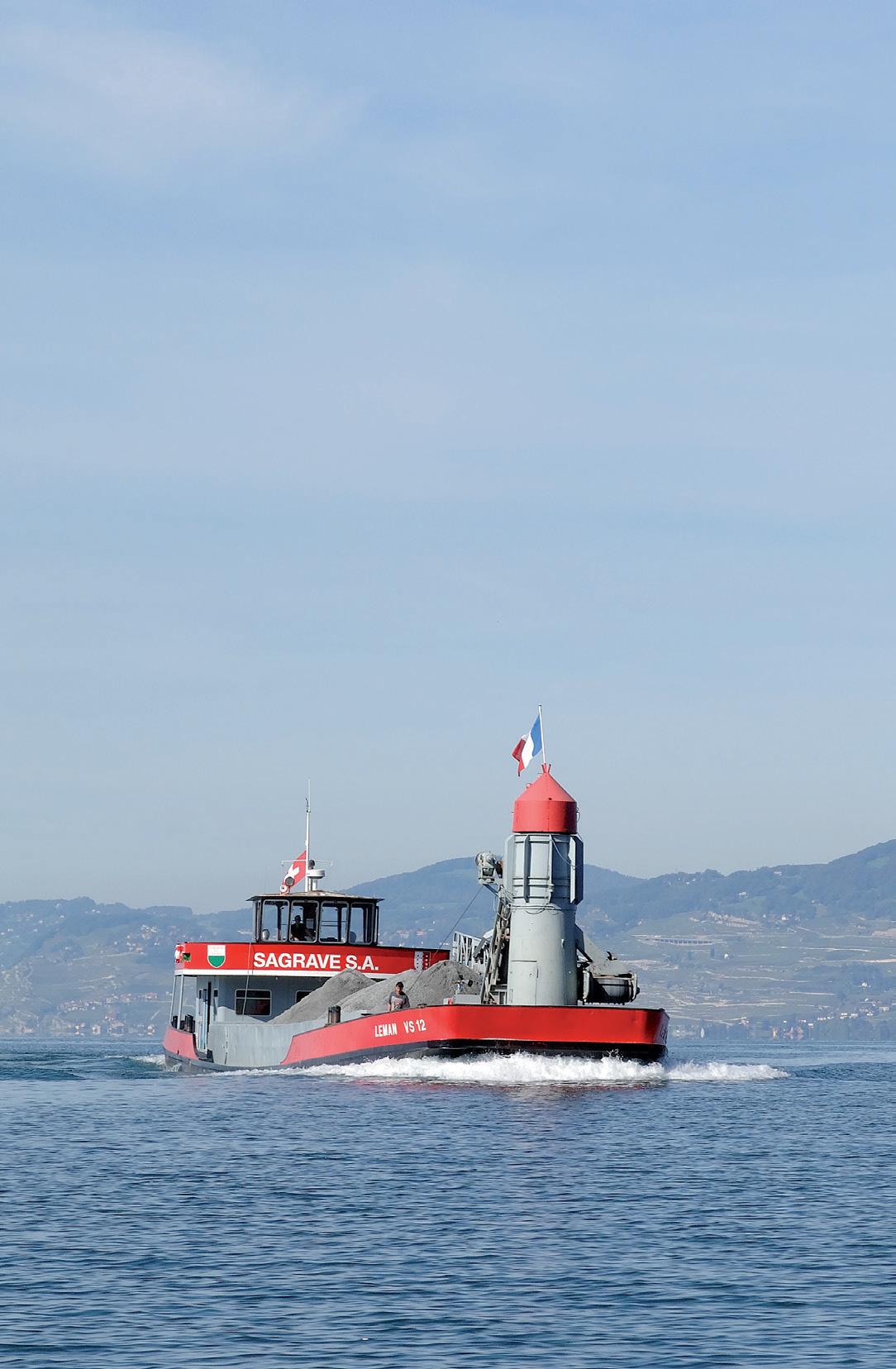

SIÈGE Perrin Frères SA case postale 1331 1260 Nyon 1 Bureau: 1196 Gland
tél. 022 354 43 43 fax 022 354 43 63
SUCCURSALES
LAUSANNE
ch. de Chantemerle 14
tél. 021 646 70 26 ROLLE
rte de Lausanne 7 tél. 021 825 46 11
GENÈVE / PLAN-LES-OUATES
ch. de Trèfle-Blanc 14-16
tél. 022 850 02 90
GÉNIE CIVIL
CONSTRUCTION ET RÉNOVATION DE BÂTIMENTS DÉMOLITION ET DÉSAMIANTAGE CONSEIL ET ÉTUDES TECHNIQUES DÉVELOPPEMENT DURABLE
www.perrin-freres.ch Nyon | Lausanne Rolle Plan-les- Ouates

PERRIN_ann_A5V_demolition desamiantage_2_couleurs
POUR MOUSSAILLONS FUTÉS FOR BRAINY BUCCANEERS
3, 2, 1: partez! A toi de jouer… 3, 2, 1: go! It’s your turn to play…
Trouve les sept différences qui se sont glissées entre les deux illustrations ci-dessus.
Catch the differences
Find the seven differences between the two illustrations above.

Cette année, Rolle accueillera la traditionnelle Parade navale de la CGN qui se déroulera le dimanche 19 mai 2019. Le château de Rolle, ses quais et la célèbre île de La Harpe verront défiler la flotte Belle Epoque, patrimoine unique au monde. Cette nouvelle édition sera également l’unique occasion d’admirer ensemble les six bateaux Belle Epoque engagés en service horaire cette année dont les salons de 1re classe ont été couronnés du Prix «Restaurant historique de l’année 2019»!
A terre, des stands variés sont prévus pour sustenter le public attendu en nombre. Le coup d’envoi de la chorégraphie navale sera donné à 14 h. Les six bateaux entameront leur ballet sous la direction du premier capitaine M. Olivier Chenaux. ✵
➜ Dimanche 19 mai 2019 • www.cgn.ch
This year, it is the turn of Rolle to host the CGN’s traditional Naval Parade, to be held on Sunday 19 May 2019. Rolle Castle, its quays and the famous Île de La Harpe will form the impressive backdrop as the Belle Epoque fleet – a heritage unique worldwide – sails past.
This year’s edition will also provide a unique opportunity to admire all six Belle Epoque vessels which provide a regular service across the lake this year, their first class lounges awarded the title of “Historic Restaurant of the Year 2019”!
On land, a wide range of stalls will provide food and drink for what is expected to be a large crowd. The naval choreography will begin at 2 p.m. The six boats will then perform their ballet under the direction of 1st Captain, Mr. Olivier Chenaux. ✵
➜ Sunday 19 May 2019 • www.cgn.ch
6/01 ➜ 7/04/2019
Croisières «Petit-Déjeuner». Tous les dimanches, prenez le grand large pour une croisière aller-retour LausanneEvian et débutez votre journée avec un petit-déjeuner lacustre tout en profitant de l’ambiance particulière qui règne sur le lac le matin.
“Breakfast” cruises. Every Sunday, climb aboard for a cruise from Lausanne to Evian and back again, and begin your day with breakfast on the lake while enjoying its unique early-morning atmosphere.
Réservation obligatoire/Reservation required: www.cgn.ch
Tél./Phone +41 (0)900 929 929 (Fr. 0.50/min.)
1/02 ➜ 17/05 (sauf le 19/04)
Croisières «Fondue». Tous les vendredis soirs, partagez une expérience unique autour d’une fondue au fromage ou chinoise à bord d’un de nos bateaux.
Au départ de Genève, Morges, Lausanne, Evian et Thonon.
“Fondue” cruises. Every Friday evening, share a unique experience around a cheese or Chinese fondue aboard one our our boats. Departures from Geneva, Morges, Lausanne, Evian and Thonon.
Réservation obligatoire/Reservation required: www.cgn.ch
Tél./Phone +41 (0)900 929 929 (Fr. 0.50/min.)
16/03

Croisière Saint-Patrick. Venez découvrir les spécialités irlandaises dans une ambiance festive au départ de Lausanne. St. Patrick’s Day Cruise. Discover a selection of Irish specialities in a festive atmosphere, departing from Lausanne.
6/04
Croisière «Tango». Venez vous déhancher au rythme des flots durant cette croisière tango au départ de Lausanne. «Tango» cruise. Sway to the rythm of the waves during this tango cruise from Lausanne.
Réservation obligatoire/Reservation required: www.cgn.ch
Tél./Phone +41 (0)900 929 929 (Fr. 0.50/min.)
14/04
Lancement de l’horaire de printemps / Start of the spring schedule
19/04 ➜ 22/04
Pâques. Embarquez depuis Genève à bord du Simplon et du Savoie, depuis Lausanne à bord de La Suisse et de nos divers débarcadères du Haut-Lac à bord de l’Italie pour une croisière pascale en famille ou entre amis.
Easter. Climb aboard the Simplon or the Savoie in Geneva, La Suisse in Lausanne or the Italie at one of our various jetties on the Upper Lake for an Easter cruise with family or friends.
Réservation obligatoire/Reservation required: www.cgn.ch
Tél./Phone +41 (0)900 929 929 (Fr. 0.50/min.)
27/04
Assemblée générale ABVL. Salle communale de Nyon. Croisière dînatoire à bord du Simplon.
ABVL Annual General Meeting. Nyon village hall. Dinner cruise aboard the Simplon.
➜ www.abvl.ch
28/04
Croisière Jass. Venez taper le carton au gré des flots à bord du Henry-Dunant au départ de Genève. Attention, les tricheurs passeront par-dessus bord! Jass Cruise. Pull an ace from your sleeve as you float across the lake on the Henry Dunant, departing from Geneva. But beware: cheats might just be made to walk the plank!
Réservation obligatoire/Reservation required: www.cgn.ch
Tél./Phone +41 (0)900 929 929 (Fr. 0.50/min.)

5/05
Journée suisse de la navigation. Embarquez sur l’un de nos bateaux Belle Epoque ou contemporain et profitez d’une journée hors du temps à un tarif unique exceptionnel!
Swiss Navigation Day. Climb aboard one of our Belle Epoque or contemporary vessels and enjoy a timeless day at an exceptional rate!
12/05

Fête des mères. Profitez de cette journée spéciale pour faire plaisir à votre maman et embarquez sur l’une de nos croisières gourmandes.
Mother’s Day. Take advantage of this very special day to treat your mother to one our gourmet cruises.
Réservation obligatoire/Reservation required: www.cgn.ch Tél./Phone +41 (0)900 929 929 (Fr. 0.50/min.)
19/05
Parade navale à Rolle. La fête se déroulera sur les quais et à bord de six bateaux de la flotte Belle Epoque. Leur ballet aquatique sera visible depuis les rives dès 14 h. L’occasion de profiter des stands, des animations et de la restauration proposés à quai.
The Naval Parade in Rolle. The festivities will take place on the quays and aboard the six boats of the Belle Epoque fleet.Their aquatic ballet will be visible from the shore from 2 p.m. onwards. It is the perfect opportunity to take advantage of the stalls, entertainement and food on shore.
Réservation obligatoire pour la restauration et conseillée sans restauration/Reservation required for catering and recommended without catering
23/05 ➜ 13/06
Croisières «Raclette». Tous les mardis et jeudis soirs, venez déguster une délicieuse raclette à bord de La Suisse au départ de Lausanne. “Raclette” cruises. Come and enjoy a delicious raclette every Tuesday and Thursday evening aboard La Suisse, departing from Lausanne.
Réservation obligatoire/Reservation required: www.cgn.ch
Tél./Phone +41 (0)900 929 929 (Fr. 0.50/min.)
23/05 ➜ 21/09
Croisière gourmande du soir «La Table du Chef» à bord du Savoie. A bord du Savoie, prenez le temps de déguster un délicieux repas dans un cadre féérique.
Evening gourmet cruise «The Chef’s Table» aboard the Savoie. Take the time to enjoy a delicious meal in a magical atmosphere.
25/05
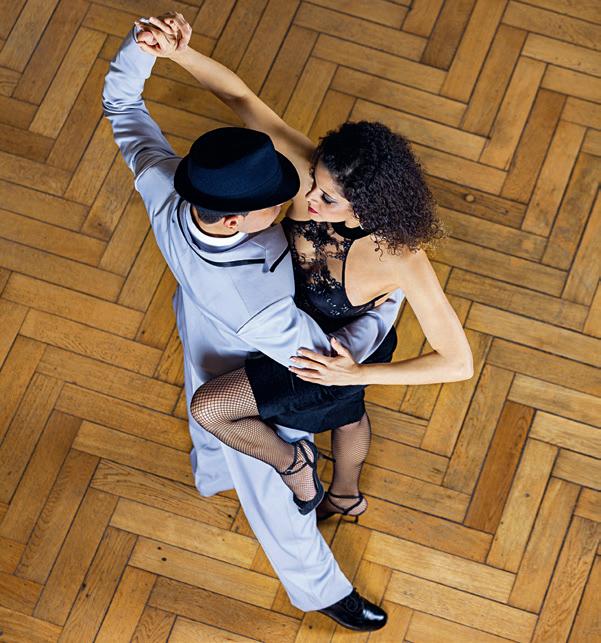
Croisière «Tango». Venez vous déhancher au rythme des flots durant cette croisière tango au départ de Genève. “Tango” cruise. Sway to the rhythm of the waves during this tango cruise, departing from Geneva.
Réservation obligatoire/Reservation required: www.cgn.ch
Tél./Phone +41 (0)900 929 929 (Fr. 0.50/min.)
26/05
Croisière «Jass». Venez taper le carton au gré des flots à bord du Général-Guisan au départ de Lausanne. Attention, les tricheurs passeront par-dessus bord! “Jass” Cruise. Pull an ace from your sleeve as you float across the lake on the Général-Guisan, departing from Lausanne. But beware: cheats might just be made to walk the plank!
Réservation obligatoire/Reservation required: www.cgn.ch
Tél./Phone +41 (0)900 929 929 (Fr. 0.50/min.)
29/05
MAD Boat. Le MAD organise depuis plus de dix ans des soirées pour les clubbers au pied lacustre. Jusqu’à un millier de personnes sont accueillies à bord de ce club flottant.
MAD Boat. For more than ten years, the MAD has been organising evenings for clubbers with sea legs.There is room for up to 1,000 people on this floating night club.
➜
7/06
Assemblée générale CGN / CGN Annual General Meeting SwissTech Convention Center.
15/06
Bol d’Or Mirabaud. Depuis plus de 80 ans, le lac Léman accueille une impressionnante régate à laquelle participent près de 600 voiliers. Evénement incontournable, le Bol d’Or est ainsi devenu la plus importante régate en bassin fermé du monde.
Bol d’Or Mirabaud. For more than 80 years, Lake Geneva has hosted an impressive regatta with almost 600 yachts participating. A must-see event, the Bol d’Or has become the world’s largest regatta in a closed basin.
➜ www.boldormirabaud.com
16/06
Lancement de l’horaire d’été/ Start of the summer schedule
16/06 ➜ 1/09
Croisières «Afterwork». Venez partager un moment entre collègues ou amis sur le Léman. Tous les jours au départ de Genève.Tous les mardis, mercredis et jeudis au départ de Lausanne à bord du Vevey (excepté du 18/07 au 8/08).
“After work” cruises. Come and share a moment with friends or colleagues on Lake Geneva. Daily departures from Geneva and departures every Tuesday and Thursday from Lausanne aboard the Vevey (excepting from 18/07 to 8/08).
16/06 ➜ 1/09
Croisière «La Table du Beau-Rivage Palace». Durant l’été, du mardi au samedi, les chefs du Beau-Rivage Palace vous préparent de sublimes buffets aux saveurs méditerranéennes. Une croisière du soir 5* de Lausanne à Yvoire et retour. “The Table of the Beau-Rivage” cruises. All summer long, from tuesday to saturday, the chefs of the Beau-Rivage Palace hotel prepare sublime buffets with a Mediterranean flavour.A five-star evening cruise from Lausanne toYvoire and return.
➜ www.cgn.ch
21/06 ➜ 30/08
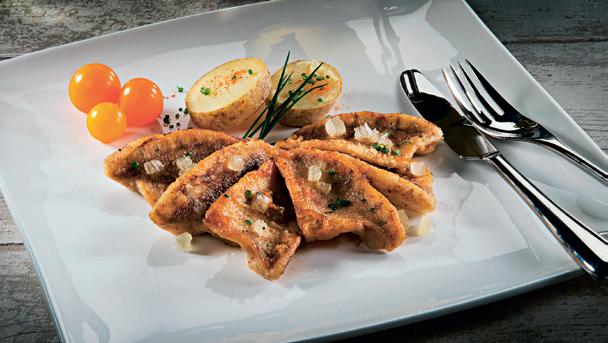
Croisière «Perches au large». Tous les vendredis, au départ de Lausanne et Genève (pas de croisière à Lausanne, pendant la Fête des Vignerons, du 18/07 au 11/08).
“Perch fillets” cruise. Every friday, departing from Lausanne and Geneva (except during the Fête des Vignerons, from 18/07 to 11/08).
Love Boat. L’espace d’une soirée, le bateau Lausanne se transforme en club éphémère. Une croisière avec une ambiance exceptionnelle.
Love Boat. For one evening, the Lausanne is transformed into an ephemeral club. A cruise with an extraordinary ambiance.
➜ www.dclub.ch
29 ➜ 30/06
450 ans d’amitié franco-suisse à Saint-Gingolph. La fête se déroulera sur les quais de Saint-Gingolph. Au programme, croisière à bord de l’Italie, parade de voiles latines, feux d’artifice, stands et animations.
450 years of Franco-Swiss friendship in St-Gingolph. The festivities will be held on the quays of Saint-Gingolph.The programme includes a cruise on the Italie, a Lateen sails parade, fireworks, stands and other entertainment.
➜ www.450ans.st-gingolph.com
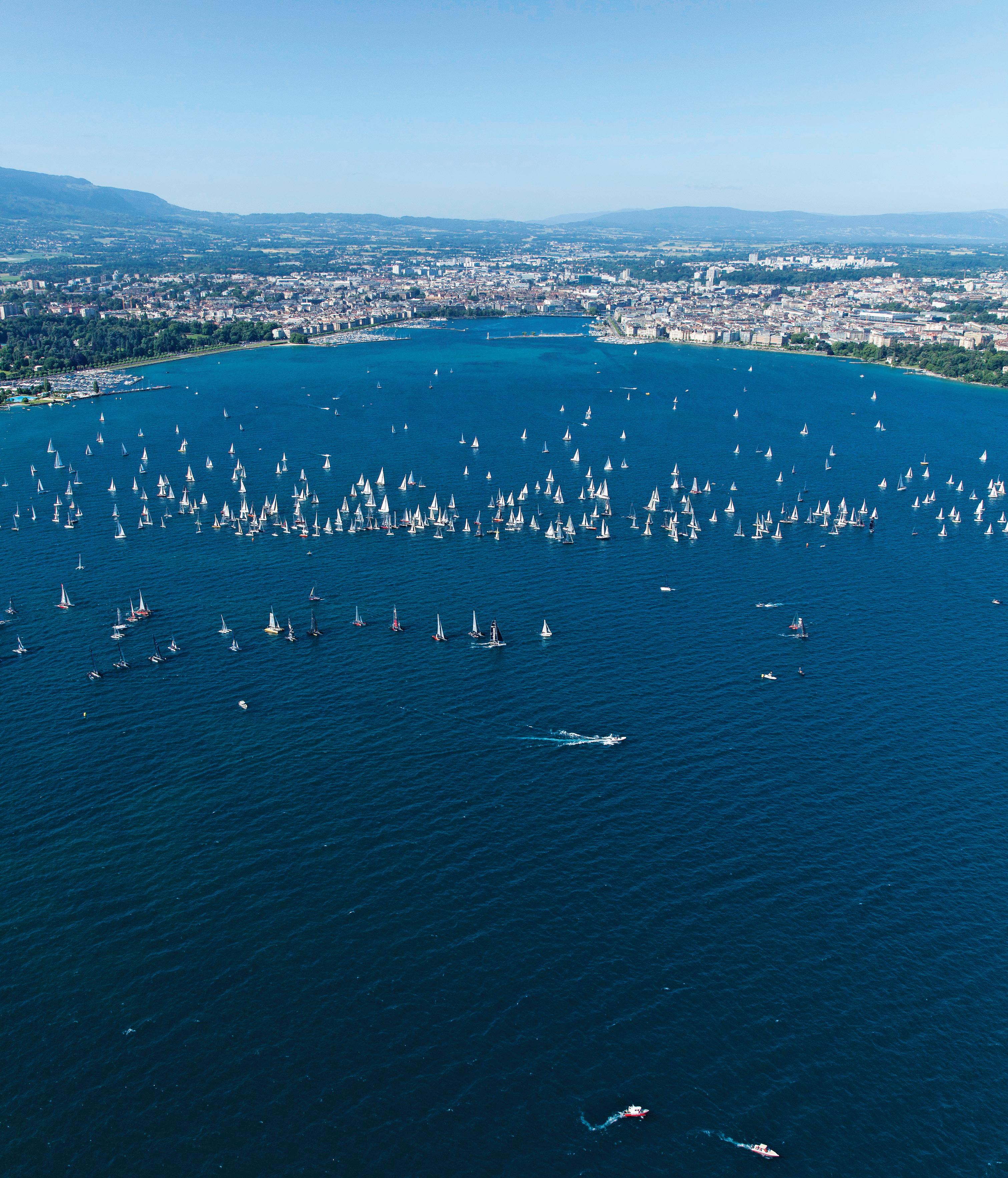
28/06 ➜ 13/07
Montreux Jazz Boat. Le Montreux Jazz vous propose des croisières thématiques à bord du magnifique bateau Lausanne.
Montreux Jazz Boat. The Montreux Jazz Festival proposes a number of themed cruises aboard the magnificent Lausanne.
➜ www.montreuxjazzfestival.com
11/07 + 31/07
MAD Boat. Le MAD organise depuis plus de dix ans des soirées pour les clubbers au pied lacustre. Jusqu’à un millier de personnes sont accueillies à bord de ce club flottant.
MAD Boat. For more than ten years, the MAD has been organising evenings for clubbers with sea legs.There is room for up to 1,000 people on this floating night club.
➜ www.madclub.ch
14/07
Croisière feux d’artifice, Fête nationale française. Une croisière spéciale vous conduit à proximité d’Evian où vous bénéficiez d’une vue spectaculaire sur les premiers feux d’artifice de la saison.
Fireworks cruise, French Bastille Day. A special cruise will take you offshore from Evian where you can enjoy the first spectacular fireworks display of the season.
Réservation obligatoire/Reservation required: www.cgn.ch
Tél./Phone +41 (0)900 929 929 (Fr. 0.50/min.)
18/07 ➜ 11/08
En bateau à la Fête des Vignerons 2019. La fête débute dès votre départ! Profitez en famille, avec vos amis de nos croisières spéciales Fête des Vignerons qui vous permettront de débarquer au cœur de la fête!
By boat to the Fête des Vignerons 2019. The festivities begin as soon as we cast off! Enjoy our special Fête des Vignerons cruises with family or friends, arriving at the very heart of the festival!
Réservation obligatoire/Reservation required: www.cgn.ch/fr/fevi
Tél./Phone +41 (0)900 929 929 (Fr. 0.50/min.)
31/07
Croisière feux d’artifice au Bouveret. A bord de l’Italie profitez d’une croisière avec vue sur les Alpes et les feux d’artifice.
Fireworks cruise to Le Bouveret. Enjoy a cruise aboard the Italie with a view of the Alps and the fireworks.
Réservation obligatoire/Reservation required: www.cgn.ch
Tél./Phone +41 (0)900 929 929 (Fr. 0.50/min.)
1/08
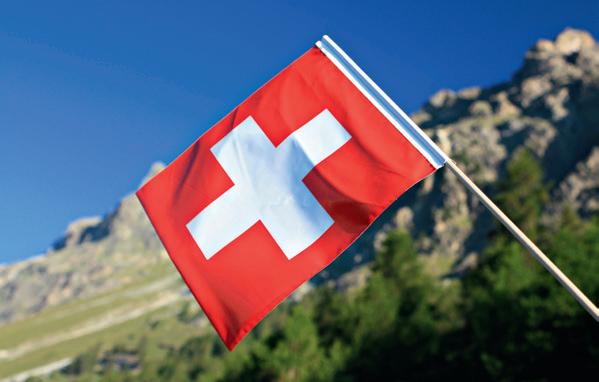
Fête nationale suisse. Le bateau La Suisse vous emmène pour une croisière gourmande qui se termine en beauté avec les magnifiques feux d’artifice de Lausanne. Depuis le lac, vous êtes aux premières loges pour regarder le spectacle. Swiss National Day. The flagship of the Belle Epoque fleet, La Suisse will take you on a gourmet cruise ending in style with the superb firework display over Lausanne. From the lake, you will have the best seats in house to enjoy the show.
Réservation obligatoire/Reservation required: www.cgn.ch
Tél./Phone +41 (0)900 929 929 (Fr. 0.50/min.)
10/08

Feux d’artifice des Fêtes de Genève. La CGN propose une place exceptionnelle à bord du Savoie à quai pour admirer les feux d’artifice pyromélodiques. Fireworks to the Geneva Festival. The CGN offers an exceptional viewpoint on board Savoie to admire the musically-underscored fireworks.
Réservation obligatoire/Reservation required: www.cgn.ch
Tél./Phone +41 (0)900 929 929 (Fr. 0.50/min.)
15/08
Croisière feux d’artifice, Libération d’Evian. Vous n’avez pas encore pu vous émerveiller devant ces cieux illuminés? Embarquez de Lausanne et Evian pour une croisière en direction du dernier show pyrotechnique de l’année dans la région lémanique. Liberation of Evian fireworks cruise. Did you miss your chance to admire the illuminated skies? Climb aboard in Lausanne or Evian for a cruise to the last firework display of the year in the Lake Geneva region.
Réservation obligatoire/Reservation required: www.cgn.ch
Tél./Phone +41 (0)900 929 929 (Fr. 0.50/min.)
31/08
Paradise Boat. Dans une atmosphère unique, des DJ tendance et une foule de noctambules rempliront les ponts du bateau Lausanne transformés en dancefloor pour la soirée.
Paradise Boat. In a unique atmosphere, trendy DJs and a crowd of joyous night revellers will pack the decks of the Lausanne, transformed into a giant dance floor for the evening.
➜ www.paradise-event.ch
2/09
Lancement de l’horaire d’automne/ Start of the autumn schedule 3/09 ➜ 19/09

Croisières «Raclette». Tous les mardis et jeudis soirs, venez déguster une délicieuse raclette à bord de La Suisse au départ de Lausanne.
“Raclette” cruises. Come and enjoy a delicious raclette every Tuesday and Thursday evening aboard La Suisse, departing from Lausanne.
Réservation obligatoire/Reservation required: www.cgn.ch
Tél./Phone +41 (0)900 929 929 (Fr. 0.50/min.)
5/09
Foire de Crête. Rejoignez facilement Thonon. La CGN affrète spécialement un bateau pour permettre aux visiteurs d’accéder au cœur de cette foire traditionnelle et ainsi profiter de toutes ses animations.
Crête Fair. An easy way to get to Thonon: the CGN will organise a special boat to enable visitors to access the heart of this traditional fair and thus take advantage of its many attractions.
6/09

Croisière «Lake & Date». Croisière en partenariat avec «célibataire.ch». Venez trouver l’amour à bord de La Suisse au départ de Lausanne. «Lake & Date» cruise. A cruise organised in partnership with «célibataire. ch». Find love aboard La Suisse, departing from Lausanne.
➜ www.cgn.ch
Portes ouvertes au chantier naval. A l’occasion des Journées européennes du patrimoine, la CGN ouvre ses portes pour vous faire découvrir son chantier naval et le bateau à vapeur Rhône en pleine rénovation générale. Shipyard open day. On the occasion of the European Heritage Days, the CGN opens its doors and offers you the chance to explore its shipyard along with the Rhône steamer, currently undergoing a general overhaul.
27/09 ➜ 13/12
Croisières «Fondue». Tous les vendredis soirs, des fondues au fromage et des fondues chinoises sont proposées pour des soirées conviviales dans un cadre unique. Au départ de Genève, Morges, Lausanne, Evian et Thonon. “Fondue” cruises. Every Friday evening, share a convivial evening around a cheese or Chinese fondue in a unique setting. Departures from Geneva, Morges, Lausanne, Evian and Thonon.
Réservation obligatoire/Reservation required: www.cgn.ch Tél./Phone +41 (0)900 929 929 (Fr. 0.50/min.)
12/10 + 19/10
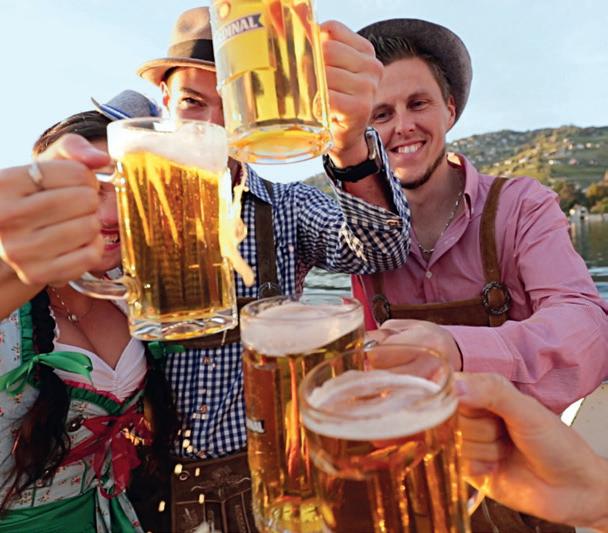
Croisières «Oktoberfest». Venez découvrir les spécialités bavaroises dans une ambiance festive, au départ de Lausanne le 12 et au départ de Genève le 19 octobre 2019.
“Oktoberfest” cruise. Discover the specialties of Bavaria in a festive atmosphere. Departing from Lausanne on 12 October and Geneva on 19 October 2019.
Réservation obligatoire/Reservation required: www.cgn.ch
Tél./Phone +41 (0)900 929 929 (Fr. 0.50/min.)
21/10
Lancement de l’horaire d’hiver/ Start of the winter schedule
21/10 ➜ 14/12

Croisières «Petit-Déjeuner». Tous les dimanches, prenez le grand large pour une croisière aller-retour LausanneEvian et débutez votre journée avec un petit-déjeuner lacustre tout en profitant de l’ambiance particulière qui règne sur le lac le matin.
“Breakfast” cruises. Every Sunday, climb aboard for a cruise from Lausanne to Evian and back again, and begin your day with breakfast on the lake while enjoying its unique early morning atmosphere.
Réservation obligatoire/Reservation required: www.cgn.ch
Tél./Phone +41 (0)900 929 929 (Fr. 0.50/min.)
8/11 ➜ 17/11

Foire aux vins de la Coop à Lausanne. Une sélection de vins de la région et du monde entier à découvrir ou à redécouvrir sur le bateau Lausanne.
Coop Wine Fair in Lausanne. A selection of wines from the region and around the world is just waiting to be discovered or rediscovered on the Lausanne.
➜ www.coop.ch/les-rois-du-vin
25/12 + 29/12 + 1/01 + 2/01/2020
Croisières fêtes de fin d’année. Un repas de fête est proposé sur nos croisières de midi.
End of the year cruises. Enjoy a festive meal on our midday cruises.
Réservation obligatoire/Reservation required: www.cgn.ch
Tél./Phone +41 (0)900 929 929 (Fr. 0.50/min.)
31/12

Croisières Saint-Sylvestre. Fêtez la nouvelle année en musique et admirez les feux d’artifice à bord des bateaux
CGN. Une croisière festive avec un délicieux repas pour un réveillon inoubliable.
New Year’s Eve cruise. Celebrate the turn of the New Year to a musical backdrop while admiring the fireworks from aboard the CGN boats. A festive cruise and a delicious meal for an unforgettable end to the year.
Réservation obligatoire/Reservation required: www.cgn.ch
Tél./Phone +41 (0)900 929 929 (Fr. 0.50/min.)
Associations, fondations, musées
n Alimentarium
➸ Page 37
n Aquatis
➸ Page 37
n Association des amis des bateaux à vapeur du Léman (ABVL)
➸ Pages 1, 3, 5, 20, 22, 28, 30, 32, 33, 34, 35, 65, 73, 80, 81, 82, 87
n Association Patrimoine du Léman (APL)
➸ Pages 11, 18, 20, 22, 80
n Association pour la sauvegarde du Léman (ASL)
➸ Pages 58, 61
n Chaplin’s World
➸ Page 37
n Château de Chillon
➸ Page 37
n Commission internationale pour la protection des eaux du Léman (CIPEL)
➸ Pages 57, 58, 60, 61, 85
n Commission patrimoniale
➸ Page 31
n Confrérie des vignerons
➸ Pages 62, 65
n Fête des Vignerons
➸ Pages 1, 3, 18, 26, 30, 62, 65, 67, 68, 74, 76, 80, 81, 86, 87, 88
n International Council on Monuments and Sites (ICOMOS)
➸ Pages 11, 79
n Jardin des Cinq Sens
➸ Page 69
n Maison du Gruyère
➸ Page 69
n Musée historique de Vevey
➸ Page 69
n Musée olympique
➸ Pages 28, 37, 69, 81
n Office fédéral des transports
➸ Page 31
n Palais Lumière
➸ Pages 37, 69
n Patrimoine immatériel mondial de l’Unesco
➸ Pages 3, 62
n Pro Vapore
➸ Pages 32, 34, 82
n Swiss Vapeur Parc
➸ Page 37
n Général-Dufour
➸ Pages 16, 79
n Général-Guisan
➸ Pages 74, 88
n Helvétie
➸ Pages 8, 15, 16, 26, 28, 32, 33, 34, 79, 81, 82
n Henry-Dunant
➸ Pages 73, 87
n La Suisse
➸ Pages 15, 22, 24, 28, 32, 33, 34, 73, 74, 76, 77, 80, 81, 82, 87, 88
n Italie
➸ Pages 14, 16, 18, 20, 32, 34, 73, 74, 76, 79, 80, 82, 87, 88
n Montreux
➸ Pages 14, 16, 32, 34, 79, 82, 88
n Rhône
➸ Pages 1, 3, 15, 30, 31, 32, 33, 34, 39, 41, 43, 46, 77, 81, 82, 83, 88
n Savoie
➸ Pages 15, 18, 20, 24, 32, 33, 34, 73, 74, 76, 80, 82, 87
n Simplon
➸ Pages 15, 22, 26, 28, 32, 33, 34, 73, 80, 81, 82, 87, 88
n Vevey
➸ Pages 14, 16, 18, 20, 32, 34, 44, 74, 79, 80, 81, 82, 88
n Auberge de la Crochettaz
➸ Pages 11, 79
n Beau-Rivage Palace
➸ Pages 16, 74, 79, 88
n Chantier naval de la CGN
➸ Pages 1, 28, 42, 43, 44, 46, 48, 77
n Compagnie générale de navigation (CGN)
➸ Pages 1, 3, 8, 11, 13, 15, 16, 18, 20, 22, 24, 26, 28, 32, 33, 34, 35, 37, 38, 39, 41, 42, 43, 46, 47, 48, 49, 65, 68, 72, 73, 74, 76, 77, 79, 80, 81, 82, 83, 84, 86, 87, 88
n EPFL
➸ Pages 38, 41, 46, 49, 83
n GLN (Genève Lac Nations)
➸ Pages 58, 61
n Météosuisse
➸ Pages 58, 61
n Net’Léman
➸ Pages 58, 61
n Sulzer Frères
➸ Pages 18, 20
n Station d’épuration des eaux usées (STEP)
➸ Pages 57, 58, 61
n Alexandre Ier, Tsar
➸ Pages 52, 84
n Bobaing, Henry
➸ Pages 26, 81
n Bonaparte, Napoléon
➸ Pages 52, 84
n Byron, Lord
➸ Pages 51, 84
n Chartran, Théobald
➸ Pages 54, 84
n Churchill, Winston
➸ Pages 52, 85
n d’Allinges, Joseph
➸ Page 54
n de La Harpe, Frédéric-César
➸ Pages 52, 84
n Finzi Pasca, Daniele
➸ Pages 62, 68, 86
n Gafner, Irwin
➸ Pages 38, 41, 46, 49, 83, 84
n Hergé
➸ Page 52
n Lindtberg, Leopold
➸ Page 54
n Pflüger, Ernest Bernhard
➸ Page 54
n Pflüger, Ernst
➸ Pages 54, 84
n Rousseau, Jean-Jacques
➸ Pages 53, 85
n Shillito, Mary
➸ Pages 54, 84
n Signoret, Simone
➸ Page 54
n Victoria, Reine
➸ Page 51

Lieber Leser, aus Platzgründen konnten wir unser Magazin nicht in voller Länge dreisprachig publizieren. Auf den nächsten Seiten finden Sie einen Auszug der Texte.

Die Archive der CGN wurden dem Musée du Léman in Nyon anvertraut

Die Archive der CGN wurden am 21. August 2018 dem Musée du Léman in Nyon, wo sie sich bereits in der Form einer Leihgabe befanden, definitiv anvertraut. Von den dort 14’000 ausgestellten Objekten betreffen 1’400 direkt die Geschichte der CGN mit ihren Schiffen. Darunter befinden sich auch ein Teil der Original-Dampfmaschine der Helvétie, sowie Glocken, Bullaugen, Täfrungen, historische Plakate, Personal-Register und Vieles mehr. Die Zusammenarbeit zwischen der CGN und dem Museum hat sich seit zwanzig Jahren stetig vertieft und die Archive haben regelmässig wertvolle Angaben für die Renovationen der historischen Schiffe geliefert. n
www.museeduleman.ch
Die Salons der 1. Klasse der Belle EpoqueSchiffe der CGN erhalten den Preis „Historisches Restaurant des Jahres 2019“! ICOMOS-Schweiz (International Council on Monuments and SitesInternationaler Rat für Monumente und Stätten) hat der CGN den Preis „Historisches Restaurant 2019“ für die beispielhafte Restaurierung der 1. Klasse-Salons ihrer gesamten Belle Epoque - Flotte während den letzten zwanzig Jahren zugesprochen. n
Spezialangebote für unsere Kunden aus Indien
Die CGN hat mit dem Gasthof „Auberge de Crochettaz“ in Epesses, eines der besten indischen Restaurants weit und breit, einen Zusammenarbeits-Vertrag abgeschlossen. Damit kann sie den Wünschen
ihrer indischen Kunden besser entgegenkommen. Diese Küche wird in Zukunft auch für MICE-Anlässe (Meetings and Incentives) während privaten Rundfahrten, für die die Nachfrage konstant steigt, verfügbar sein. n
Lavaux tour
Bewundern Sie die Terrassen der berühmten Rebberge des Lavaux, ein kulturelles Welterbe der UNESCO, mit einem Glas Wein aus dieser Region in der Hand und köstlichen einheimischen Produkten. n

➸ SEITEN 12 BIS 31
D/S Montreux
1904 • Der Veteran der Flotte, mit einer Dampfmaschine des 21. Jahrhunderts
Teilrenovation mit Einbau eines diesel-elektrischen Antriebes: 1958-1962
Vollrenovation und „Revaporisierung“: 1998-2001
Tragkraft: 560 Personen, 172 Sitzplätze für die Bordverpflegung
Länge: 68,3 M
Leistung: 650 KW (885 PS)
Besonderheiten:
• „Sistership“ (Zwilling) von D/S Général-Dufour (1905), der 1965 ausser Dienst gestellt und 1977 abgebrochen wurde;
• Täferungen im 1. Kl. - Salon stammen vom 2003 abgebrochenen D/S Valais;
• das am umfangreichsten mehrmals umgebaute, aber auch älteste Radschiff der Flotte;
• Prototyp der heute noch bestehenden Belle Epoque Schiffe der CGN und gleichzeitig letzter Zeuge der „schweren“ Dampfer.
D/S Montreux ist der Veteran der Belle Epoque Flotte aber besitzt gleichzeitig die neueste, von der Kommandobrücke ohne Eingreifen des Maschinisten ferngesteuerte Dampfmaschine, eine Weltpremiere! Das Schiff hat eine bewegte Geschichte hinter sich: 1958 bis 1962 erfolgt ein bedeutender Umbau der Silhouette und der Einbau eines dieselelektrischen Antriebes. 1998 startet die CGN anlässlich ihres 125 Jahre - Jubiläums ein erstaunliches „Revaporisierungsprogramm“ ihrer vier Radschiffe, die einen solchen Antrieb besassen (Vevey seit 1955, Italie seit 1958, Montreux also seit 1962 und Helvétie seit 1977). Montreux sollte aber aus verschiedenen Gründen der Einzige bleiben. Die Vollrenovation, die Erste der CGN für ein Belle Epoque Schiff, betraf auch die Sanierung der Schale und der Aufbauten sowie den Wiederaufbau der historischen Silhouette. Das Schiff ist heute bekannt für seine gastronomischen Abendrundfahrten mit den Küchenchefs des Beau-Rivage Palace in Lausanne. n
D/S Montreux wird im Sommerfahrplan, vom 16. Juni bis zum 1 September, am Nachmittag auf der Strecke Lausanne-Chillon und zurück und am Abend auf der Strecke Lausanne-Yvoire und zurück mit dem Buffet des Beau-Rivage Palace eingesetzt (aber am Sonntag und Montag nur kleine Bordverpflegung).

M/S Vevey
1907 • Zusammen mit M/S Italie, das mit der modernsten Technologie ausgerüstete Schaufelradschiff
Vollrenovation: 2012-2013
Teilrenovation und auf diesel-elektrischen Antrieb umgerüstet: 1955
Tragkraft: 560 Personen, 150 Sitzplätze für die Bordverpflegung
Länge: 66 M
Leistung: 540 KW
Besonderheiten:
• „Sistership“ (Zwilling) der Italie
• Schiff mit dem besterhaltenen 1. Klasse - Salon aus Kastanienbaumholz
• Vor dem Kamin wurde das ehemalige abgetrennte Raucherabteil
Rekonstruiert
Ursprünglich war Vevey mit einer klassischen Zweizylinder- schrägliegenden- Verbund- Dampfmaschine ausgerüstet, wie man sie heute auf Savoie (1914) vorfindet. Die Vollrenovation 2012-2013 erforderte 60’000 Arbeitsstunden. Dank den Recherchen und Archiven der Association Patrimoine du Léman in Nyon konnten die historischen Inneneinrichtungen und auch die Silhouette des Schiffs weitgehend wieder hergestellt werden. Der diesel-elektrische Antrieb gestattet das Belle Epoque Schiff ganzjährig einzusetzen, während die Dampfer im Winter nicht unter Druck stehen und fahren. n
M/S Vevey wird im Sommerfahrplan, vom 16. Juni bis zum 1. September, auf der Strecke Lausanne - Genf - Lausanne - Vevey - Montreux - Lausanne und zurück eingesetzt. Allerdungs mit Ausnahme während der Fête des Vignerons in Vevey, vom 18. Juli bis 11. August, wo es auf der Strecke Genf-Lausanne und zurück fährt, mit zusätzlicher „Pasta-Festival“ - Rundfahrt am Freitagabend in Genf und das Ganze an Stelle von D/S Simplon. Der Einsatz im Frühlings-, Herbst- und Winterfahrplan 2019-2020 muss noch bestätigt werden. Mehr Informationen dazu zu gegebener Zeit durch www.cgn.ch und www.abvl.ch (OGS - Fahrordnung)
1908 • Das Schiff, das schweizweit am meisten Kilometer zurückgelegt hat
Generalrenovation: 2015-2016
Teilrenovation und auf diesel-elektrischen Antrieb umgerüstet: 1958
Tragkraft: 560 Personen, 150 Sitzplätze für die Bordverpflegung
Länge: 66 M
Leistung: 540 KW
Besonderheiten:
• „Sistership“ (Zwilling) der Vevey
• Prächtiger 1. Klasse – Salon im Neo-Empire – Stil
• Das Schiff, das in der Schweiz am meisten Kilometer zurüchgelegt hat
Ursprünglich war Italie mit einer klassischen Zweizylinder- schrägliegenden- Verbund- Dampfmaschine ausgerüstet, wie man sie heute auf D/S Savoie (1914) vorfindet.
Während zehn Jahren ausser Dienst,wurde Italie mit einer vorwiegenden Finanzierung durch die ABVL nach dem Vorbild von M/S Vevey zwischen Mai 2015 und Oktober 2016 vollständig renoviert. n
M/S Italie wird im Frühlings- und Herbstfahrplan (14. April bis 15. Juni und 2. September bis 20. Oktober im Haut-Lac Supérieur (Le Bouveret - Saint-GingolphVevey - Montreux - Chillon - Villeneuve - Le Bouveret) eingesetzt. Im Sommerfahrplan dazu noch am Morgen mit einer vorgängigen Fahrt Le Bouveret - MontreuxVevey - Lausanne - Vevey. Der Einsatz im Winterfahrplan 2019-2020 muss noch bestätigt werden. Mehr Informationen dazu zu gegebener Zeit durch www.cgn.ch und www.abvl.ch (OGS - Fahrordnung).
1910 • Flaggschiff der CGN
Generalüberholung: 2007-2009
Tragkraft: 850 Personen, 252 Sitzplätze für die Bordverpflegung
Länge: 78,5 M
Leistung: 1030 KW (1400 PS)
Besonderheiten:
• Älteste und zusammen mit D/S Simplon auch die stärkste Dampfmaschine der Flotte;
• Geschnitzte und mit Goldblättern überzogene Bug- und Heckfiguren;
• Über dem Heck befestigtes und nach den Originalplänen rekonstruiertes hölzernes Rettungsboot.
D/S La Suisse sollte bei seiner Einweihung 1910 der grösste und schönste aller Dampfer in der Schweiz und in Europa werden und ist es für Viele bis heute auch geblieben.
Das zweite Leben der La Suisse ein Jahrhundert später! Zwischen November 2007 und April 2009 erfährt der Dampfer eine Totalrenovation für 15 Mio SFr. dank eines Zuschusses von 12 Mio SFr. durch die ABVL mit ihren 20’000 Gönnern. Dazu kommen 3 Mio SFr. durch die CGN Aktionäre. Es handelt sich um die bedeutendste Generalüberholung eines historischen Dampfers in Europa. n
D/S La Suisse wird vom 14. April bis 15. Juni und vom 2. September bis 20. Oktober auf der Linie Lausanne - Chillon und zurück eingesetzt (Frühlings-und Herbstfahrplan).
Vom 16. Juni bis 1. September (Sommerfahrplan) auf der Linie Lausanne - Saint-GingolphLe Bouveret und zurück via Villeneuve - Chillon - Montreux und Vevey.
D/S Savoie
1914 • Der Dampfer, der die Entwicklung der Belle Epoque Schiffe der CGN am besten dokumentiert
Totalrenovation: 2004-2006
Tragkraft: 600 Personen, 150 Sitzplätze für die Bordverpflegung
Länge: 68 M
Leistung: 660 KW (990 PS)
Besonderheiten:
• „Sistership“ (Zwilling) von D/S Valais (1913), der 1961 ausser Dienst gestellt und 2003 abgebrochen wurde;
• Einziger Dampfer der 60 M - Klasse, der seine klassische Originalmaschine beibehalten hat.
Der Bau von D/S Savoie wurde weitgehend von D/S La Suisse beeinflusst. Am 7. Januar 1914 erfolgt die Wasserung. Ein für 1’100 Fahrgäste ausgelegtes raffiniertes und elegantes Schiff. Es hat heute „drei Leben“ hinter sich.
1914-1961 - Unaufhörlicher, intensiver Einsatz. Das Schiff ist am Anfang in Le Bouveret verankert und während den ersten 12 Jahren im Expresskurs nach Genf und zurück entlang der Schweizerküste eingesetzt. Anschliessend führt es während 49 Jahren wahlweise verschiedene stark frequentierte Kurse aus und ersetzt gelegentlich grössere Dampfer auf Schnelldiensten. 1962-1963 wird D/S Savoie wegen seinen am Lebensende angekommenen Kesseln stillgelegt. 1967-1968 - Erste Renovation. Zum ersten Mal wird die Original –Dampfmaschine beibehalten und nur durch neue Heizkessel ergänzt. Das läutet bei der CGN den Erhalt des Dampfbetriebes ein. 2004-2006 - Vollrenovation. 18 Monate im Trockendock. 50% der Schalenbleche und Aufbauten werden ersetzt. Die Inneneinrichtungen werden vollständig erneuert. n
D/S Savoie wird vom 14. April bis zum 20. Oktober auf der Strecke Genf - Nyon - Yvoire und zurück, mit zusätzlich einer Mittagsrundfahrt ab Genf, eingesetzt. Vom 23. Mai bis zum 21. September dazu eine Abendrundfahrt ab Genf.
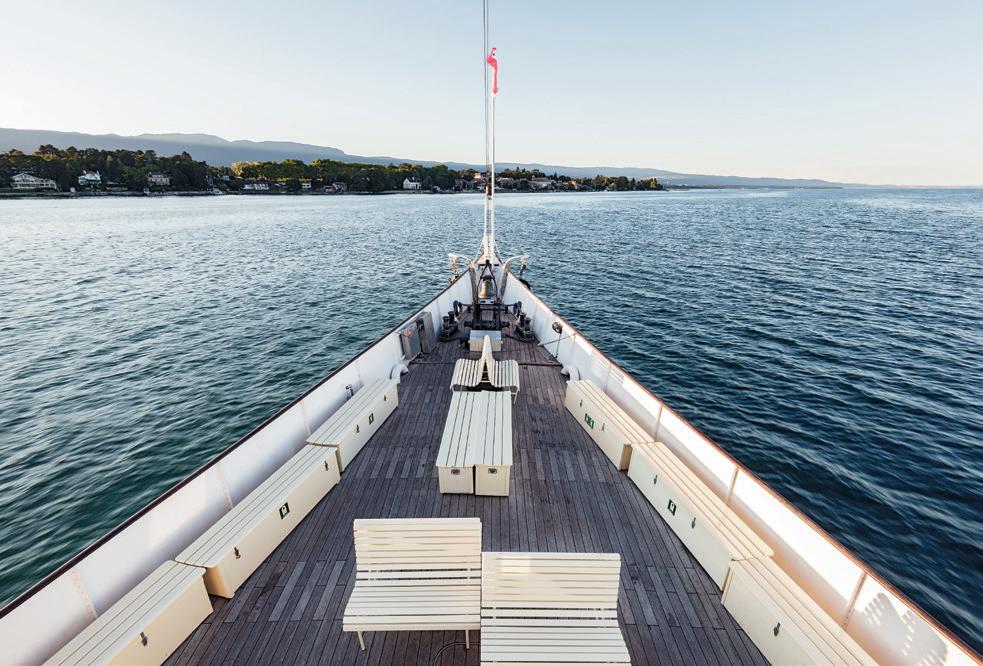
D/S Simplon
Wasserung: 1915 • Inbetriebnahme: 1920
Der «imposanteste» Dampfer der CGN
Teilrenovationen: 2004-2005, 2010-2011, 2017-2018.
Tragkraft: 850 Personen, 330 Sitzplätze für die Bordverpflegung
Länge: 78,5 M
Leistung: 1030 KW (1400 PS)
Besonderheiten:
• „Sistership“ (Zwilling) von der Helvétie (1926);
• Erster Dampfer auf dem Genfersee mit dem Heizkessel hinter den Schaufelrädern und der Maschine davor, die das Schiff nun „zieht“ statt „stösst“. Dadurch gewinnt man Platz auf dem Hauptdeck;
• Salon der 1. Klasse mit weissem Ahorn, der Letzte, der durch den bekannten Tischler Henry Bobaing in Lausanne angefertigt wurde
D/S Simplon hat den Ruf des „imposantesten“ Dampfers, mit der reaktivsten Dampfmaschine, der CGN zu sein und weist zudem die grösste Passagierkapazit der historischen Flotte auf. Kiellegung Ende Juli 1914, aber einige Tage später werden die Arbeiten wegen Ausbruchs des 1.Weltkriegs bereits wieder eingestellt. 1915 wird zwar noch die Dampfmaschine eingebaut aber nachher ruht Alles. Am Ende des Konflikts entscheidet die CGN, den Bau des Schiffs zu beenden und es in Betrieb zu nehmen, was endlich 1920 der Fall ist. 1959 wird auf Oelfeuerung umgestellt und 1968 erhält D/S Simplon neue Heizkessel.
Der Dampfer erfährt später noch zwei Teilrenovationen. Die erste 20042005 nach einem Schaden im Brennraum eines der beiden Kessel und die zweite 2010-2011 mit einer Generalüberholung der Dampfmaschine und dem Einbau eines Bugstrahlers. Während dem Winter 2017-2018 erhielt der Dampfer eine neue Aussenbemalung. n
D/S Simplon wird im Sommerfahrplan, vom 16. Juni bis zum 1. September, auf der Linie Genf-Lausanne und zurück eingesetzt, mit zusätzlicher „Pasta-Festival“ - Rundfahrt am Freitagabend ab Genf. Allerdings mit Ausnahme vom 18. Juli bis zum 11. August, wo der Dampfer M/S Vevey während der Fête der Vignerons in Vevey auf der Strecke Lausanne - Genf - Lausanne - Vevey - Montreux - Lausanne ersetzt oder Privatfahrten ausführt (siehe OGS - Fahrordnung auf www.cgn.ch oder www.abvl.ch).
Ersetzt vom 30. September bis zum 11. Oktober M/S Léman von Montag bis Freitag auf der Strecke Lausanne-Evian.
M/S Helvétie
1926 • Der dritte grosse Raddampfer der CGN
Seit 2002 ausser Dienst
Äusserliche Teilrenovation: 2011
Tragkraft: 850 Personen, 330 Sitzplätze für die Bordverpflegung
Länge: 78,5 M
Leistung: 1’100 KW
Besonderheiten:
• „Sistership“ (Zwilling) von D/S Simplon;
• Burgverzierung;
• Die Original-Dampfmaschine ist im Musée du Léman in Nyon ausgestellt.
Nach dem Ende des 1.Weltkrieges hofft man auf eine Neuauflage einer „Belle Epoque“. Die CGN bestellt im Jahre 1923 einen dritten grossen Dampfer der Kategorie von La Suisse und Simplon. 1975 haben seine Heizkessel ihr Lebensende erreicht, was mit der ersten Oelkrise und den damit verbundenen dramatisch erhöhten Treibstoffkosten zusammenfällt und die CGN beschliesst deshalb, Helvétie auf diesel-elektrischen Antrieb umzurüsten. Leider hat aber das eingebaute Occasions-Aggregat nie richtig funktioniert und das Schiff wurde je länger je mehr dem Reservedienst zugewiesen und schliesslich im Frühling 2002 stillgelegt.
Im Jahr 2011 erfolgt eine erste Teilrenovation des Schiffs, damit es zwischen 2012 und 2013 als „Ersatzmuseum“ während der Erneuerung des Musée Olympique in Ouchy eingesetzt werden kann. 2015 dient Helvétie der Ausstellung „100 Jahre IOK in Lausanne“ und befindet sich gegenwärtig in Erwartung seiner Totalrenovation (erhofft ab 2026, sein Hundert Jahre - Jubiläum)wieder in der CGN-Werft. n Ziel ist, das Schiff für sein Hundertjahr-Jubiläum 2026 einer Vollrenovation zu unterziehen, falls deren Finanzierung bis dann sichergestellt werden kann.

D/S Rhône
1927 • Letzter vollständig in der Schweiz gebaute Raddampfer
Vollrenovation: 2019-2020 Tragkraft: nach der Vollrenovation 600 Personen, 186 Sitzplätze für die Bordverpflegung
Länge: 68 M
Leistung: 625 KW (850 PS)
Besonderheiten:
• Automatische Schmierung unter Druck, womit die Pleuelstangen durch Hauben überdeckt werden müssen;
• Weltweit einzigartige Prototyp-Dampfmaschine;
• Neoklassischer Salon aus Kirschenholz;
• Relativ offenes Oberdeck mit kurzer Verglasung.
D/S Rhône wird zum ersten Mal im Jahre 1927 während der Fête des Vignerons eingesetzt. Seine Dampfmaschine wird 2002-2003 vollständig revidiert. ABVL finanziert dabei den Ersatz der Metall- durch Plexiglashauben, damit die Maschinenumdrehungen wie auf den anderen Dampfern für die Passagiere sichtbar werden. Gleichzeitig finanziert ABVL eine Teilrenovation des Mobiliars des 1. Klasse - Salons. Das relativ wenig verglaste Oberdeck wird von den Passagieren bei schönem Wetter geschätzt, ist aber bei schlechtem ein Nachteil. n
D/S Rhône ist seit November 2017 ausser Dienst, wird jetzt aber einer Vollrenovation unterzogen und im Frühling 2021 wieder in Dienst genommen.
Die Vollrenovation sollte folgende Auflagen erfüllen: Komplette Sanierung der Struktur;
• Renovierung des Antriebes mit Beibehaltung der Original-Dampfmaschine, Modernisierung der Hilfsaggregate und neuer und sparsamerer Kessel, damit das Schiff für mindestens 30 weitere Jahre kommerziell eingesetzt werden kann;
• Einhaltung der neuesten Sicherheitsvorschriften des Bundesamtes für Verkehr (BAV) und Verbesserungen für Personen mit beschränkter Mobilität; insbesondere besserer Brandschutz, zusätzliche Schottwände, einen Bugstrahler wie auf den anderen Dampfern, der das manövrieren erleichtert und sicherer gestalte; verbesserte Steuerung und modernere Navigationsgeräte;
• Verbesserung des Komforts und der Hygiene (modernere Küchen; Bordbuffets und Toiletten) und zweckmässigere Funktionalitäten;
• Wiederaufbau von Originalstrukturen und -formen gemäss den Empfehlungen der Denkmalschutz-Kommission falls dies mit einem modernen kommerziellen Einsatz des Schiffs vereinbar ist; alle Arbeiten sollen im Sinne der nachhaltigen Entwicklung ausgeführt werden, sei es für die Wahl der Materialien und der Entsorgung der alten.

➸ SEITE 32
ABVL braucht Ihre Unterstützung!
Seit 2002 kämpft die Association des amis des bateaux à vapeur du Léman / ABVL (Freunde der Dampfschifffahrt auf dem Genfersee) dafür, dass alle 8 Schaufelradschiffe der Belle Epoque Flotte der CGN wieder fahren können…
Nach beinahe 10 Jahren Stilllegung in Erwartung der Finanzierung seiner Generalrenovation ist Italie (1908) zu neuem Leben erwacht. ABVL hat dazu mit über 10 Mio SFr. beigetragen. Ende 2016 ist das Schiff zu den 6 anderen im Dienst stehenden Belle Epoque Raddampfern gestossen.
Obwohl diese Flotte unter nationalem Denkmalschutz steht und deshalb von einem Abbruch bewahrt ist, so erfordert ihr Unterhalt bedeutende Mittel und ein wesentlicher Teil davon muss durch private Unterstützung sichergestellt werden.
D/S Rhône, das letzte in der Schweiz gebaute Schaufelrad-Dampfschiff, wird gegenwärtig vollrenoviert. Der grösste Teil der Finanzierung erfolgt durch die drei Hauptaktionäre der CGN, nämlich durch die Kantone Waadt, Genf und Wallis. Die ABVL wird sich mit 3 Mio SFr. an der Finanzierung beteiligen, damit die Arbeiten im Mai 2019 beginnen können.
D/S Simplon sollte im Zeitabschnitt 2023-2025 noch seiner dritten und wichtigsten Teilrenovation unterzogen werden.
Schliesslich benötigt M/S Helvétie, seit 2002 stillgelegt, eine Vollrenovation. Das Hundertjahr-Jubiläum des Schiffs, im Jahre 2026, könnte dafür für ABVL eine Zielsetzung sein! n
Jede Spende zählt!
Helfen Sie uns und der CGN, den aufwendigen Unterhalt der prächtigen Belle Epoque - Schiffe mitzufinanzieren.
Werden Sie Gönnerin oder Gönner durch Ihre Spende.
IN DER SCHWEIZ
Die Schweizer Post — PCK 17-197675-0 — IBAN: CH61 0900 00001719 7675 0
IN DER SCHWEIZ UND AUS DEM AUSLAND DURCH BANKÜBERWEISUNG
In Schweizerfranken: UBS-Konto «ABVL»
IBAN: CH 62 002432434589 5701 H
In Euros: UBS-Konto «ABVL»
IBAN: CH 68 0024 3243 4589 5761 K
IN FRANKREICH
La Lyonnaise de Banque (Konto in Euros) – Konto 00032572501
IBAN FR76 1009 6182 2900 0325 7250 178 - BIC CMCIFRPP
Für Informationen über Legate kontaktieren Sie uns bitte (+41 (0)21 614 62 88 oder info@abvl.ch).
➸ SEITE 33
Freunde der Dampfschifffahrt auf dem Genfersee
Der Verein, mit Sitz in Lausanne, ist zu einem unumgänglichen Partner der Erhaltung der historischen Belle Epoque Flotte der CGN geworden.
Er wurde 2002 durch eine Handvoll engagierter Dampferfans gegrün-
det, als sich diese Flotte aus finanziellen Gründen plötzlich in Gefahr befand. ABVL zählt heute annähernd 4’000 aktive Mitglieder und 20’000 Gönner. Der Zweck des Vereins ist in Art. 1 seiner Statuten definiert: ABVL hat zum Zweck, durch finanzielle Unterstützung den Erhalt und den fahrplanmässigen Einsatz der acht Belle Epoque Schiffe der CGN, die da sind Montreux, Vevey, Italie, La Suisse, Savoie, Simplon, Helvétie und Rhône, zu fördern.
Dank den Spenden der Gönner der ABVL konnten die acht Belle Epoque - Schiffe der Compagnie Générale de Navigation sur le lac Léman (CGN) teilweise oder ganz renoviert werden. Bis zum heutigen Tag konnten über 35 Mio SFr. durch ABVL und ihre Stiftung Pro Vapore gesammelt und der CGN für bereits getätigte und kommende Renovationen zur Verfügung gestellt werden. Damit finanziert ABVL ca. ein Drittel der Gesamtkosten der Investitionen für die Erhaltung der historischen Flotte.
Durch ABVL finanzierte Renovationen
D/S Simplon (1920). Zwei Teilrenovationen 2003-2005 und 20102011. Sandstrahlung der Schale, Hauptrevision der OriginalDampfmaschine, Auffrischen der Salons der 1. und 2. Klasse auf dem Hauptdeck,Verbesserung des Oberdecks und Einbau eines Bugpropellers. Im Winter 2016-2017 wurden die beiden aus dem Jahr 1966 stammenden Kessel neu verrohrt.
D/S La Suisse (1910). Totalrenovation 2007-2009.
D/S Montreux (1904). Über mehrere Jahre Finanzierung der Weiterentwicklung der neuen Dampfmaschine (2001, Prototyp). Auffrischen des Salons der 1. Klasse im Winter 2014-2015. Der Dampfkessel wurde 2016 mit einem neuen Überhitzer ausgerüstet.
M/S Helvétie (1926). Finanzierung einer ersten Teilrenovation 20112012. Sandstrahlung der Schale und der Schaufelräder und Teilerneuerung der Aufbauten.
D/S Savoie (1914). 2011-2012 Hauptrevision der Original-Dampfmaschine.
M/S Vevey (1907). Finanzierung der Belle Epoque – Leuchter im Salon 1. Klasse im Jahre 2013.
M/S Italie (1908). ABVL stellte über 10,6 Mio SFr. für die mit 13,6 Mio budgetierte und im Mai 2015 begonnene und im Herbst 2016 beendete Generalrenovation zur Verfügung.
D/S Rhône (1927). ABVL beteiligt sich mit 3 Mio SFr. an der Vollrenovation 2019-2021, die mit SFr. 15’843’000.– veranschlagt ist (Mwst. inbegriffen) und hauptsächlich durch die drei Anrainerkantone Waadt, Genf und Wallis, Mehrheitsaktionäre der CGN, getragen wird. n
Die Stiftung Pro Vapore
Der Verein ABVL hat eine Stiftung mit Sitz in Genf gegründet, die statutarisch identische Ziele verfolgt und der die Spenden gutgeschrieben werden. Dank deren Stiftungsaufsicht haben unsere Gönnerinnen und Gönner die Garantie, dass diese auch zweckmässig eingesetzt werden. Der Verein und die Stiftung sind im Handelsregister eingetragen. n
Informationen: www.abvl.ch
Kontakt: ABVL – Avenue de Rhodanie17 – Postfach 60 – 1001 Lausanne info@abvl.ch – Tel. +41 (0)21 614 62 88 Fax +41 (0)21 614 62 89 https://www.facebook.com/vapeurleman
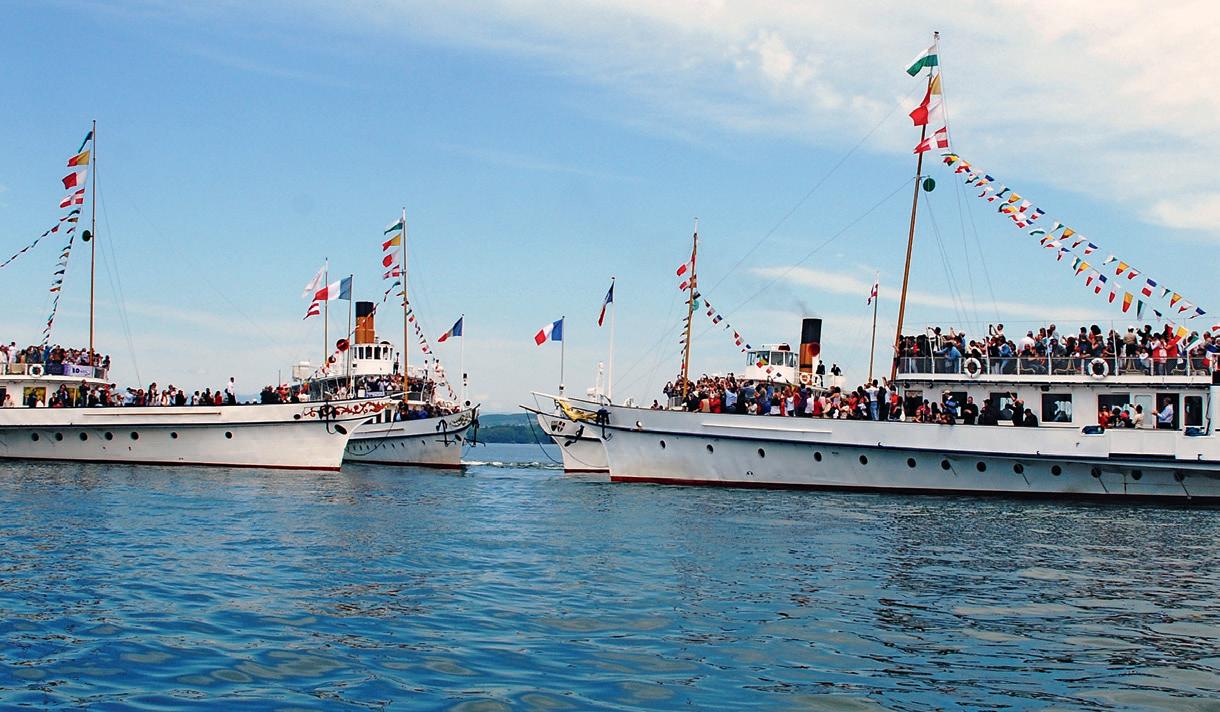

➸ SEITE 38
„Motivierte Mitarbeiter wie in einem Familienbetrieb - das gefällt mir“
Irwin Gafner ist seit November 2017 technischer Direktor und hat den Mitarbeitern seine Zukunftsvision für die CGN erklärt: Erneuerung der Flotte, optimale Einsatzbereitschaft aller Schiffe, nachhaltige Entwicklung.
Als Vorgesetzter der 120 Mitarbeiter, die in CGN - Technik tätig sind (siehe Artikel über die Werft), hat Irwin Gafner eine klare und ehrgeizige Vorstellung, wie es mit Schiffsgesellschaft weitergehen soll. Der pragmatische und wohlüberlegte Plan soll es der CGN erlauben, ihre führende Position auf dem Genfersee zu konsolidieren und ihr Wachstumspotential auszuschöpfen. Das Ganze im Sinne der nachhaltigen Entwicklung. Neue Schiffe, weitere Renovationen der historischen Flotte und Ausbau der Werft: der Ingenieur wird in den kommenden Jahren alle Hände voll zu tun haben.
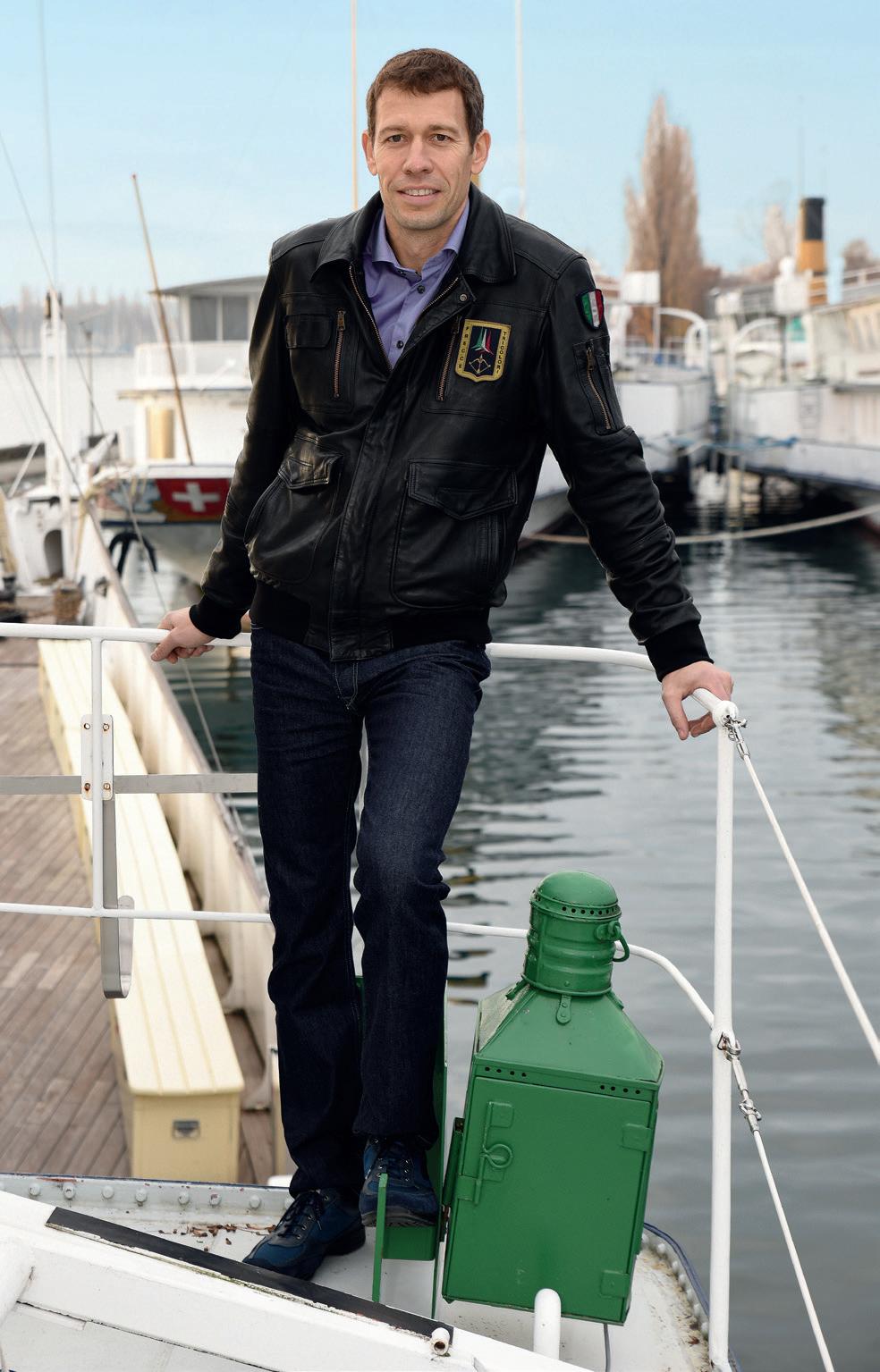
À TOUTE VAPEUR: Sie haben CGN - Technik höchst ehrgeizige Ziele gesteckt: erzählen Sie uns mehr darüber…
IRWIN GAFNER: Unsere Strategie verläuft auf drei Achsen: Erneuerung der Flotte, optimale Einsatzbereitschaft aller Schiffe, nachhaltige Entwicklung. Erstens, weil der grenzüberschreitende öffentlicheVerkehr enorm zugenommen hat, zweitens müssen wir die Renovationen der historischen, denkmalgeschützten und weltweit einmaligen Belle Epoque -Schiffe zu Ende führen und drittens wollen wir die OekoBilanz der gesamten Flotte noch verbessern.
Welches ist die grösste Herausforderung und wie wollen Sie diese anpacken?
Obwohl wir seit mehreren Jahren daran arbeiten, müssen verschiedene Schiffe der zeitgenössischen Flotte erneuert oder ersetzt werden. Einige sind über vierzig Jahre alt und erreichen heute ihre Grenzen bezüglich Leistungsfähigkeit und Kapazität. Zu unseren wichtigsten Projekten gehört daher der baldige Bau eines sogenannten “BMA“Schiffs – Bateau Moyen Accéléré – oder auf Deutsch ein mittelgrosses Schiff mit etwas erhöhter Fahrplan-Geschwindigkeit. Es wird eine Kapazität von 700 Personen haben, über 600 innere Sitzplätze verfügen und auf den Strecken des öffentlichen grenzüberschreitenden Verkehrs die dringend notwendige Verstärkung des Angebotes ermöglichen.
Wo wird dieses Schiff gebaut und ab wann kann es eingesetzt werden?
Das Schiff wurde in Zusammenarbeit mit unseren nationalen und internationalen Partnern in unseren Planungsbüros entwickelt. Zusammengebaut wird es in unserem gedeckten Trockendock. Es sollte im Frühling 2021 in Betrieb genommen und vorwiegend auf der meistfrequentierten Linie N1 Lausanne - Evian eingesetzt werden. Ein zweites gleiches Schiff könnte unmittelbar folgen und dann vorwiegend auf der Linie N2 Lausanne - Thonon die Kapazität erhöhen.
Was gefällt Ihnen insbesondere bei der CGN?
Die motivierten Mitarbeiter, wie in einem Familienbetrieb. Nachdem ich in drei internationalen grossen Firmen tätig war und Erfahrungen gesammelt habe, komme ich mit der CGN, ein schweizerisches Unternehmen überschaubarer Grösse, wieder auf meine Wurzeln zurück. Die einzigartigen historischen Schiffe restaurieren – gegenwärtig und bis im Winter 2020/2021 der stolze Dampfer Rhône – und in Betrieb zu halten, sowie gleichzeitig die zeitgenössische Flotte modernisieren, ist äusserst spannend und motivierend. n
INTERVIEW: THOMAS PFEFFERLÉ
Daten
1977
Geburt in Genf.
2001
Dipl. (Master) Masch-Ing. EPFL (ETH Lausanne).
2002
Erhält einen 2. Master als Ingenieur Verbrennungsmotoren durch die Ecole Nationale Supérieure du Pétrole et des Moteurs in Paris.
2002 - 2003
Arbeitet in den USA für eine Zuliefererfirma der Automobilindustrie.
2003 - 2005
Entwickelt das Laboratoire d’energétique industrielle der ETH Lausanne. Anschliessend dort Lehrbeauftragter bis 2017.
2005 - 2007
Firma Liebherr in Bulle. Entwickelt die Motoren der mobilen Kräne.
2008 - 2017
Firma Holcim (Zementwerke), Standort Eclépens, Leiter der Produktion. Deponiert ein Patent über die Reduktion der Stickstoff-Emissionen des Zementwerkes.
2017
Übernimmt im November die Direktion von CGN - Technik.

➸ SEITE 42
Blick in die Zukunft
In der Werft der CGN in Lausanne-Ouchy herrscht ein reger Betrieb. Verschiedene Berufsgruppen arbeiten eng zusammen, unterhalten und renovieren die bestehende Flotte und planen den Bau neuer Einheiten.
Wenn man sich an Bord eines Schiffs begibt denkt man nicht sofort daran, welche steten Anstrengungen die Mitarbeiter erbringen müssen, damit diese sicher und pünktlich eingesetzt werden können. CGNTechnik beschäftigt im Winter 120 Mitarbeiter, aber Viele davon sind im Sommer im Fahrdienst tätig.
Elektriker, Mechaniker, Dampf-Maschinisten, Metallspezialisten, Schreiner, Tischler und Maler arbeiten eng zusammen und stellen ihr Können dem Schiffsbau zur Verfügung.
Der Hangar im Süden wird vergrössert und um ein Stockwerk erhöht, in dem verschiedene Ateliers untergebracht werden können. Dies dank einem Kredit von 5 Mio SFr. der Hauptaktionäre der CGN, nämlich der Kantone Waadt, Genf und Wallis.
Die bestehende Flotte renovieren
Die grosse Halle im Norden beherbergt seit 50 Jahren das Trockendock und die Ateliers verschiedener Berufsgruppen. Es ist direkt mit dem Wasser des Hafenbeckens verbunden und kann bis 80 M lange Schiffe für den Unterhalt, die Renovationen oder gar den Neubau aufnehmen.
Im Jahre 2018 z.B. wurden die Schalen von M/S Valais (2005 gebaut, 30 M lang, 200 Passagiere) und M/S Léman (1990, 50 M lang, 600 Passagiere) nach neuesten Erkenntnissen modifiziert und durch einen Bugwulst sowie durch einen Tail-Duck ergänzt, was bis zu 20% Brennstoff-Einsparungen erbrachte. Dazu verursachen die beiden Schiffe nun auch kleinere Wellen.
Die Zukunft mitbestimmen
Im Trockendock formiert sich auch die Zukunft der CGN mit dem Bau eines grossen neuen Schiffs für den Berufsverkehr. 700 Passagiere und 600 Sitzplätze, moderner und sparsamer Hybrid-Antrieb und eine Schale, mit der man auch mit 2 M hohen Wellen noch fahren kann. Dies dank einem anderen Kredit von ca. 15 Mio SFr., der wieder von den drei Anrainerkantonen und dazu auch von den betroffenen Gemeinden der französischen Südküste im letzten Jahr bewilligt wurde. Das Schiff sollte im Frühling 2021 in Betrieb genommen und zwischen Lausanne und Evian eingesetzt werden, womit neu auf dieser Linie ein 45 Minuten - Taktfahrplan angeboten werden kann. Die CGN beabsichtigt in den komenden Jahren weitere solche Einheiten anzuschaffen, um den Teil ihre Flotte, die den öffentlichen Verkehr ausführt, zu verstärken.
Talente anziehen
Herr Irwin Gafner, Direktor von CGN - Technik seit Ende 2017 (siehe Interview Seite 83), ist stets auf der Suche nach qualifizierten Mitarbeitern, die den hohen Anforderungen des Schiffsbaus genügen. Erwähnt sei auch, dass die CGN neuerdings mit der ETH Lausanne zusammenarbeitet. Entlang der Werftmole testet diese mit ihren Studenten Prototypen von Schiffsmodellen und Antrieben. Innovative Ideen, von der später die Wirtschaft profitieren wird. n THOMAS PFEFFERLÉ

➸ SEITE 50
Die Inseln des Genfersees
Im grössten See Westeuropas befinden sich fünf Inseln. Einige sind dem Publikum zugänglich, andere nicht. Jede hat ihre eigene Geschichte. Wir erzählen darüber.
Ile de Peilz, die „königlichste“
Wo: vor Villeneuve
Oberfläche: 20 - 77 M2, je nach Urkunde
Besitzer: die Gemeinden Villeneuve und Noville
Zugang: öffentlich, frei
Vor der Küste von Villeneuve befindet sich die kleinste Insel des Sees, die bereits Lord Byron (1816), Autor von Le Prisonnier de Chillon (der Gefangene von Schloss Chillon) inspirierte.Teilweise durch die Rhône Mündung aufgeschüttet, wurde sie im 18. Jh mit Gesteinsblöcke verfestigt.Viele Legenden entstanden über diese Insel. Ihr Hauptmerkmal ist eindeutig die 168 Jahre alte Platane im Zentrum der Insel, die sie prägt und symbolisiert.
Ile de La Harpe, die grösste
Wo: Rolle, vor dem Hafen
Oberfläche: 2368 M2
Besitzer: die Gemeinde Rolle
Zugang: öffentlich, frei
Circa 1835 entstand das Projekt, eine Insel als Wellensperre vor dem Hafen zu errichten, von dem das Holz aus dem Jura auf dem Seeweg nach Genf befördert wurde. 1838 wurde sie zu Ehren des in diesem Jahr verstorbenen Frédéric-César de la Harpe auf dessen Namen getauft. Wer war dieser illustre Bürger? Rechtsanwalt und Politiker des Kantons Waadt, war er auch während elf Jahren Steuereinzieher von Tsar Alexander der I. in Russland! Er war auch ein Inspirator der Waadtländer Revolution und zwei markante Ereignisse prägten seine
Karriere: 1798 forderte er Frankreich auf, den Kanton von Bern zu befreien und 1813 die Siegermächte Napoleons, die Schweiz selbstständig über ihr Schicksal entscheiden zu lassen.
Ile de Salagnon, die meistphotographierte
Wo: Clarens-Montreux, vor dem Hafen von Basset
Oberfläche: 1120 M2
Besitzer: Privat
1880 fand man hier nur ein paar Gesteinsbrocken. Im Zusammenhang mit dem Bau der Eisenbahnlinie von Saint-Gingolph nach Evian wurden von dort mit Segelbarken evakuierte Steine hineingeschüttet und die Insel entstand. 1889 erhielt sie den Namen „Salagnon“ in Anlehnung einer diesen Barken. 1900 kaufte der französische Maler Théobald Chartran die Insel und errichtete darauf eine Villa im florentinischen Stil. Sie gehört heute noch zu den meistphotographierten Villen weltweit! Nach dem Tod 1907 von Théobald Chartran war sie nacheinander im Besitz eines russischen Fürsten, der Amerikanerin Mary Shillito und, ab 1947, des zürcherischen Geschäftsmanns Ernst Pflüger und schliesslich heute dessen Sohns Ernst Bernhard. Die Insel und die Villa stehen unter Denkmalschutz und sind von nationaler Bedeutung.
Ile de Choisi, die geheimste
Wo: vor Bursinel
Oberfläche: 150 M2
Besitzer: Privat
70 M von der Küste entfernt sei es die älteste Insel des Genfersees. Doch man hat nur ganz wenige Informationen über ihre Geschichte. Man weiss weit mehr über das Anwesen Choisi, das 10% der Fläche der Gemeinde Bursinels beansprucht. Das Gut ist in Privatbesitz und beherbergt auch ein Schloss und eine Meistervilla. Die Besitzer möchten anonym bleiben, was wir respektieren. Erwähnt sei aber, dass Winston Churchill 1946 das Gut Choisi besuchte.
Ile Rousseau, die meistbesuchte
Wo: in Genf
Oberfläche: 1680 M2
Besitzer: die Stadt Genf
Zugang: öffentlich, frei
Im Zentrum der Stadt gelegen, stellt sie ein Stück Natur mitten in der Rhône die sie umfliesst, dar. Ihre Ruhe und Romantik ist aber relativ neu. Sie wurde 1585-1588 gebaut, war strategisch gelegen, kontrollierte den Zugang zum Hafenbecken und gehörte auch zum Schutzwall der Stadt. Dazu wurden auf ihr ab 1587 die Schiffe der Regierung gebaut und unterhalten. Sie diente auch als Pulverdepot und sogar als Ort der Quarantäne für Güter mit Seucheverdacht. 1832 wurde die Insel mit der Brücke Pont des Bergues verbunden, zur Promenade umgebaut und 1835 auf den Namen des Genfer Philosophen getauft. Man pflanzte auf ihr italienische Pappeln und Trauerweiden. 2012 wurde sie aus Anlass der Geburt vor 300 Jahren von Jean-Jacques Rousseau stark aufgefrischt und zu einer Gartenanlage umgebaut. n JOËLLE LORETAN

➸ SEITE 56
Der Genfersee und das Klima 10 beachtenswerte Punkte
Den See bewundern, darin zu schwimmen oder darauf zu navigieren – wir glauben Alles über den Genfersee zu wissen. Und doch hat er uns noch viele wichtige Punkte zu erzählen!
1) Zuerst war ein Gletscher Die Wissenschaftler sind sich noch nicht einig über das Wie und Wann der Entstehung des grössten Sees der Alpen Europas. Aber die geläufigste Theorie ist, dass das Seebecken durch die Bewegungen des Rhônegletschers während den verschiedenen Eiszeiten ausgehoben wurde. Der See wäre dabei erstanden, als sich der Gletscher vor ca. 15’000 Jahren zurückzog. Heute liefert ihm die Rhône 75% ihres Wassers.
2) Der Genfersee hat bereits verschiedene extreme Wetterphänomene erlebt
Wie zum Beispiel der Tsunami im Jahre 563. Eine 13 M hohe Welle erreichte Lausanne und eine 8 M hohe Genf nach einem massiven Bergsturz.Wobei die Felsen nicht direkt in den See stürzten, sondern in das Rhône-Delta, das seinerseits dann enorme Geröllmassen in den See drückten und die riesige zerstörerische Welle auslöste.
3) Der Pegelstand des Sees bleibt stabil
Der Pegelstand wird gegenwärtig durch das Abschmelzen der Gletscher und dem Austrocknen verschiedener Flüsse beeinflusst, was sich häufig mehr oder weniger kompensiert und eine Folge des Klimawandels ist. Obwohl sich sehr trockene Sommer in den letzten Jahren häuften, blieb der Pegelstand praktisch stabil. Die Grösse des Sees trug sicher auch dazu bei (582,4 Km2, 72,8 Km lang und bis 308,99 M tief). Kleinere Seen haben demgegenüber unter dieser Situation stark gelitten.
4) Der See erwärmt sich
Die internationale französisch-schweizerische Kommission CIPEL, die die Qualität des Wassers des Sees und der Rhône mit ihren Zuflüssen überwacht wie auch dessen Temperatur, hat einen Anstieg von 2° C während den letzten 46 Jahren festgestellt. Von 10,9 °C in 5 M Tiefe 1970 zu 12,9 °C 2016. Der Saibling zum Beispiel laicht normalerweise zwischen 50 und 100 M Tiefe und 8° CWassertemperatur. Die Laichzeiten im Jahr verschieben sich nun mit der Erwärmung des Wassers und die vorgeschriebenen Fangperioden müssen angepasst werden.
5) Der See steht unter dem Druck der Mikroverunreinigungen
Er gilt als sauber aber man muss wachsam bleiben und die CIPEL wird 2020 einen neuen Aktionsplan vorlegen. Im Visier: die Mikroverunreinigungen, die zu klein sind, um von den Filtern der Kläranlagen aufgefangen werden zu können. Sie stammen aus Medikamenten und phytosanitärischen Produkten, sowie von Haushalten, der Industrie und dem Ackerbau.
6) Die Plage der Plastikschwemme Der Genfersee ist leider auch nicht davon verschont. Die ASL -eine Vereinigung, die den Schutz des Wassers des Sees zum Ziel hat- hat kürzlich veröffentlicht, dass nach ihrer Schätzung jährlich 50 T Plastik in den See gelangen. Diese stellen eine Gefahr für die ganze Nahrungskette dar. Es gibt verschiedene Kategorien von Plastik: auf der einen Seite das Mikroplastik bis zu 5 Mm und das Nanoplastik von weniger als 0,001 Mm. Das Zweite kann von den Kläranlagen nicht erfasst werden. Schliesslich das Makroplastik über 5 Mm, das problemlos eingefangen werden kann. Die ASL organisiert regelmässig „Putztage“ mit bis zu 1000 Freiwilligen, die zum Beispiel letztes Jahr 5,5 T Abfall verschiedenster Art aus dem See geholt haben.
7) Die Phosphate stellen keine Gefahr mehr dar In den Achtzigerjahren stellten die Phosphate die grösste Gefahr dar. Sie waren die Hauptursache der Eutrophierung (Mangel an Sauerstoff) des Sees, die von der CIPEL seit ihrer Gründung im Jahre 1962 bekämpft wird. Mit Erfolg: mass man doch vor 1960 weniger als 15 Mg/L, so waren es 1979 89,5 Mg (!) und nun, im Jahre 2017, erfreuliche 18 Mg/L. Nicht ganz genügend, aber der See ist diesbezüglich auf gutem Weg.
8) In der Tiefe des Sees fehlt der Sauerstoff
In der Tiefe sollte man mehr als 4 Mg/L Sauerstoff messen, damit das aquatische Leben möglich bleibt. Dafür muss sich das Seewasser regelmässig „umwälzen“. Dieses Phänomen ereignet sich leider immer weniger. Im Winter 2016-2017 zum Beispiel geschah dies wegen der Grosswetterlage nur teilweise bis in 190 M Tiefe. Damit bleibt es darunter zu sauerstoffarm.
9) Ein wärmerer See = mehr Sonnenschein und weniger Stratuswolken?
In den letzten Jahren hat Meteo Schweiz tatsächlich im Winter weniger Stratuswolken und mehr Sonnenschein festgestellt. Der Zusammenhang mit dem Klimawandel ist zwar wahrscheinlich, aber noch nicht klar erwiesen. Sicher ist aber, dass sich trockene und heisse Perioden häufen und das Jahr 2018 das Wärmste seit Messbeginn vor 150 Jahren war.
10) Der See funktioniert als Heizung und als Klimaanlage Auf natürliche Weise zuerst, weil er im Winter die im Sommer gespeicherte Wärme abgibt und damit die Regionen in Seenähe vor Kälte schützt und im Sommer diese umgekehrt etwas abkühlt. Dazu kommen bald grössere hydrothermische Anlagen, wo man das Wasser in 45 M Tiefe erfasst, zusätzlich zu zahlreichen individuellen Wärmepumpen. So zum Beispiel in Genf, wo das bestehende System Genève Lac Nations,
nämlich die thermische Regulierung der Gebäude der Internationalen Organisationen im Quartier Nations, bis 2021 durch das Projekt „Genilac“ ergänzt wird, mit dem man die Gebäude der Einkaufszentren und Wohnungen des Stadtzentrums dann heizen kann. 2022 sollte das Netzwerk bis zum wichtigen Standort des Flughafens, mit seiner grossen Infrastruktur, ausgedehnt sein. Man rechnet damit, die CO2Emissionen um 25% senken zu können. Erwähnt sei schliesslich, dass die Temperaturen des in den See zurückgeführten Wassers dem natürlichen Umfeld entsprechen, nämlich ca. 3° C im Winter und 15° C im Sommer, was mit den Bedürfnissen der Fauna und der Flora kompatibel ist. n
SYLVIE ULMANN

Fête des Vignerons –Ein epochales Ereignis
Das Fête des Vignerons (Winzerfest) ist nicht nur eine grandiose Vorstellung, sondern auch ein grosses populäres Fest, das die Stadt Vevey vom 18. Juli bis zum 11. August erfreuen wird. Es figuriert seit 2016 zum Immateriellen Kultur-Welterbe der UNESCO, neun Jahre später als das Weinbaugebiet Lavaux nebenan, das seit 2007 zum materiellen Welterbe gehört.
Anfang 2019 schrieb die bekannte Tageszeitung NewYork Times, dass die Stadt Vevey zu den 52 Destinationen zählt, die man in diesem Jahr besuchen sollte. Warum? Eben wegen dem Fête des Vignerons, das nur drei- bis viermal pro Jahrhundert stattfindet und im kommenden Sommer Hunderttausende von Besuchern, die den Weinbau und den damit verbundenen Lebensstil bewundern, anziehen.
Diese 12. Ausgabe des Winzerfests verspricht noch spektakulärer zu werden.Vevey wird während einem Monat zur Hauptstadt der Schweiz, insbesondere auch, weil zum ersten Mal jeder Kanton seinen „Tag“ haben wird.
Die Geschichte des Winzerfestes
Die ersten Spuren findet man vermutlich im 17. Jh. Damals beendeten die Bruderschaft der Winzer ihre Jahresversammlungen mit einer Parade aus den Höhen Veveys bis zum See hinunter, wo ein Bankett auf die Teilnehmer wartete. Das fröhliche Fest wuchs und wuchs und damit aber auch die Kosten, und so fand es dann nur noch alle drei Jahre, später gar alle sechs Jahre, statt. Die letzte Parade fand 1791 statt. Das erste Fête des Vignerons wurde dann vor 2’000 Zuschauern auf Tribünen der Place du Marché (Marktplatz) im Jahre 1797 zelebriert. Anschliessend wird das Winzerfest (wie heute) nur noch einmal pro Generation durchgeführt. 1889 befanden sich bereits 12’000 Personen auf den Tribünen, 1955 16’000 und dieses Jahr werden es 20’000 pro Vorstellung sein.
Von 3 bis 86 Jahren
Die Regie wurde Herrn Daniele Finzi Pasca anvertraut. Der Tessiner war u. A. für den Cirque du Soleil und den Cirque Eloize tätig und inszenierte die Schlusszeremonien der Olympischen Winterspiele in Turin im Jahre 2006 und in Sotchi 2014. Für das Fête des Vignerons erdachte er die Geschichte eines Grossvaters mit seiner Enkelin, die die verschiedenen Jahreszeiten durchwandern. Das Kind entdeckt dabei die Geheimnisse, die es mit seinem Grossvater und unserer Erde verbinden.

Dieses poetische und spielerische Szenario findet in einer riesigen Arena in der Form eines Nestes statt. Die zentrale Hauptbühne umfasst 1’400 m2 und wird durch vier erhöhte Nebenbühnen von 300 m2 ergänzt. 700 T Gerüste wurden für den Bau der gigantischen Struktur benötigt. 5’400 Schauspieler und vor allem Statisten von 3 bis 86 Jahren treten auf, zwei Drittel davon zum ersten, aber Dreissig davon bereits zum vierten Mal. Ein Höhepunkt der Aufführung ist immer der von elf Amateur-Tenoren gesungene Kuhreihen Ranz des vaches. Dieser ist derart populär, dass er fast zur Nationalhymne erkoren wurde!
Weit mehr als ein Schauspiel
Das Fête des Vignerons in Vevey ist also auch ein grosses Volksfest, wo viele Strassen zu Fussgängerwegen werden. 20’000 zusätzliche Besucher werden täglich erwartet. Über fünfzig Stände mit Nahrung und Trunk, acht temporäre Restaurants und davon eines mit Chef-Köchen, ein „Weltdorf“ und ein Nachtklub empfangen die Gäste. Im Süden der Arena befindet sich die „Terrasse der Bruderschaft“, wo mit Sicht auf den See und den Savoyeralpen regionaltypische Produkte angeboten werden. Die Kinder kommen nicht zu kurz: Märchenerzähler, Manege, Clowns und ein Grosses Rad erwartet sie im „Jardin Doré“. Die zum ersten Mal organisierten „Tage der Kantone“ erlauben diesen, ihre kulturellen, gastronomischen und weinbautechnischen Traditionen zu präsentieren. n MÉLANIE BLANC
Mehr Informationen auf www.fetedesvignerons.ch
Die CGN ist Partnerin für das touristische Angebot
Die nur ein paar Schritte entfernte Landestelle erlaubt es, das Fest mit den Schiffen der CGN ideal zu erreichen. Zusätzlich zu den zahlreichen Fahrplankursen wird eine tägliche Sonderfahrt hin und zurück mit Bordverpflegung ab Lausanne, auf den Zeitplan des Schauspiels abgestimmt, angeboten.
Für die Abendvorstellungen auch eine ab Le Bouveret. Reservation obligatorisch.
Tarife Lausanne - Vevey für die Sonderfahrt
Hin und Zurück: SFr. 39.–
Einfache Fahrt: SFr. 23.–
1/2 - Tarif nur für Kinder von 6-16 Jahren, unter 6 Jahren gratis Informationen und Reservation auf www.cgn.ch/fevi oder via Infoline 0900 929 929 (50 Rp./Min) ab einem Anschluss in der Schweiz
MAXI TIME! SOLUTIONS DES JEUX (Page 69)
Fête des Vignerons 2019 (Winzerfest 2019 in Vevey)
Am „Tag der Eidgenossenschaft“ von Donnerstag, den 1. August ermöglichen Ihnen ABVL und CGN, 2 x 5 „Premium“-Eintrittskarten
im Wert von total 3’600 SFr. zu gewinnen indem Sie folgende Frage beantworten:
Wann fand die Fête desVignerons zum ersten Mal statt ?
Ihre Antwort übermitteln Sie: INTERNET: www.abvl.ch/concoursFEVI2019
POST: ABVL, Wettbewerb FEVI2019, Postfach 60, 1001 Lausanne (mit Angabe von Namen und Vornamen, Adresse, Tel.-Nr. und E-Mail)
Teilnahmebedingungen
Einsendung zwischen Sonntag, 14. April 12 h 00 und Dienstag, 2. Juli 12 h 00. Mindestens 18 Jahre alt und wohnhaft in der Schweiz sein CGN und ABVL behalten sich vor, die Personalien der Gewinner bekanntzugeben und den Wettbewerb für Marketing- und Werbezwecke zu verwenden. Jede Person darf nur einmal am Wettbewerb teilnehmen. Die Preise sind nicht übertragbar und dürfen nicht weiterverkauft werden. Der/die Gewinner/in wird persönlich kontaktiert. Die Auslosung kann gerichtlich nicht angefochten werden.

Veranstaltungen und Themenfahrten
➸ SEITE 72
Dampferparade 2019
Dieses Jahr findet die Dampferparade der CGN in Rolle statt. Das Schloss der Stadt, die Quaianlagen und die Ile de la Harpe sehen die Belle Epoque - Flotte vorbeiziehen, ein weltweit einzigartiges Kulturgut. Die Dampferparade ermöglicht es nur einmal im Jahr, die im Fahrplan eingesetzten sechs Schaufelradschiffe, die im letzten November für ihre Salons der 1. Klasse mit dem Preis „Historisches Restaurant des Jahres 2019“ ausgezeichnet worden sind, zusammen zu bewundern. An Land sorgen verschiedene Stände für zusätzliche Unterhaltung und das leibliche Wohl der zahlreichen Gäste. Punkt 14 h beginnt das Ballett der sechs Schiffe unter dem Kommando des 1. Kapitäns Herr Olivier Chenaux. n
n JANUAR
6/01 ➜ 7/04
“Frühstücksrundfahrt”
Jeden Sonntag zwischen Lausanne und Evian.
Reservation erforderlich: www.cgn.ch
Tel. +41 (0)900 929 929 (Fr. 0.50/min.)
n FEBRUAR
1/02 ➜ 31/05
Fondue-Abendrundfahrten (Käse-Fondue oder “Fondue Chinoise“)
Jeden Freitag ab Genf, Morges, Lausanne, Evian und Thonon.
Reservation erforderlich: www.cgn.ch
Tel. +41 (0)900 929 929 (Fr. 0.50/min.)
n MÄRZ
16/03
Sankt Patrick – Rundfahrt
Ab Lausanne mit Spezialitäten aus Irland.
Reservation erforderlich: www.cgn.ch
Tel. +41 (0)900 929 929 (Fr. 0.50/min.)
n APRIL
14/04
Beginn des Frühlingsfahrplans
19/04 ➜ 22/04
Ostern
Rundfahrten mit köstlicher Bordverpflegung. Ab Genf an Bord D/S Simplon und Savoie, in Lausanne an Bord D/S La Suisse und im Haut-Lac Supérieur an Bord M/S Italie mit vielen Zwischenhalten.
Reservation erforderlich: www.cgn.ch
Tel. +41 (0)900 929 929 (Fr. 0.50/min.)
27/04
ABVL - Statutarische Generalversammlung
Im Gemeindesaal in Nyon mit anschliessender Mittagsrundfahrt an Bord D/S Simplon. www.abvl.ch
Cache-cache C’est Tim!
Find me! It’s Tim!
Sept différences
Catch the differences
28/04
“Jass-Rundfahrt”
An Bord M/S Henry-Dunant ab Genf.
Reservation erforderlich: www.cgn.ch
Tel. +41 (0)900 929 929 (Fr. 0.50/min.)
n MAI
5/05
Tag der Schifffahrt
Auf allen Schiffen zu einem Vorzugspreis.
12/05
Muttertag
Gönnen Sie Ihrer Mutter eine Gourmet - Mittagsrundfahrt!
Reservation erforderlich: www.cgn.ch
Tel. +41 (0)900 929 929 (Fr. 0.50/min.)
19/05
Dampferparade in Rolle
Sechs Belle Epoque - Radschiffe laden zum Ballett. Ab 14 h 45 in grosser Nähe der Küste. Zahlreiche Attraktionen auf den Quai-Anlagen.
Reservation erforderlich für die Borderpflegung, ohne ebenfalls erwünscht: www.cgn.ch
Tel. +41 (0)900 929 929 (Fr. 0.50/min.)
23/05 ➜ 13/06
Raclette-Rundfahrt
Dienstag und Donnerstag an Bord D/S La Suisse
Reservation erforderlich: www.cgn.ch
Tel. +41 (0)900 929 929 (Fr. 0.50/min.)
23/05 ➜ 21/09
Gourmet - Abendrundfahrt
An Bord D/S Savoie ab Genf.
25/05
“Tango-Abendrundfahrt”
Ab Genf. Ihr Rythmus verbindet sich mit dem Wellengang.
26/05
“Jass-Rundfahrt”
An Bord M/S Général-Guisan ab Lausanne.
Reservation erforderlich: www.cgn.ch
Tel. +41 (0)900 929 929 (Fr. 0.50/min.)
29/05
MAD Boat
Bis zu 1’000 Partygänger amüsieren sich an Bord. www.madclub.ch
7/06
Generalversammlung der CGN - Aktionäre SwissTech Convention Center der ETH Lausanne
15/06
Bol d’Or Mirabaud
Verrpassen Sie diese mythische Regatta nicht! Mit 600 daran teilnehmenden
Segelbooten ist sie die bedeutendste der Welt auf einem Binnensee. www.boldormirabaud.com
16/06
Beginn des Sommerfahrplans
16/06 ➜ 01/09
“Afterwork” – Rundfahrten
Geniessen Sie eine Feierabend-Rundfahrt unter Freunden und Kollegen. In Genf täglich. In Lausanne, am Dienstag, Mittwoch und Donnerstag an Bord M/S Vevey (vom 18/7 bis 8/8 im Prinzip an Bord D/S Simplon)
Reservation erforderlich: www.cgn.ch
Tel. +41 (0)900 929 929 (Fr. 0.50/min.)
16/06 ➜ 01/09
“Zu Tisch mit dem Beau-Rivage Palace” Von Dienstag bis Samstag, eine 5-Stern gastronomische Abendrundfahrt von Lausanne nach Yvoire und zurck an Bord D/S Montreux www.cgn.ch
21/06 ➜ 30/8
“Filets de perche” - Rundfahrt Freitags, mit Ausnahme während der Fête des Vignerons vom 18/07 bis 11/08.
22/06
Love Boat
Einen Abend lang wird M/S Lausanne zum Nachtklub mit einer unvergeslichen Atmodsphäre! www.love-boat.ch
29/06
450 Jahre französisch-schweizerische Freundschaft in Saint-Gingolph Das Fest findet auf den Quai-Anlagen von Saint-Gingolph statt. Dazu Rundfahrten an Bord M/S Italie, eine Parade der grossen Segelbarken, Stände und Unterhaltungen. www.450ans.st-gingolph.com
28/06 ➜ 13/07
Montreux Jazz Boat
Das Montreux Jazz Festival bietet Ihnen verschiedene thematische Rundfahrten an Bord der stolzen M/S Lausanne an. www.montreuxjazzfestival.com
11/07 + 31/07
MAD Boat
Der Klub MAD organisiertt seit über zehn Jahren beschwingte Nachtrundfahrten auf hoher See. Bis zu 1000 Partygänger nehmen daran jeweils teil. www.madclub.ch

14/07
Feuerwerk - Rundfahrt
Französischer Nationalfeiertag
Die Rundfahrt führt Sie in die Nähe von Evian und Sie haben eine prächtige Aussicht auf das erste Feuerwerk der Saison.
Reservation erforderlich: www.cgn.ch
Tel. +41 (0)900 929 929 (Fr. 0.50/min.)
18/07 ➜ 11/08
Mt dem Schiff zur Fête des Vignerons 2019 Das Fest beginnt bereits bei der Abfahrt. Mit dem Schiff gelangen Sie mitten ins Herz des Festplatzes!
Reservation obligatorisch. www.cgn.ch/de/fevi
Tel. +41 (0) 900 929 929 (Fr. 0.50/min.)
31/07
Feuerwerk - Rundfahrt in Le Bouveret
Am Vorabend des Nationalfeiertages an Bord M/S Italie, mit Aussicht auf die Alpen.
Reservation erforderlich: www.cgn.ch
Tel. +41 (0)900 929 929 (Fr. 0.50/min.)
n AUGUST
1/08
Schweizerischer Nationalfeiertag
An Bord unseres Flaggschiffs D/S La Suisse geniessen Sie eine Gourmet-Abendrundfahrt bevor das Schiff vor Lausanne hält, um das dortige Feuerwerk aus nächster Nähe zu betrachten.
Reservation erforderlich: www.cgn.ch
Tel. +41 (0)900 929 929 (Fr. 0.50/min.)
10/08
Feuerwerk-Rundfahrt während den Fêtes de Genève
Ein einmaliges, von Musik begleitetes Erlebnis!
Reservation erforderlich: www.cgn.ch
Tel. +41 (0)900 929 929 (Fr. 0.50/min.)
15/08
Feuerwerk-RundfahrtGedenktag Befreiung Evians
Verpassen Sie nicht das letzte Feuerwerk des Jahres, wie das Erste wieder vor Evian!
Reservation erforderlich: www.cgn.ch
Tel. +41 (0)900 929 929 (Fr. 0.50/min.)
31/08
Paradise Boat
Nochmals wird M/S Lausanne zum Tanzboot auf Hoher See. www.paradise-event.ch
2/09
Beginn des Herbstfahrplans
3/09 ➜ 19/09
“Raclette”-Rundfahrt
Dienstag und Donnerstag an Bord D/S La Suisse
Reservation erforderlich: www.cgn.ch
Tel. +41 (0)900 929 929 (Fr. 0.50/min.)
5/09
Herbstmesse in Thonon
Mit einer Sonderfahrt der CGN erreichen Sie diese bekannte Herbstmesse spielend.
6/09
Jungesellen-Rundfahrt
In Zusammenarbeit mit celibataire.ch. Finden Sie die grosse Liebe an Bord D/S La Suisse. Ab Lausanne.
14/09 + 15/09
Zwei Tage der OffenenTüren
Während den Europäischen Tagen des Denkmalschutzes, in der CGN-Werft in Lausanne, mit D/S Rhône in Generalrenovation im Trockendock.
27/09 ➜ 13/12
“Fondue”-Abendrundfahrten
Jeden Freitag ab Genf, Morges, Lausanne, Evian und Thonon.
Reservation erforderlich: www.cgn.ch
Tel. +41 (0)900 929 929 (Fr. 0.50/min.)
n OKTOBER
12/10 + 19/10
“Oktoberfest” – Rundfahrt Ab Lausanne am 12. und ab Genf am 19. Oktober in echter bayrischer Atmosphäre.
Reservation erforderlich: www.cgn.ch
Tel. +41 (0)900 929 929 (Fr. 0.50/min.)
21/10
Beginn des Winterfahrplans
21/10 ➜ 14/12 “Frühstücksrundfahrten”
Jeden Sonntag zwischen Lausanne und Evian. Reservation erforderlich: www.cgn.ch
Tel. +41 (0)900 929 929 (Fr. 0.50/min.)
n NOVEMBER
8/11 ➜ 17/11
Weinschiff der Coop in Lausanne An Bord M/S Lausanne. www.coop.ch/les-rois-du-vin
n DEZEMBER
25/12 + 29/12 + 1/01 + 2/01/2020
Jahresabschluss – Mittagsrundfahrten
Mit einem Galamenu an Bord während den Mittagsrundfahrten.
Reservation erforderlich: www.cgn.ch
Tel. +41 (0)900 929 929 (Fr. 0.50/min.)
31/12
Sylvesterrundfahrten
Feiern Sie den Jahreswechsel an Bord der CGN - Schiffe!
Reservation erforderlich: www.cgn.ch
Tel. +41 (0)900 929 929 (Fr. 0.50/min.)

